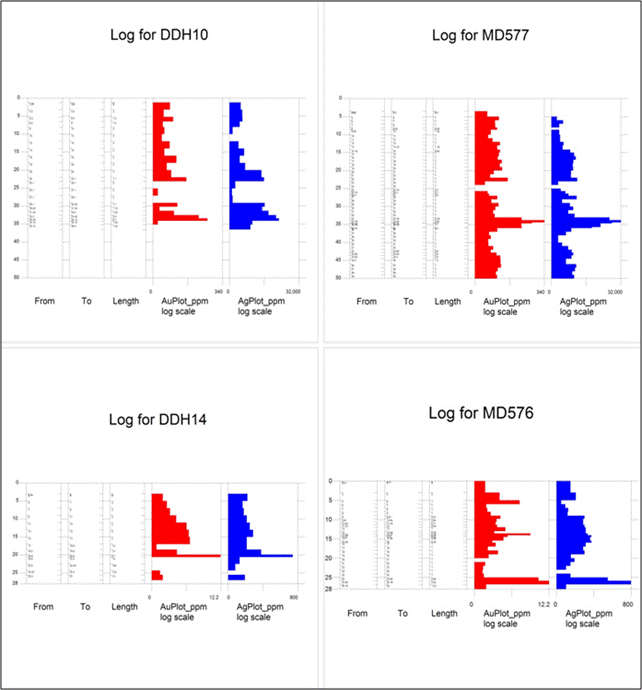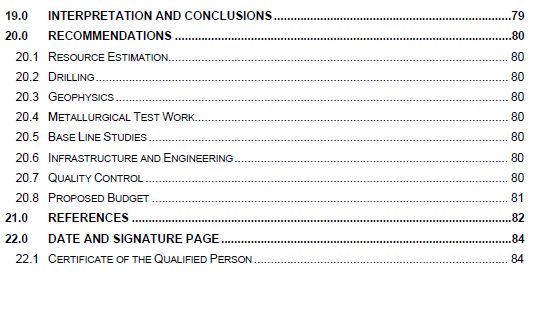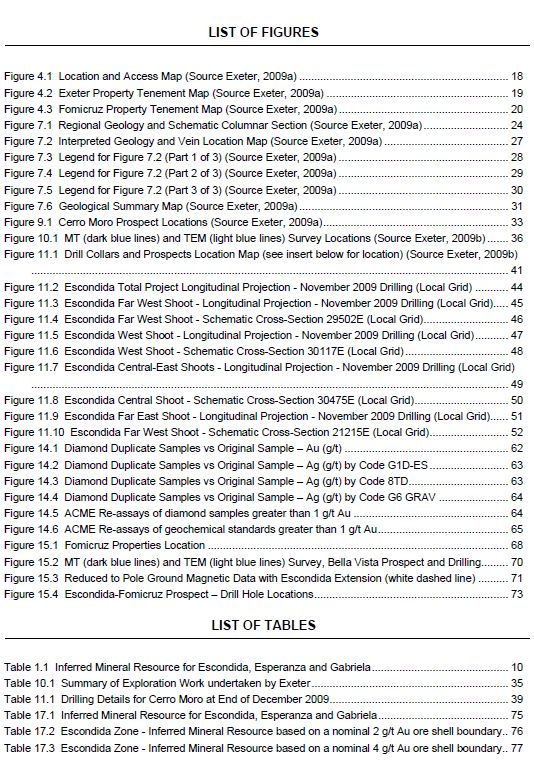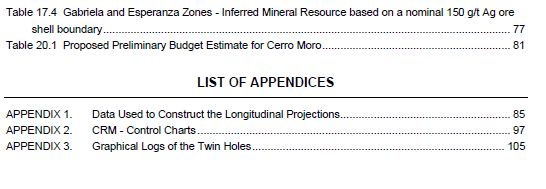Washington, D.C. 20549
Indicate by check mark whether the registrant files or will file annual reports under cover Form 20-F or Form 40-F.
Indicate by check mark if the registrant is submitting the Form 6-K in paper as permitted by Regulation S-T Rule 101(b)(1): __
Indicate by check mark if the registrant is submitting the Form 6-K in paper as permitted by Regulation S-T Rule 101(b)(7): __
Pursuant to the requirements of the Securities Exchange Act of 1934, the registrant has duly caused this report to be signed on its behalf by the undersigned, thereunto duly authorized.
 | Technical Report (NI 43-101) – December 31st 2009 Exeter Resource Corporation
Cerro Moro Gold-Silver Project, Santa Cruz Province Argentina |
Cube Consulting Pty Ltd (Cube) was requested in December 2009, by Exeter Resource Corporation (Exeter) to undertake a site visit to the Cerro Moro Project located in the Santa Cruz province in Argentina. The primary aim of Cube’s engagement was to independently verify resource definition drilling and exploration activities on the Cerro Moro Project during 2009 in preparation for an updated resource estimate to be undertaken during the first quarter of 2010. It is anticipated that the updated resource estimate will form the basis of an internal mining scoping study to be submitted to government during 2010 as part of an Environmental Impact Assessment (EIA) for mine permitting.
This independent technical report details the current status of resource definition drilling and exploration activities on the Cerro Moro Gold-Silver Project (Cerro Moro Project). This report is intended to comply with disclosure and reporting requirements set forth in the Toronto Stock Exchange (TSX) Company Manual, National Instrument 43-101 Companion Policy 43-101CP, and Form 43-101F1.
The Cerro Moro Project is located in southern Argentina, some 60 kilometres (100 kilometres by road) southwest of Puerto Deseado, a port city in the Province of Santa Cruz. The project area is geographically centred at approximately 48° 01’ 55” south latitude and 66° 33’ 45” west longitude.
On July 8, 2009 Exeter announced an initial NI 43-101 compliant Inferred mineral resource estimate for Cerro Moro of 646,000 ounces of gold equivalent. Based on the current resource inventory, Exeter’s internal assessment indicates that the Cerro Moro project has the potential to support a low capital cost high grade gold mining operation. Of particular importance is the high grade Escondida prospect.
The focus of Exeter’s extensive drilling activities at Cerro Moro during 2009 has been infill and extensional drilling on the Escondida prospect. Infill drilling to 20m x 20m spacing is currently being undertaken to upgrade the current Inferred resources to the Indicated category in key areas where open-pit and underground mining activity is likely to be scheduled in the early stages of a mine development. In addition, resource drilling is also being undertaken in order to define resource extensions to the Escondida prospect.
1.3 | Background and Ownership |
The property was discovered in 1993 by Mincorp Explorations S.A. (“Mincorp”), while investigating Landsat Thematic Mapper (“TM”) satellite imagery colour alteration anomalies. The ensuing exploration program, comprising geological mapping, rock chip geochemistry, and drilling led to the discovery of widespread quartz vein structures, variably mineralized, over more than a hundred square kilometre area.
Mincorp collected a total 2,982 surface samples: 2,163 of these were from trenches and rock chip channel samples, with the remaining 819 samples being spot rock chip samples. In addition, Mincorp completed a total of 34 drill holes for 2,593 metres, comprised of 19 diamond drill holes for 1,016 metres and 15 reverse circulation (“RC”) percussion drill holes for 1,577 metres.
 | Technical Report (NI 43-101) – December 31st 2009 Exeter Resource Corporation
Cerro Moro Gold-Silver Project, Santa Cruz Province Argentina |
In 2001 the rights of the property were transferred to Cerro Vanguardia Sociedad Anonima (“CVSA”) following the corporate takeover of Mincorp.
On the 30th of December, 2003 CVSA and Estelar Resources (“Estelar”1 ) signed an Exploration and Option Agreement (“Agreement”) granting Exeter Resource Corporation (“Exeter”) the right to undertake exploration and prospecting work on 39 CVSA properties described in schedule “A” of the Agreement. The Agreement groups the properties into four projects; “Cerro Moro”, “Other Santa Cruz properties”, “Chubut properties” and “Rio Negro properties”. The Agreement provided Exeter with the option (“Option”) to acquire the properties upon incurring $3,000,0002 in expenditures, including completing 8,000 metres of drilling over five years subject to CVSA retaining the right to back-in to a 60% interest in any project once Exeter completed 10,000 metres of drilling on that project. In the event that CVSA exercises its back-in right, it is required to pay Exeter 2.5 times the expenditures, less certain CVSA expenditures, incurred on the project. CVSA can further increase its interest to 70% in the project by funding Exeter’s 30% development share at industry terms with repayment by Exeter on an agreed basis. If CVSA does not exercise its back-in right its interest reverts to a 2% net smelter royalty. This Technical Report details only the exploration activities conducted at Cerro Moro.
In May of 2007, Exeter served notice to CVSA that it was exercising its Option to acquire the properties, having incurred the required exploration expenditures, as detailed in the Agreement. Further, in September of 2007, Exeter served notice of the completion of 10,000 metres of drilling on Cerro Moro, and as required in the Agreement provided CVSA “all relevant geological and technical data and results obtained from the exploration and prospecting works conducted” on the project to that time. This notice triggered CVSA’s once only right to back-in to a 60% project equity interest in Cerro Moro. At the end of October 2007, CVSA gave notice of its decision not to exercise the back-in right and its interest in Cerro Moro has reverted to a 2% net smelter return royalty. All of the Cerro Moro properties have now been transferred to Estelar, and designated as the current owner.
Since commencing work in June 2003 Exeter has carried out diverse exploration activities at Cerro Moro that included; geological mapping, various ground geophysical surveys, surface sampling and drilling.
In March 2009, Exeter and Fomicruz, the Santa Cruz provincial mining company, signed a definitive agreement over ten Fomicruz concessions located adjacent to the Cerro Moro concessions. By spending a total of $10,000,000 on exploration on these concessions Exeter will acquire an 80% interest in the Fomicruz properties. In addition, Fomicruz will acquire a 5% participating interest in Exeter’s Cerro Moro project following the granting of all the required exploitation concessions and permits to commence mining.
1.4 | Geology, Mineralisation and Exploration Concept |
The polymetallic gold-silver mineralisation at Cerro Moro is of the low sulphidation epithermal vein type. Individual prospects vary from simple, single veins to complex vein systems with spur and
_________________________
1 The Agreement was made between CVSA, Estelar and Exeter. Whereas Exeter offered to conduct exploration works on, and potentially acquire an interest in, the mining properties in the agreement. Such exploration works were carried out by its wholly owned subsidiary Estelar. For simplicity this Technical Report only refers to “Exeter”.
2 All monetary units are in United States of America dollars (“US$”), unless specified otherwise.
 | Technical Report (NI 43-101) – December 31st 2009 Exeter Resource Corporation
Cerro Moro Gold-Silver Project, Santa Cruz Province Argentina |
cymoid loop structures. Limited quartz stock-work veinlets are also present peripheral to the main veins.
The mineralisation is hosted in sub-volcanic and volcanic rocks, which are interpreted to belong to the Jurassic age Chon Aike and La Matilde Formations. In general, the project area is composed of many structural blocks produced by a conjugate set of north-west and north-east faults. Both fault directions contain mineralised quartz veins. In the east and central part of the project the north-easterly trending faults control the mineralisation at the Deborah, Belen, Maria, Michelle, Barbara and Ana prospects. In the central and west part of the project the north-westerly trending structures control the mineralisation at the Escondida, Esperanza (including Esperanza South-East), Nini, Dora, Moro, Florencia, Gabriela, Natalia, Tres Lomas and Lala prospects. Several secondary east-west structures occur between the primary north-west structures, and these control the mineralisation at the Patricia, Loma Escondida, Carla and Carlita prospects. The thickness of the veins varies generally from 1 to 5 metres, but there are examples of veins up to 10 metres in width. The strike length of individual veins is variable, generally between 200 metres and 1 kilometre. The Escondida structure has been defined by drilling for more than 3 kilometres, and remains open along strike and at depth.
Improved geological, structural and mineralisation models in the past two years have led to the discovery of numerous high-grade gold-silver polymetallic veins at Cerro Moro. These base metal anomalous Au-Ag veins tend to be recessive and are represented on the surface by either very poorly outcropping quartz vein material or none at all. Extensive cover of Tertiary marine sediments and Quaternary gravels also hinder the location or extensions of the various veins and targets. Detailed ground magnetic survey data, coupled with IP and resistivity data, has highlighted potential targets that are initially tested via trenching, as in the case of the Escondida prospect.
Presently structures in an east-west orientation are the preferred targets, where this orientation is interpreted to be due to tensional, pull apart structures resulting from minor strike-slip movement of the larger north-west structures. Examples include Loma Escondida and Carla which host high-grade gold-silver mineralisation. The Escondida prospect is an example of a high-grade gold-silver shoot in an east-west orientation on a major north-west trending structure.
The discontinuous ore shoots within the larger structures appear to be locally controlled by changes in strike, which are thought to have produced dilational flexures and jogs allowing for greater fluid flow. Changes in wall-rock lithology, along the structures, may be an important factor in controlling the local strike direction of the structures. It has also been noted that the brittle, felsic units have a tendency to produce stronger stock-work style development around the main structures than the intermediate units.
1.5 | Status of Exploration, Development and Operations |
The Cerro Moro Project is in an exploration phase which has focussed on a number of discrete deposits within the property boundary. Exploration activities are currently targeting mineralisation identified as having potential for extraction by open pit and underground mining methods.
Development on site is limited to farm buildings, portable accommodation, gravel roads and minor service infrastructure to support exploration activities.
There is no historical or small scale artisanal mining on the property.
 | Technical Report (NI 43-101) – December 31st 2009 Exeter Resource Corporation
Cerro Moro Gold-Silver Project, Santa Cruz Province Argentina |
On July 8, 2009 Exeter announced the first NI 43-101 compliant mineral resource estimate for the Cerro Moro Project. The independent resource estimate was prepared by Dr. S. C. Dominy, FGS (CGeol) FAusIMM (CP) MIMM (CEng), General Manager (UK) and Executive Consultant, and Mr. C. J. Bargmann, FGS (CGeol) MAusIMM Pr.Sci.Nat, Principal Consultant, both of Snowden UK. Both Dr. Dominy and Mr. Bargmann are “independent” and “qualified persons” as defined in NI 43-101. The mineral resource estimate was prepared in accordance with CIM guidelines (CIM 2005) which have been adopted as part of NI 43-101. The following table summarises the Inferred Mineral Resource for Escondida, Esperanza and Gabriela. These figures are based on the Escondida zone lower grade option (2 g/t Au cut-off grade) and the Esperanza/Gabriela zones utilising a 150 g/t Ag cut-off. The gold equivalent values shown in Table 1.1 were not calculated by Snowden in their original report.
Table 1.1 Inferred Mineral Resource for Escondida, Esperanza and Gabriela
Zone | Tonnes | Gold (g/t) | Silver (g/t) | Gold Equivalent Grade* (g/t) | Gold (ounces) | Silver (ounces) | Gold Equivalent Ounces* |
Esperanza/ Gabriela | 617,000 | 2.3 | 285 | 7 | 46,000 | 5,647,000 | 141,000 |
Escondida | 481,000 | 21.0 | 878 | 36 | 324,000 | 13,579,000 | 551,000 |
Total | 1,098,000 | 10.5 | 545 | 20 | 370,000 | 19,226,000 | 692,000 |
*Gold equivalent values have been calculated by Exeter on the basis of the following parameters:
| • | Long term gold price US$800/Oz |
| • | Long term silver price US$14/Oz |
| • | Metallurgical recovery gold 100% |
| • | Metallurgical recovery silver 100% |
The gold equivalent value is calculated by dividing the silver grade (ppm) by 60 (approximate ratio of gold/silver US$ value) and adding it to the gold grade (ppm).
1.7 | Metallurgical Testwork |
A comprehensive program of metallurgical testwork was carried out during 2008, looking principally at precious metal recovery and comminution characteristics.
Eight quarter-core composites were assembled for 7 of the Cerro Moro shoots where there were sufficient drill-holes to be confident that the composites would be representative. The Escondida Central shoot was split into separate “oxide” and “fresh” composites while the others represented Escondida West, Escondida East, Esperanza, Esperanza SE, Gabriela and Loma Escondida. The testwork flowsheet incorporated flash flotation and gravity concentration to remove coarse electrum and soft silver minerals such as acanthite. Conventional cyanide leaching was then compared with flotation on a simulated grinding circuit product with a P80 size of 75 microns. Gold recoveries using leaching were very high on all 8 composites tested with indicated recoveries averaging greater than 95% on all samples and around 99% on the higher grade Escondida shoots. Silver
 | Technical Report (NI 43-101) – December 31st 2009 Exeter Resource Corporation
Cerro Moro Gold-Silver Project, Santa Cruz Province Argentina |
recoveries were also high with leaching with an average of almost 90%. Importantly there was very little variation in the recovery of either precious metal from shoot to shoot in spite of widely varying head grades.
In comparison to leaching, flotation resulted in lower gold recoveries in most shoots, even though on the Escondida veins they averaged 95%. On the remainder the average was closer to 75% and the individual results were much more variable. With silver, the average recovery was around 85% but again with substantially more variability than leaching.
Seven large diameter PQ holes were drilled during 2008 specifically to obtain samples for comminution tests. Both conventional Bond indices and JK Tech parameters were obtained for each of the samples which were from Escondida Central (2), Escondida West and Far West, Esperanza SE, Gabriela and Silvia. The Cerro Moro materials were generally rated medium to moderately hard in the SMC JK tests. Bond ball mill work indices approached 20 kWh/tonne however abrasion indices were relatively low and averaged about 0.35.
Ongoing work is proposed to further check the flowsheet performance on additional shoots and on individual samples. This is aimed at assessing variability and it is similarly intended to extend the range of comminution results. In addition, test products will be taken and used for additional testwork to define engineering parameters for individual circuits and equipment items.
During 2009, drilling has focussed primarily on the Escondida prospect, where, at the end of December 2009, 275 diamond drill holes had been completed for a total of 32,758.55 metres. Diamond drilling at Escondida was ongoing during December 2009 and there were three rigs active during Cube’s site visit between the 12th and 20th December 2009. Drilling activity ceased for the 2009 year on the 18th December.
Around 78% of the drilling by Exeter has been conducted on the Escondida, Gabriela, Esperanza and Loma Escondida propects, with over 65% of the drilling solely at the Escondida prospect.
The initial drilling program was designed during the first quarter of 2009 to upgrade the main areas of the Escondida Inferred mineral resource to the Indicated mineral resource category. Assuming a drill spacing of approximately 20 x 20 metres, a program of 18,000 metres was designed. This program was initially aimed to drill in areas where the mineralisation could potentially be extracted by open pit methods, and to test the main high grade shoots in the deeper portions. Included was drilling to potentially expand portions of the resource, albeit to remain in the inferred category.
This report proposes a two component drilling program; firstly, continue the infill drilling program at Escondida to be complete at the end of the 2009 calendar year, to allow a revised resource estimate to be made publicly available during Quarter 2, 2010; and secondly, continue to test new targets with the aim of discovering more Escondida-style mineralisation. Other exploration activities will focus on the discovery of new high-grade gold-silver targets, for later drill testing.
In-house engineering and mine planning studies are proposed that will lead to an internal mining scoping study mid 2010. This work will continue through Quarter 2, 2010 and be undertaken at a level to allow a decision to mine later in that year.
A 12 month preliminary budget estimate of US$ 7,455,000 is recommended to complete the above proposed programs.
 | Technical Report (NI 43-101) – December 31st 2009 Exeter Resource Corporation
Cerro Moro Gold-Silver Project, Santa Cruz Province Argentina |
1.9 | Qualified Person’s Conclusions |
Work at Cerro Moro during 2009 has concentrated on drilling the Escondida Prospect. Other regional exploration activities have included target generation through geophysical surveys and satellite imagery, minor RC scout drilling, mapping and sampling.
It is Cube’s opinion that the current exploration and resource definition strategy is well considered and appropriate for the advancement of the Cerro Moro project towards mining exploitation. Cube agrees that infill drilling at the Escondida prospect to 20m x 20m is sufficient and necessary to upgrade current Inferred mineral resources to the Indicated category. The current strategy of three rigs being deployed on infill and strike extension drilling at Escondida is logical as this prospect is clearly the focus of current mining evaluation and the prospect offers significant potential for additional high grade resources.
It is anticipated that the infill drilling conducted at the Escondida prospect during 2009 and early 2010 will result in material changes to the resource classification with significant proportions of the resource being converted from the Inferred to Indicated mineral resource category. In addition, it is likely that the Escondida resource base will be increased due to the discovery of resource extensions in the western portion of the Escondida prospect.
All logging, sampling and data QAQC procedures during 2009 have been carried out to a high industry standard and record keeping and database management is excellent. Cube believes that the current database provides an accurate and robust representation of the Cerro Moro project and is appropriate for ongoing resource evaluation.
Exeter has undertaken significant metallurgical testwork during 2008 which is representative of the most likely styles of mineralisation to be encountered during mining. This testwork indicates that gold and silver recoveries of 95% and 90% respectively can be achieved using a three stage process flow of gravity concentration, flash flotation and tails leaching.
Exeter has been undertaking ongoing environmental base line studies since mid-2008 at the Cerro Moro project with the objective of establishing the pre-development environmental and social characteristics of the project and its surrounds. The author noted Exeter's strong commitment to environmental sustainability surrounding its current exploration activities. Drill site rehabilitation and general cleanliness around areas of intensive drilling activity was particularly impressive.
The author held discussions with Exeter's specialist Argentine mining lawyer Dra. Patricia Inzirillo with respect to the status of the exploration concessions at Cerro Moro and the Argentine mining law in general. Cube has relied upon the opinion of Dra. Inzirillo with respect to the agreement between Exeter, Estelar Resources Limited and CVSA and the definitive agreement between Exeter and Fomicruz. Exeter, through specialist legal counsel Dra. Inzirillo, appears to have a comprehensive understanding of the Argentine mining laws and all associated legal obligations. Cube has no reason to doubt the validity of any current contracts or agreements and is not aware of any material issues affecting the legal tenure of the project concessions.
1.10 | Qualified Person’s Recommendations |
| • | Continue infill and extension drilling at Escondida as currently proposed; |
 | Technical Report (NI 43-101) – December 31st 2009 Exeter Resource Corporation
Cerro Moro Gold-Silver Project, Santa Cruz Province Argentina |
| • | Progress exploration activities in close proximity to Escondida to either define additional resources or to locate appropriate 'barren' areas for location of open pit waste dumps and other near mine infrastructure; |
| • | Undertake a re-interpretation of all significant mineralised zones using geological attributes such as vein textures and mineralisation styles in preference to applying arbitrary cut-off grade criteria; |
| • | Undertake an updated resource estimation of all significant mineralised zones using an appropriate geostatistical approach; |
| • | Attempt to improve understanding of likely geological and grade variability with respect to quantifying resource risk; |
| • | Form an opinion as to the likely grade control requirements for both open pit and underground mining scenarios to be used as inputs in any ongoing mining studies. |
 | Technical Report (NI 43-101) – December 31st 2009 Exeter Resource Corporation
Cerro Moro Gold-Silver Project, Santa Cruz Province Argentina |
2.1 | Request for Technical Report |
Exeter Resource Corporation (Exeter), a Canadian company based in Vancouver, British Columbia requested Cube Consulting Pty Ltd (Cube) to prepare a report detailing the current status of exploration activities on the Cerro Moro Gold-Silver Project (“Cerro Moro”) located in Santa Cruz Province, Argentina. This “Technical Report” as defined by National Instrument 43-101 Standards of Disclosure for Mineral Projects (“NI 43-101”) conforms with the requirements of Form 43-101F1.
Much of the information contained in this report has been provided by Exeter or drawn directly from three previous NI 43-101 Technical Reports compiled by Exeter in February 2009 (Williams & Perkins, 2009a) and October 2009 (Williams, 2009b) and Snowden Mining Industry Consultants Limited (Snowden) 2009 (Bargmann et al, 2009).
This report provides an update with respect to exploration activities at the Cerro Moro Project undertaken by Exeter during 2009 and serves as an independent verification of the exploration activities described in detail by Exeter in the October 2009 NI 43-101 Technical Report authored by Mr M T Williams (Williams, 2009b). In many instances, information provided in the Exeter October 2009 NI 43-101 is still current and is directly reproduced in this report for convenience.
The Qualified Person responsible for the preparation of this report is Mr Ted Coupland of Cube who visited the Cerro Moro project between 12th December and 20th December 2009.
2.2 | Purpose of Technical Report |
This report is intended to comply with the requirements of the Canadian National Instrument 43-101, “Standards of Disclosure for Mineral Properties” as required for reports to be filed under Canadian jurisdiction. The report specifically details the results of the Cerro Moro Project’s ongoing drilling activities and the associated requirement for an updated Mineral Resource estimate due to be undertaken during Quarter 1, 2010. In order to fully comply with the requirements of the Form 43-101F1, this technical report includes information and conclusions on specific aspects of the project from previous technical reports despite no additional information or work being conducted in respect of these aspects.
The scope of Cube’s engagement is as follows:
| • | Undertake a site visit to the Cerro Moro Project during December 2009 to independently verify all aspects of drilling and exploration activities undertaken by Exeter during 2009; |
| • | Review and update the geological/mineralisation interpretations for Cerro Moro Project incorporating available information as of end of February 2010; |
| • | Undertake statistical and geostatistical analysis of the mineralised material; |
| • | Estimate the Cerro Moro gold and silver Mineral Resources in a suitable manner for open pit and/or underground mining evaluation; |
| • | Independently classify and report the Mineral Resources for the total Cerro Moro Project in accordance with The 2004 Australasian Code for Reporting of Mineral Resources and Ore Reserves (2004 JORC Code) and the Canadian Companion Policy 43-101CP. |
The estimation work will commence during January 2010 with completion scheduled during March 2010.
 | Technical Report (NI 43-101) – December 31st 2009 Exeter Resource Corporation
Cerro Moro Gold-Silver Project, Santa Cruz Province Argentina |
2.3 | Sources of Information and Data |
Much of the information contained in this report has been provided by Exeter or drawn directly from three previous NI 43-101 Technical Reports compiled by Exeter in February 2009 and October 2009 (Exeter, 2009a and 2009b) and Snowden Mining Industry Consultants Limited (Snowden) August 2009 (Bargmann et al, 2009). This report is an update of the previous report by Exeter (2009b), primarily providing an update of Exeter´s 2009 work programs and results to date.
Cube also reviewed several internal company reports including; Callan (2008), Corbet (2007i & 2007ii), Coughlin (2005), Gómez (2006), Grahame (2007), Houston (2007i & 2007ii), Mason (2008), Nash (2004), Perkins & Williams (2007 & 2008), Scarbrough (2009), Van Kerkvoort (2005), Van Kerkvoort et al (2007) and Williams (2006).
Technical reports and other documents used in the preparation of this report are listed in Section 21 of this report.
Consultations were made with an Argentine mining lawyer regarding land disposition and the acquisition of mineral rights in Argentina.
Other digital information provided to Cube includes:
| • | Drilling data current to 3rd December 2009; |
| • | Summary details of drilling data quality including age of data, drilling method, location and survey accuracy, sampling procedures, and analytical methods; |
| • | Description of mineralisation characteristics and geology; and |
| • | Mineralisation interpretations where available. |
2.4 | Scope of the Author’s Inspections of the Property |
The Cube site visit was undertaken by Mr Ted Coupland, between 12th December and 20th December 2009. Cube undertook several visits to the field where the main mineralised prospects were inspected. In addition, three active Boart Longyear diamond drill rigs were observed drilling the Far West portion of the Escondida prospect.
Cube also inspected representative drill core, observed geological and geotechnical logging activities, sample mark-up, core cutting, sample numbering and recording, insertion of QAQC reference material, sample bagging and dispatch. Whilst on site Cube had the opportunity to discuss various project details with several senior Exeter staff including Mr Matt Williams (Exploration Manager), Dr Eric Roth (Geology Manager; Development Team) and Mr Fernando Chacon (Cerro Moro Site Manager).
An additional day was spent in Mendoza where Cube met with Exeter's specialist Argentine mining lawyer Dra. Patricia Inzirillo to discuss details regarding the status of the exploration concessions at Cerro Moro and the Argentine mining law in general.
Whilst in Mendoza, Cube took the opportunity to inspect the ACME sample preparation facility where all Exeter drill samples submitted during 2009 have been prepared prior analysis in Santiago, Chile.
All units are metric unless otherwise stated. Local drilling grids are used over the main prospects based on the strike direction of the mineralised units. These grids can be referenced back to the Argentinean Gauss-Krüger projection (similar to UTM), Faja 2, Campo Inchauspe datum.
All monetary units are in United States of America dollars (“US$”), unless specified otherwise.
This report is an update of the previous Technical Report on Cerro Moro by Exeter (2009b).
 | Technical Report (NI 43-101) – December 31st 2009 Exeter Resource Corporation
Cerro Moro Gold-Silver Project, Santa Cruz Province Argentina |
3.0 | RELIANCE ON OTHER EXPERTS |
Cube has based this Technical Report on the Cerro Moro Project on information provided by Exeter. This report is intended to be read as a whole including references, in particular, to three previously lodged NI 43-101 Technical reports compiled by Exeter in February 2009 (Williams & Perkins, 2009a) and October 2009 (Williams, 2009b) and Snowden Mining Industry Consultants Limited in August 2009 (Bargmann et al, 2009).
The data includes third party technical reports and relevant published and unpublished third party information. Cube has made all reasonable endeavours, including a site visit to the Cerro Moro Project to confirm the authenticity and completeness of the technical data on which this report is based, however Cube cannot guarantee the authenticity or completeness of such third party information.
Cube has not independently investigated the tenement status of the project or the requirements of the Argentine mining law. The author of this report is not qualified to provide comment on the legal issues associated with the Cerro Moro Project, including any agreements, joint venture terms or the legal status of the concessions included in the Cerro Moro Project. The author has relied upon the expert opinion of Dra. Patricia Inzirillo, a specialist Argentine mining lawyer, as to the status of the exploration concessions at the Cerro Moro Project and the Argentine mining law in general.
 | Technical Report (NI 43-101) – December 31st 2009 Exeter Resource Corporation
Cerro Moro Gold-Silver Project, Santa Cruz Province Argentina |
4.0 | PROPERTY DESCRIPTION AND LOCATION |
A comprehensive property description and location of Cerro Moro is detailed in the following Technical Reports:@@
Bargmann, C. J., Dominy, S.C., & Platten, I.M., 2009: Geological Review and Mineral Resource Estimate, September 2009 – Exeter Resource Corporation: Cerro Moro Project., Snowden Mining Industry Consultants, Project No. L00154, Published (on SEDAR). |
Williams, M.T. & Perkins, J., 2009: Technical Report – Cerro Moro Project, Santa Cruz Province, Argentina., Exeter Resource Corporation, Published (on SEDAR) Company report dated 9th February, 2009. |
Both of these documents have been previously lodged with the Canadian Securities Administrators and are available for viewing on the System for Electronic Document Analysis and Retrieval (“SEDAR”) at http://www.sedar.com.
The Cerro Moro Project is located in southern Argentina, some 60 kilometres (100 kilometres by road) southwest of Puerto Deseado, a port city in the Province of Santa Cruz. The project area is geographically centered at approximately 48° 01’ 55” south latitude and 66° 33’ 45” west longitude (refer to Figure 4.1).
The Cerro Moro Project currently comprises eighteen titles covering the main prospects. Two of these titles are Cateos de Exploracion (“Cateo”) and the remainder are Manifestaciones de Discubrimiento (“MD”) covering approximately 177 square kilometres as shown in Figure 4.2.
 | Technical Report (NI 43-101) – December 31st 2009 Exeter Resource Corporation
Cerro Moro Gold-Silver Project, Santa Cruz Province Argentina |
Figure 4.1 Location and Access Map (Source Exeter, 2009a)
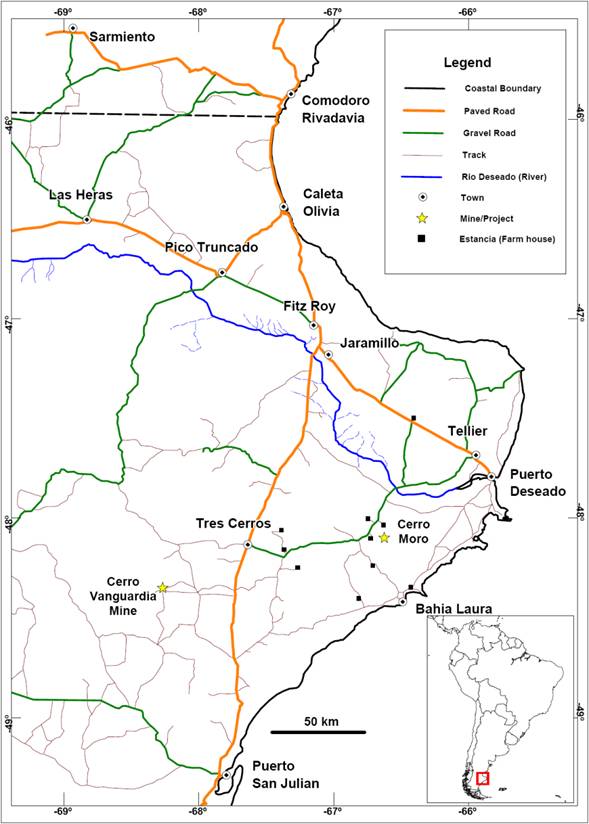
 | Technical Report (NI 43-101) – December 31st 2009 Exeter Resource Corporation
Cerro Moro Gold-Silver Project, Santa Cruz Province Argentina |
Figure 4.2 Exeter Property Tenement Map (Source Exeter, 2009a)
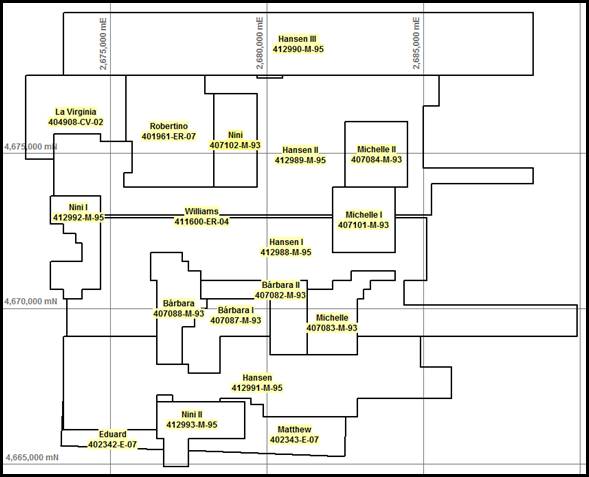
4.2.1 | Exeter - CVSA Option Agreement |
On the 30th of December, 2003 CVSA and Exeter signed an Agreement, granting Exeter the right to undertake exploration and prospecting work on 39 CVSA properties (“Properties”) described in schedule “A” of the Agreement.
The Agreement provides Exeter with the exclusive right to acquire a 100% interest in the Properties contained in four projects (located in three Argentine provinces; Rio Negro, Chubut and Santa Cruz) by incurring exploration expenditures of US$3 million over five years, with minimum expenditures in years one and two of $250,000 and $500,000, respectively, followed by $750,000 in each of years three through five including completing 8,000 metres of drilling. Exeter completed a legal due diligence review over of the Properties in March, 2004. The Agreement does not require Exeter to issue shares or make any cash payment to CVSA, other than a signature fee of US$100,000 which was fully paid in September, 2004.
Exeter exercised its Option to acquire the Properties in 2007, having incurred US$3 million on exploration. Once Exeter completes 10,000 metres of drilling on any project, CVSA has the right to back into a 60% interest in that project by paying Exeter 2.5 times Exeter's expenditures on that project and by carrying Exeter to the completion of a bankable feasibility study. CVSA may earn an additional 10% project interest (to bring its total interest to 70%) by financing Exeter's share of mine development costs (to be repaid at an agreed rate). Should CVSA not elect to back-in to a project, its interest will reverts to a 2% net smelter return (NSR) from production on that project.
 | Technical Report (NI 43-101) – December 31st 2009 Exeter Resource Corporation
Cerro Moro Gold-Silver Project, Santa Cruz Province Argentina |
Exeter completed 10,000 metres of drilling at Cerro Moro at the end of July, 2007 and following data collation and the receipt of drilling assays, delivered to CVSA a detailed report containing all geological data in early September 2007. CVSA then had a 45 day period in which to exercise its back-in right or its interest would revert to a 2% NSR. On the 29th of October, 2007 CVSA notified Exeter that they would not to exercise their back-in right. The properties have been transferred to Estelar, and 100% ownership of them.
4.2.2 | Exeter - Fomicruz Agreement |
On the 5th of March, 2008 Exeter and Fomento Minera de Santa Cruz Sociedad del Estado3 (“Fomicruz”), announced it had signed a letter of intent (“LOI”) that set out the key terms of a strategic agreement between Exeter and Fomicruz for the future development of the Cerro Moro project which also provides access to Fomicruz’s significant land holding around Cerro Moro.
The LOI states that Exeter and Fomicruz SE will, subject to approval by the parties, enter into a detailed agreement which will include the following terms:
| • | Fomicruz SE will acquire a 5% interest in Exeter’s 177 square kilometre Cerro Moro project; |
| • | Exeter will have the right to earn up to an 80% interest in 691 square kilometres of Fomicruz SE exploration properties (see Figure 4.3) adjoining the Cerro Moro project by incurring US$10 million in exploration expenditures over a number of years; |
| • | Exeter will fund all exploration and development costs of the Cerro Moro project and Fomicruz SE will repay an agreed amount of those costs from 50% of Fomicruz SE’s share of net revenue from future operations; and |
| • | Exeter will manage the exploration and potential future development on the properties |
Figure 4.3 Fomicruz Property Tenement Map (Source Exeter, 2009a)

_________________________
3 Fomicruz is a company owned by the Government of Santa Cruz Province, Argentina.
 | Technical Report (NI 43-101) – December 31st 2009 Exeter Resource Corporation
Cerro Moro Gold-Silver Project, Santa Cruz Province Argentina |
5.0 | ACCESSIBILITY, CLIMATE, LOCAL RESOURCES, INFRASTRUCTURE AND PHYSIOGRAPHY |
A comprehensive description of accessibility, climate, local resources, infrastructure and physiography of Cerro Moro is detailed in Bargmann et al (2009) and Williams & Perkins (Exeter, 2009a). Both of these documents have been previously lodged with the Canadian Securities Administrators and are available for viewing on SEDAR at http://www.sedar.com.
 | Technical Report (NI 43-101) – December 31st 2009 Exeter Resource Corporation
Cerro Moro Gold-Silver Project, Santa Cruz Province Argentina |
A comprehensive description of the history of Cerro Moro is detailed in Bargmann et al (2009) and Williams & Perkins (Exeter, 2009a). Both of these documents have been previously lodged with the Canadian Securities Administrators and are available for viewing on SEDAR at http://www.sedar.com.
 | Technical Report (NI 43-101) – December 31st 2009 Exeter Resource Corporation
Cerro Moro Gold-Silver Project, Santa Cruz Province Argentina |
Cerro Moro is geologically located within the Deseado Massif, which is a tectonic block in the central-portion of the Santa Cruz Province, covering an area of approximately 60,000 square kilometres.
The oldest rocks within the Deseado Massif are the Upper Pre-Cambrian and Lower Palaeozoic metamorphics of the La Modesta Formation (also known as the Rio Deseado Complex). This formation is intruded by granites of Lower to Middle Palaeozoic age. These rocks are in turn unconformably overlain by continental sandstone of the La Golondrina and El Tranquilo Formations, which were deposited in a series of graben and half-graben structures.
During the Jurassic and Cretaceous Periods the region underwent extensional tectonics, which initially resulted in the epiclastic and pyroclastic Roca Blanca Formation, followed by the widespread mafic volcanic field of the Bajo Pobre Formation during the Mid-Jurassic. During the Mid and Upper Jurassic these rocks were overlain by felsic and intermediate volcanics and sediments of the Bahia Laura Group. The Bahia Laura Group includes the Chon Aike and La Matilde Formations. The Chon Aike Formation constitutes a thick sequence of rhyolitic ignimbrites, tuffs and volcaniclastics, and is interpreted to host the gold mineralisation at Cerro Moro.
During the Early Tertiary Period – Paleocene Epoch the region was draped with continental and marine sediments. More recently, during the Late Tertiary Period to Pleistocene Epoch, basaltic lava flows were extruded but these are not observed at Cerro Moro (refer to Figure 7.1).
 | Technical Report (NI 43-101) – December 31st 2009 Exeter Resource Corporation
Cerro Moro Gold-Silver Project, Santa Cruz Province Argentina |
Figure 7.1 Regional Geology and Schematic Columnar Section (Source Exeter, 2009a)
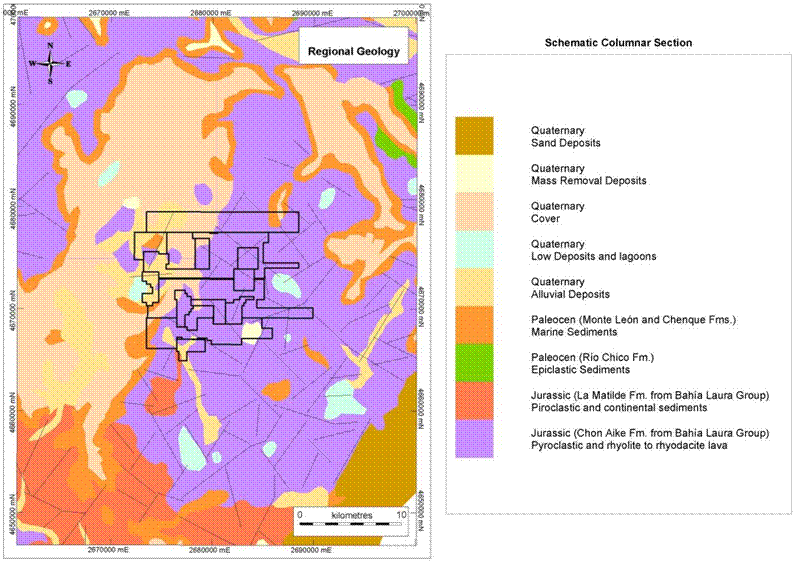
 | Technical Report (NI 43-101) – December 31st 2009 Exeter Resource Corporation
Cerro Moro Gold-Silver Project, Santa Cruz Province Argentina |
7.2 | Local & Property Geology |
The Cerro Moro property is interpreted to be underlain by shallow south dipping Jurassic age volcanic stratigraphy broadly assigned to the Bahia Laura Group which is regionally documented to encompass:
| 1. | the Bajo Pobre Formation; which comprises tuffs, flows and sub-volcanic intrusives of andesitic to basaltic composition, |
| 2. | the Chon Aike Formation; the two principal components of which are the rhyolitic ignimbritic pyroclastic facies plus a late intrusive/extrusive flow-domes facies, and |
| 3. | the Matilde Formation; characterized by more epiclastic and aerially deposited ash rich volcaniclastic deposits that are observed to interdigitate or form a lateral facies variation to the main Chon Aike Formation sequence. |
A little over 30% of the project is covered by Tertiary marine sediments and Quaternary gravels.
In 2008 contract geologist Nick Callan mapped the entire Moro project at a scale of 1:10,000 (refer to Figure 7.2 to Figure 7.5 for an Interpreted Geology map and accompanying legends). The following geological description is largely taken from his report (Callan, 2008).
Some 14 stratified volcanic units, were defined, that form mappable entities at 1:10,000 scale. These units may be grouped into five broad packages based on inferred ages (refer to Figure 7.6), composition, lithological characteristics and spatial relationships:
| 1. | The oldest of these packages is the P1 group, comprising an extensive pile of coarse rhyolite clast-bearing ash-flow tuffs and remnant flow-domes, the upper part of which is punctuated by several closely associated welded ignimbritic horizons of rhyodacitic to locally more dacitic composition. The P1 group was assigned to the Chon Aike Formation. |
The P1 group forms an extensive litho-structural domain covering a large part of the property, the southern boundary of which is defined by an arcuate, linked normal fault system formed by the interaction of the northwest striking Escondida Fault and the informally named northeast striking Deborah South Fault. Post-P1 group stratigraphy, showing shallow south to southeast dips, is generally confined to the corresponding down-thrown structural domain lying to the south of this linked normal fault system. Field evidence suggests that this linked fault system was active during deposition of the post-P1 group volcanic stratigraphy.
| 2. | Unconformably overlying the P1 group is a compositionally distinct volcanic-sedimentary assemblage of andesitic to basaltic composition comprising bedded volcanic sediments, coarse volcanic breccias, flows and possibly concordant sub-volcanic intrusive units. Tentatively this assemblage is inferred to represent a short-lived overlap of the Bajo Pobre Formation with the Chon Aike Formation which dominates the property geology. |
| 3. | This more intermediate compositional interlude is overlain, again unconformably, by a bedded series of felsic air-fall tuffs and related epiclastic units, characterized by the presence of wood fragments, accretionary lapilli and local hot-spring “sinter”. The latter features are diagnostic of the Matilde Formation of the Jurassic age Bahia Laura Group. |
 | Technical Report (NI 43-101) – December 31st 2009 Exeter Resource Corporation
Cerro Moro Gold-Silver Project, Santa Cruz Province Argentina |
| 4. | The bedded tuff and epiclastic unit pass gradationally upwards via a thin “transitional” stratified sequence characterized by pumice-bearing vitric tuffs beds into the youngest mapped volcanic group, comprising a crudely stratified sequence of strongly welded ignimbritic tuffs of rhyolitic composition. Callan (2008) also considered this latter group to be part of the Chon Aike Formation. |
| 5. | Hosted within the stratified volcanic pile is a series of co-genetic, texturally diverse rhyolitic units forming simple and composite intrusive flow-domes, as well as dykes on a variety of scales. Emplacement of the rhyolitic units was strongly influenced by structure. Rhyolitic intrusives are for the most part discordant with host volcanics though some locally sub-concordant relations were observed by Callan (2008). Cross-cutting relationships with the younger mapped stratigraphic units indicate much of the rhyolite intrusive activity occurred quite late in the geological evolution of the sector. |
The area mapped by Callan (2008) is characterized by complex structural architecture comprising a mesh of steeply dipping to sub-vertical fault structures showing principally northwest to west-northwest strikes, northeast strikes, west-southwest strikes and more northeast to north-northeast strikes. “Several of the major mapped fault structures (e.g.: the west-northwest to northwest striking Escondida Fault, the northeast striking Deborah South Fault, and the northwest striking Deborah-Belen Fault) record evidence of a significant normal component of displacement over much of their kinematic history. Normal displacement occurred on some structures (e.g.: Escondida Fault, Deborah South Fault) synchronously with deposition of the post-P1 sequence and these structures very likely exerted some control on the primary distribution of volcanic units and Jurassic palaeo-topography. Normal or oblique faulting and associated dilation on variably oriented fault structures also likely controlled emplacement and geometry of rhyolite flow-domes and related dykes, and more importantly provided sites for epithermal Au-Ag vein mineralization. Post-mineral movement also occurred, localizing late rhyolitic intrusive activity, offsetting and brecciating vein mineralization, and locally preserving high-level alteration types. Thus a long-lived extensional structural regime prevailed and played an active role during much of the geological development of the area. This extensional regime is now manifest as widespread block-faulting with generally minor dip-slip or oblique slip on most faults, but with a locally more significant normal component of displacement across master faults (e.g.: Escondida Fault, Deborah South Fault).” (Callan, 2008).
 | Technical Report (NI 43-101) – December 31st 2009 Exeter Resource Corporation
Cerro Moro Gold-Silver Project, Santa Cruz Province Argentina |
Figure 7.2 Interpreted Geology and Vein Location Map (Source Exeter, 2009a)
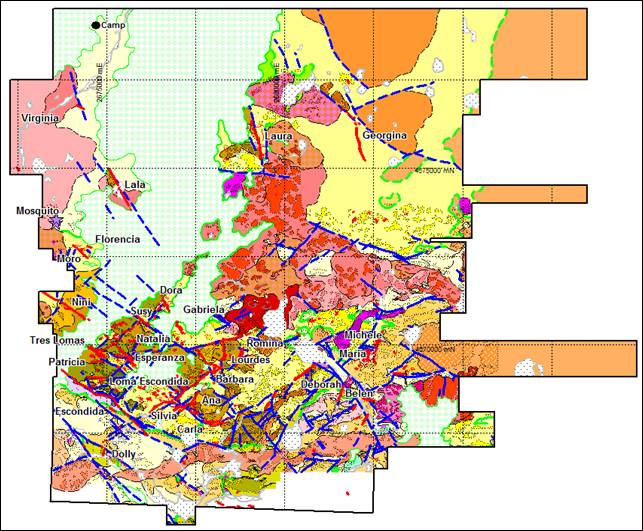
 | Technical Report (NI 43-101) – December 31st 2009 Exeter Resource Corporation
Cerro Moro Gold-Silver Project, Santa Cruz Province Argentina |
Figure 7.3 Legend for Figure 7.2 (Part 1 of 3) (Source Exeter, 2009a)

 | Technical Report (NI 43-101) – December 31st 2009 Exeter Resource Corporation
Cerro Moro Gold-Silver Project, Santa Cruz Province Argentina |
Figure 7.4 Legend for Figure 7.2 (Part 2 of 3) (Source Exeter, 2009a)
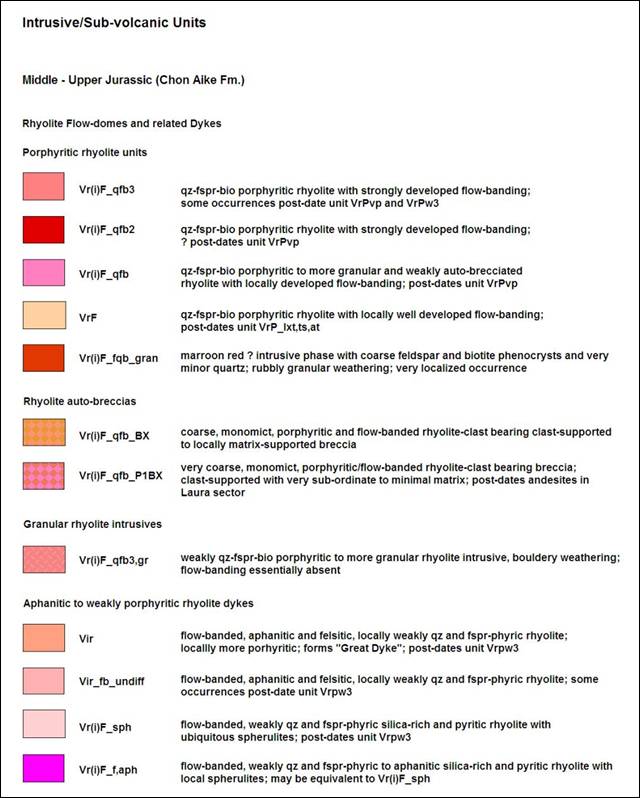
 | Technical Report (NI 43-101) – December 31st 2009 Exeter Resource Corporation
Cerro Moro Gold-Silver Project, Santa Cruz Province Argentina |
Figure 7.5 Legend for Figure 7.2 (Part 3 of 3) (Source Exeter, 2009a)
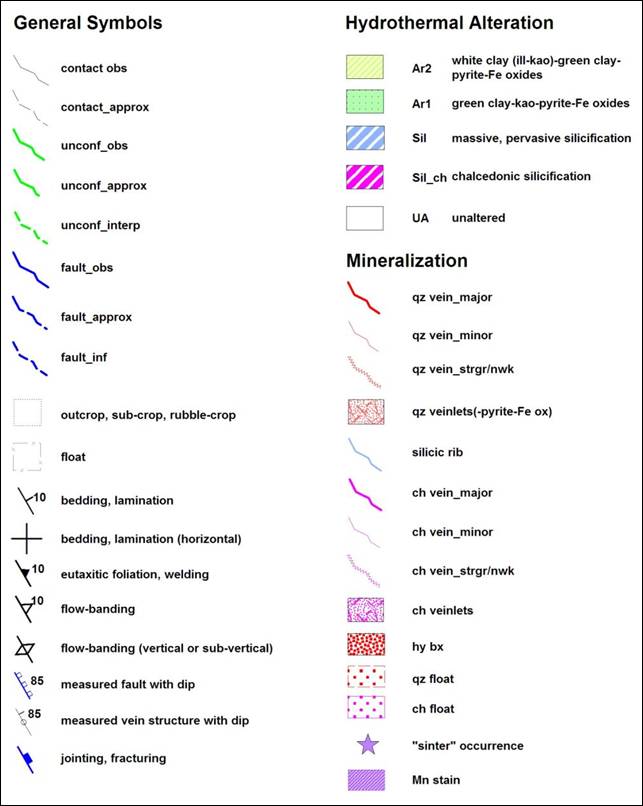
 | Technical Report (NI 43-101) – December 31st 2009 Exeter Resource Corporation
Cerro Moro Gold-Silver Project, Santa Cruz Province Argentina |
Figure 7.6 Geological Summary Map (Source Exeter, 2009a)

 | Technical Report (NI 43-101) – December 31st 2009 Exeter Resource Corporation
Cerro Moro Gold-Silver Project, Santa Cruz Province Argentina |
A comprehensive description of the deposit types of Cerro Moro is detailed in Bargmann et al (2009) and Williams & Perkins (Exeter, 2009a). Both of these documents have been previously lodged with the Canadian Securities Administrators and are available for viewing on SEDAR at http://www.sedar.com.
 | Technical Report (NI 43-101) – December 31st 2009 Exeter Resource Corporation
Cerro Moro Gold-Silver Project, Santa Cruz Province Argentina |
Polymetallic gold-silver mineralization is associated with epithermal veins. High-grade gold and silver mineralisation is strongly associated with the presence of sulphides such as: pyrite, sphalerite, galena, acanthite and chalcopyrite. Detrimental toxic elements such as arsenic and mercury are at relatively low levels. The presence of yellow sphalerite and adularia are indicative of low temperature ore formation. At least two mineralisation pulses have been observed. The first pulse deposited clean white quartz veins with low sulphide content and is generally poorly mineralised. This has been interpreted as the product of shallow, circulating meteoric dominated water with scarce mixing of magmatic water. A second, later pulse, consisting of black silica is rich in sulphides and hosts high-grade mineralisation. Precious metal deposition is interpreted to be the product of mixing of magmatic dominated water with meteoric waters. Boiling textures, vein breccias and repeated quartz overgrowths with sulphidic ginguro bands are also observed. Coarse silver sulphide (acanthite) and electrum have been observed in several ore shoots and are common in the Escondida prospects. Figure 9.1 shows the distribution of the various veins at Cerro Moro.
Figure 9.1 Cerro Moro Prospect Locations (Source Exeter, 2009a)

 | Technical Report (NI 43-101) – December 31st 2009 Exeter Resource Corporation
Cerro Moro Gold-Silver Project, Santa Cruz Province Argentina |
A comprehensive description of the various veins at Cerro Moro is detailed in Bargmann et al (2009) and Williams & Perkins (Exeter, 2009a). Both of these documents have been previously lodged with the Canadian Securities Administrators and are available for viewing on SEDAR at http://www.sedar.com.
 | Technical Report (NI 43-101) – December 31st 2009 Exeter Resource Corporation
Cerro Moro Gold-Silver Project, Santa Cruz Province Argentina |
A comprehensive description of exploration activities prior to 2009 at Cerro Moro is detailed in Bargmann et al (2009) and Williams & Perkins (Exeter, 2009a). Both of these documents have been previously lodged with the Canadian Securities Administrators and are available for viewing on SEDAR at http://www.sedar.com.
Exploration activities undertaken by Exeter during 2009 are described in detail in the NI 43-101 Technical Report authored by Williams (Exeter, 2009b) which was also previously lodged with the Canadian Securities Administrators and is available for viewing on the SEDAR website. Exploration activities described in Williams (Exeter, 2009b) are still current and have been summarised again in this Technical Report for convenience.
Work at Cerro Moro during 2009 has concentrated on drilling at the Escondida Prospect. Other exploration activities are summarised in Table 10.1.
Table 10.1 Summary of Exploration Work undertaken by Exeter
Date | Exeter Exploration Works | Responsible Geologist |
January 2009 | Commencement of a NI 43-101 compliant resource estimate | Matthew Williams & Fernando Chacon |
April - December 2009 | Diamond Drilling at Escondida | Fernando Chacon |
June-July 2009 | Magneto-Telluric and Transient Electromagnetic | Fernando Chacon |
July 2009 | Public release of the NI 43-101 compliant resource estimate | Matthew Williams & Fernando Chacon |
No material additional geological mapping or geochemical sampling has been conducted at Cerro Moro during 2009.
Exeter has had success in tracing the majority of the structures at Cerro Moro that in many locations host significant gold-silver mineralisation, utilising the detailed ground magnetics that covers the majority of the project. However the magnetic data does not appear to highlight where significant mineralisation (that is the high grade mineralised shoots) is located along these structures. Following consultations with geophysical consulting company, Zonge Ingenieria y Geofísica (Chile) S.A. (“Zonge”) a trial survey of Magneto-Telluric (“MT”) was proposed.
A total of 9.9 line kilometres of 25 metre dipole MT data was acquired on 9 survey lines, between 20 June and 15 July, 2009. The first 7 orientation lines were conducted over the known mineralisation at the Escondida, Esperanza and Gabriela prospects. An additional 2 reconnaissance lines were conducted to the south of the property to test for potential new mineralisation. In addition, Zonge also conducted 5.8 line kilometres of Transient Electromagnetic (“TEM”) surveying using a 100 metre coincident loop to evaluate potential water sources in an area of sedimentary cover. The location of the MT and TEM surveys is displayed on Figure 10.1.
 | Technical Report (NI 43-101) – December 31st 2009 Exeter Resource Corporation
Cerro Moro Gold-Silver Project, Santa Cruz Province Argentina |
Figure 10.1 MT (dark blue lines) and TEM (light blue lines) Survey Locations (Source Exeter, 2009b)
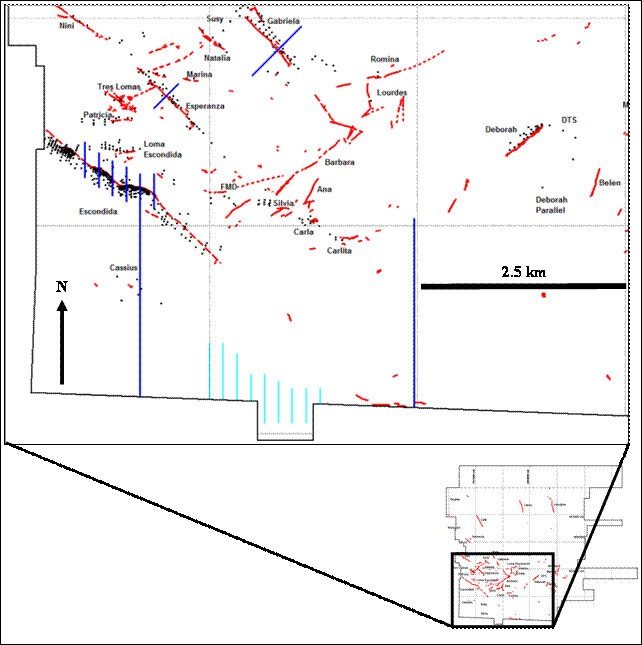
10.2.1 | Magneto-Telluric Data |
The trial MT survey commenced over the known mineralisation at Escondida, comprising six north-south orientated lines. Continuing the trial MT survey, additional lines of data were obtained over the Esperanza and Gabriela prospects.
Zonge reported that “The 2D inversion modelling of MT data has defined discrete zones of high resistivity associated with the Escondida quartz bearing vein system and further zones of similar resistivity characteristics indicate likely westerly extensions to the Loma Escondida and Ornella structures and a possible parallel structure north of the Escondida Central / East trend. At Esperanza and Gabriela, narrow zones of high resistivity are also noted coincident with Au mineralization intersected in exploratory drill holes. Similar, sub-parallel, features are also
 | Technical Report (NI 43-101) – December 31st 2009 Exeter Resource Corporation
Cerro Moro Gold-Silver Project, Santa Cruz Province Argentina |
interpreted consistent with lineaments observed in processed ground magnetic images.” (Scarbrough, 2009).
10.2.2 | Transient Electromagnetic Data |
In regard to the TEM survey, Zonge reported that “The TEM data acquired to the southeast of the main Escondida area defined a broad, shallow, sub-horizontal conductive layer of approximately 100m thickness in the southern part of the survey area that may be associated with an elevated water content in shallow sedimentary cover. A deeper conductive zone towards the northwest might represent a significant water resource at depth.” (Scarbrough, 2009).
 | Technical Report (NI 43-101) – December 31st 2009 Exeter Resource Corporation
Cerro Moro Gold-Silver Project, Santa Cruz Province Argentina |
A comprehensive description of drilling prior to 2009 at Cerro Moro is detailed in Bargmann et al (2009) and Williams & Perkins (Exeter, 2009a). Both of these documents have been previously lodged with the Canadian Securities Administrators and are available for viewing on SEDAR at http://www.sedar.com.
Prior to Exeter being involved in the project, a program of 34 drill holes for 2,593 metres was undertaken by Mincorp, comprising 19 diamond drill holes for 1,016 metres and 15 RC percussion drill holes for 1,577 metres.
As at the end of 2008, Exeter had drilled a total of 472 drill holes for 50,257.15 metres, comprising 264 diamond holes for 20,876.85 metres and 208 RC percussion drill holes for 29,380.30 metres.
During 2009 the drilling has focussed primarily on the Escondida prospect, with 275 diamond drill holes being drilled for 32,758.55 metres to the end of December 2009. Diamond drilling with three rigs continued at the Escondida prospect until 18th December 2009. Drilling is scheduled to recommence at Escondida in the first half of January 2010.
In addition, an RC percussion drill rig arrived on site during August 2009 and at the end of December 2009 had drilled 44 holes for a total of 4,729.3 metres at Cerro Moro. Of these, 35 holes were sited at eight new exploratory targets to test for either conceptual geological/structural targets or geophysical anomalies with the remaining 9 holes drilled for water supply.
The current total of Exeter drilling at Cerro Moro to the end of December 2009 equates to 791 holes for 87,445.2 metres.
Table 11.1 shows the total drill metres (including pre-Exeter) conducted and the percentage by prospect as at the end of November 2009. Table 11.1 shows that around 76% of the drilling has been conducted on the Escondida, Gabriela, Esperanza and Loma Escondida veins, with nearly 63% of the drilling solely at the Escondida prospect.
 | Technical Report (NI 43-101) – December 31st 2009 Exeter Resource Corporation
Cerro Moro Gold-Silver Project, Santa Cruz Province Argentina |
Table 11.1 Drilling Details for Cerro Moro at End of December 2009
Prospect | Holes | RC (m) | DDH (m) | Total (m) | % |
Escondida | 471 | 13,837.80 | 44,604.95 | 58,442.55 | 64.7% |
Gabriela | 42 | 2,644.05 | 2,361.10 | 5,005.15 | 5.5% |
Esperanza | 46 | 2,237.80 | 1,875.95 | 4,113.75 | 4.6% |
Loma Escondida | 27 | 1,090.00 | 941.55 | 2,031.55 | 2.2% |
Conceptual Targets | 35 | 3,315.45 | 94.80 | 3,410.25 | 3.8% |
Silvia | 14 | 921.00 | 724.15 | 1,645.15 | 1.8% |
Nini | 21 | 1,011.50 | 479.90 | 1,491.40 | 1.7% |
Moro | 15 | 1,124.00 | 358.95 | 1,482.95 | 1.6% |
Patricia | 16 | 640.00 | 698.55 | 1,338.55 | 1.5% |
Deborah | 21 | 965.00 | 300.60 | 1,265.60 | 1.4% |
Michelle | 9 | 471.00 | 510.30 | 981.30 | 1.1% |
Carla | 11 | 487.00 | 398.55 | 885.55 | 1.0% |
Natalia | 8 | 624.00 | 93.45 | 717.45 | 0.8% |
Mosquito | 9 | 470.00 | 230.65 | 700.65 | 0.8% |
Susy | 7 | 526.00 | 93.00 | 619.00 | 0.7% |
Cassius | 6 | 474.00 | 335.30 | 809.30 | 0.9% |
Escondida North | 4 | 310.00 | 191.15 | 501.15 | 0.6% |
Nini-Esperanza Gap | 4 | 440.00 | 50.50 | 490.50 | 0.5% |
Loma Stockwork | 4 | 490.00 | | 490.00 | 0.5% |
Florencia | 4 | 304.00 | 168.00 | 472.00 | 0.5% |
Virginia | 11 | 411.00 | | 411.00 | 0.5% |
Laura | 4 | 330.00 | 80.00 | 410.00 | 0.5% |
Dora | 8 | 342.00 | | 342.00 | 0.4% |
Tres Lomas | 5 | 276.00 | 60.00 | 336.00 | 0.4% |
Maria | 2 | 84.00 | | 284.00 | 0.3% |
Carlita | 4 | 265.00 | | 265.00 | 0.3% |
Lala | 3 | 264.00 | | 264.00 | 0.3% |
Marina | 4 | 264.00 | | 264.00 | 0.3% |
FMD | 2 | 198.00 | | 198.00 | 0.2% |
Romina | 2 | 142.00 | | 142.00 | 0.2% |
Ornella | 2 | 127.00 | | 127.00 | 0.1% |
DTS | 3 | 321.00 | | 321.00 | 0.4% |
Lourdes | 1 | 80.00 | | 80.00 | 0.1% |
TOTAL | 825 | 35,686.60 | 54,651.40 | 90,337.80 | |
* Note: Table includes pre-Exeter drilling figures.
 | Technical Report (NI 43-101) – December 31st 2009 Exeter Resource Corporation
Cerro Moro Gold-Silver Project, Santa Cruz Province Argentina |
Prior to 2009 the majority of drilling by Exeter had been undertaken by Major Perforaciones Argentina; a subsidiary of the Major Drilling group based in Canada, with a limited number of diamond holes drilled by Patagonia Drill Mining Services S.A. Experienced expatriate drilling supervisors supervised the drilling operations.
All drilling during 2009 has been undertaken by Connors Argentina, S.A., a wholly owned subsidiary of Boart Longyear, with corporate headquarters in Utah, U.S.A.
All diamond core drilling has been HQ3 size utilising triple tube equipment. The majority of diamond core holes were drilled using the Ballmark orientation system to provide accurate core orientations. Where water was intersected in RC percussion holes, resulting in lower sample recoveries, the holes were completed using diamond core to test the target zones.
RC percussion holes and percussion pre-collars to diamond drill holes were drilled with face-sampling hammers with hole diameters between 13.0 and 14.0 centimetres.
Exeter drill collars from MRC001 to MD268 (includes RC percussion and diamond drill holes), as well as the Mincorp RC percussion and diamond drill collars from ARC01 to ARC16 and DDH01 to DDH19 have been surveyed by a surveying contractor using a total station EDM theodolite and a differential GPS. The remaining drill collars (from MD269 to MD749) have been positioned by a surveying contractor using a differential GPS. Down-hole surveys by Exeter were performed at the time of drilling initially utilising an Ausmine (“Eastman-type”) down-hole camera, and since March 2007, using a digital Reflex down-hole camera.
Figure 11.1 summarises the location of the drill collars relative to the various prospects.
 | Technical Report (NI 43-101) – December 31st 2009 Exeter Resource Corporation
Cerro Moro Gold-Silver Project, Santa Cruz Province Argentina |
Figure 11.1 Drill Collars and Prospects Location Map (see insert below for location) (Source Exeter, 2009b)
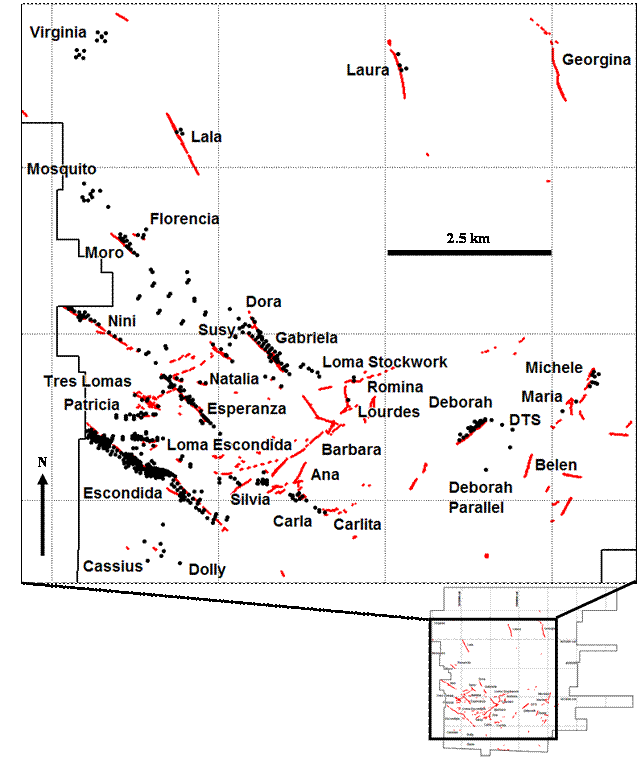
As at the end of 2008, Exeter had drilled a total of 175 drill holes for 23,702.9 metres, comprising 144 diamond holes for 11,741.4 metres and 31 RC percussion drill holes for 11,961.5 metres This includes RC percussion metres drilled as pre-collars to diamond drill holes. Drilling has traced the Escondida structure for approximately 3 kilometres, with approximately 2.5 kilometres of the
 | Technical Report (NI 43-101) – December 31st 2009 Exeter Resource Corporation
Cerro Moro Gold-Silver Project, Santa Cruz Province Argentina |
structure hosting significant gold-silver mineralisation. The mineralisation has been divided into five zones; Escondida Far West, Escondida West, Escondida Central, Escondida East and Escondida Far East.
During the resource estimation process in the first half of 2009, it became apparent to Exeter that the preliminary gold-silver inventory of the Escondida prospect, coupled with the high grades, would be sufficient to take the project to the next level. It was also known that the entire mineral resource for Escondida (and also the other prospects estimated) would be classified as Inferred. It was therefore decided to undertake a drilling program during the 2009 calendar year to upgrade the main areas of the Inferred Escondida resource to the Indicated mineral resource category. Assuming a drill spacing of approximately 20 x 20 metres would be appropriate a program of 18,000 metres was designed. This program initially focused in areas where the mineralisation could potentially be extracted by open pit methods, and to test the main high grade shoots in the deeper portions. It also included drilling to potentially expand portions of the resource, knowing that they would remain in the inferred category.
As at the end of December 2009, 275 diamond drill holes had been completed at Escondida during the 2009 calendar year for a total of 32,758.55 metres. Assay results were available for the first 195 of these holes.
Longitudinal projections, constructed in the plane of the main vein, have been prepared and colour coded based on estimated true widths multiplied by the gold equivalent values. Gold equivalent values have been calculated on the basis of the following parameters adopted by Exeter:
| • | Long term gold price US$800/Oz |
| • | Long term silver price US$14/Oz |
| • | Metallurgical recovery gold 100% |
| • | Metallurgical recovery silver 100% |
The gold equivalent value is calculated by dividing the silver grade (ppm) by 60 (approximate ratio of gold/silver US$ value) and adding it to the gold grade (ppm).
Figure 11.2 shows the entire known mineralised vein drilled to date at Escondida. Longitudinal projections and selected schematic cross-sections are shown for the five main zones within the Escondida prospect (Figure 11.3 to Figure 11.10).
A list of the pierce points with assay values used to construct the series of longitudinal projections is included in Appendix 1.
 | Technical Report (NI 43-101) – December 31st 2009 Exeter Resource Corporation
Cerro Moro Gold-Silver Project, Santa Cruz Province Argentina |
 | Technical Report (NI 43-101) – December 31st 2009 Exeter Resource Corporation
Cerro Moro Gold-Silver Project, Santa Cruz Province Argentina |
Figure 11.2 Escondida Total Project Longitudinal Projection - November 2009 Drilling (Local Grid)
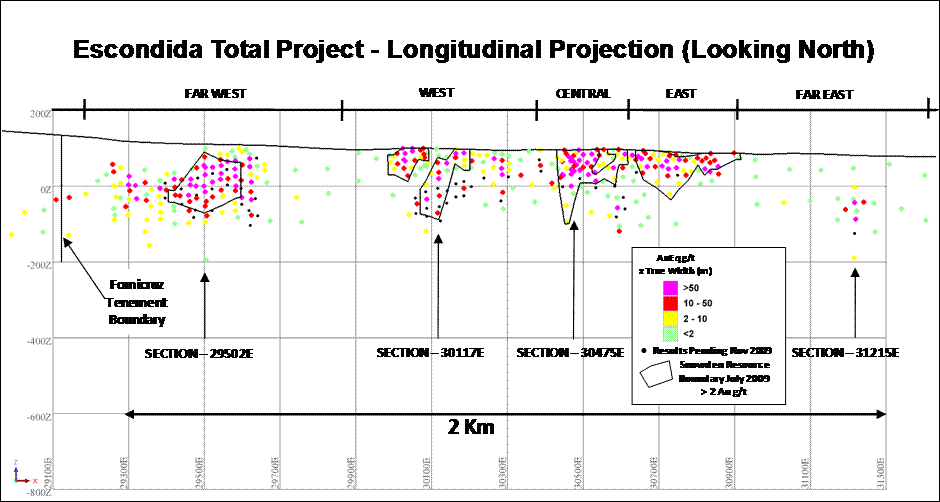
 | Technical Report (NI 43-101) – December 31st 2009 Exeter Resource Corporation
Cerro Moro Gold-Silver Project, Santa Cruz Province Argentina |
Figure 11.3 Escondida Far West Shoot - Longitudinal Projection - November 2009 Drilling (Local Grid)
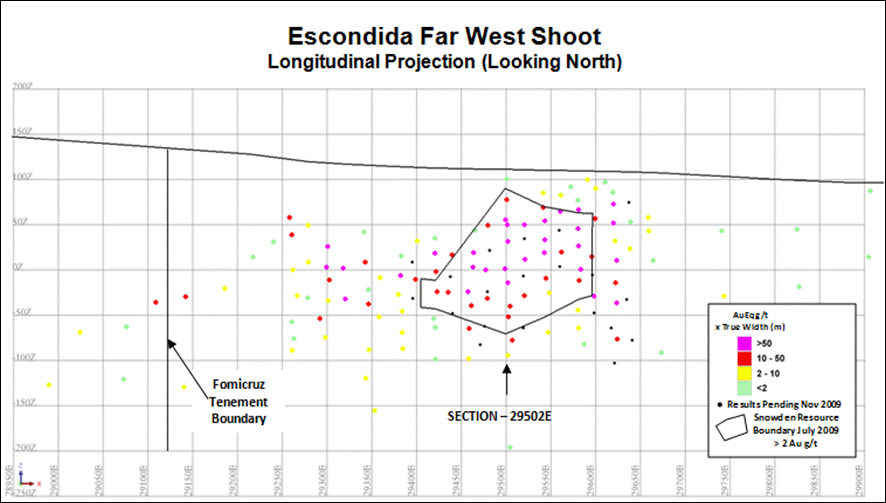
 | Technical Report (NI 43-101) – December 31st 2009 Exeter Resource Corporation
Cerro Moro Gold-Silver Project, Santa Cruz Province Argentina |
Figure 11.4 Escondida Far West Shoot - Schematic Cross-Section 29502E (Local Grid)
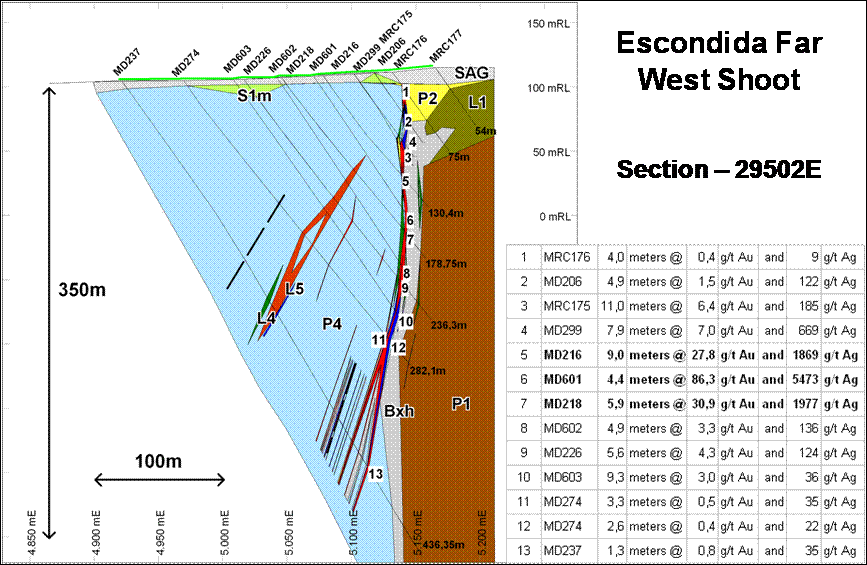
 | Technical Report (NI 43-101) – December 31st 2009 Exeter Resource Corporation
Cerro Moro Gold-Silver Project, Santa Cruz Province Argentina |
Figure 11.5 Escondida West Shoot - Longitudinal Projection - November 2009 Drilling (Local Grid)
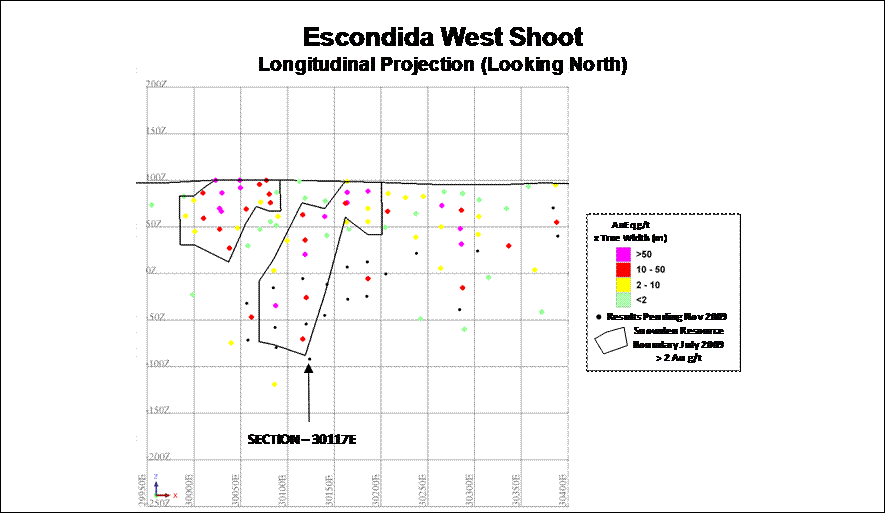
 | Technical Report (NI 43-101) – December 31st 2009 Exeter Resource Corporation
Cerro Moro Gold-Silver Project, Santa Cruz Province Argentina |
Figure 11.6 Escondida West Shoot - Schematic Cross-Section 30117E (Local Grid)
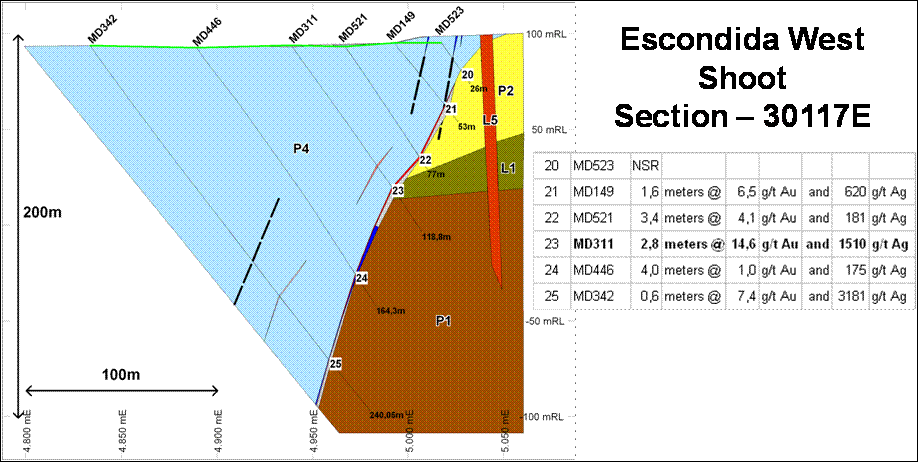
 | Technical Report (NI 43-101) – December 31st 2009 Exeter Resource Corporation
Cerro Moro Gold-Silver Project, Santa Cruz Province Argentina |
Figure 11.7 Escondida Central-East Shoots - Longitudinal Projection - November 2009 Drilling (Local Grid)
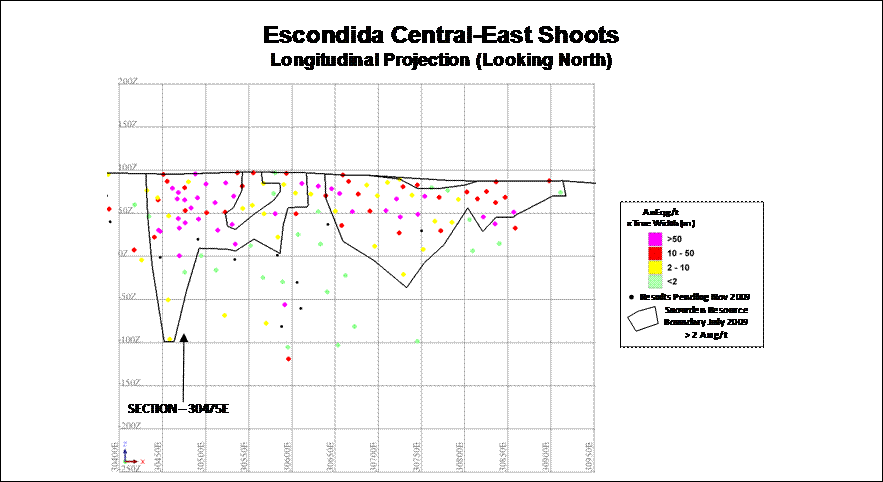
 | Technical Report (NI 43-101) – December 31st 2009 Exeter Resource Corporation
Cerro Moro Gold-Silver Project, Santa Cruz Province Argentina |
Figure 11.8 Escondida Central Shoot - Schematic Cross-Section 30475E (Local Grid)
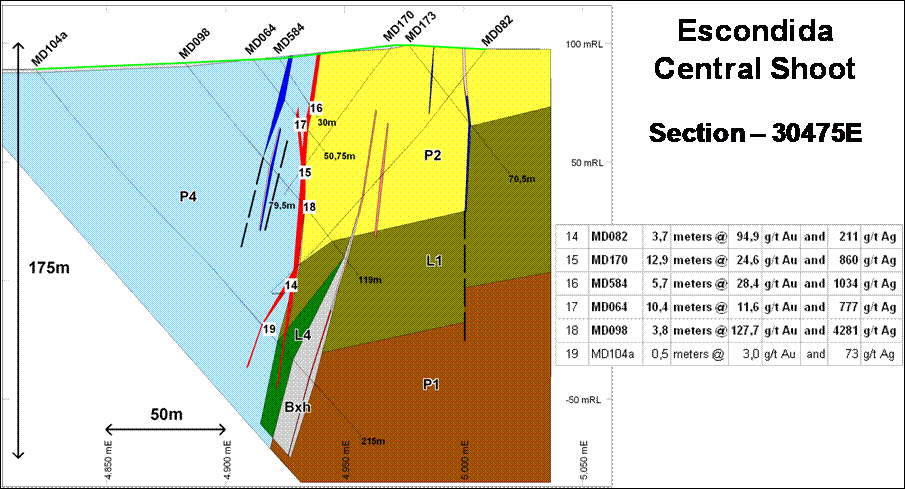
 | Technical Report (NI 43-101) – December 31st 2009 Exeter Resource Corporation
Cerro Moro Gold-Silver Project, Santa Cruz Province Argentina |
Figure 11.9 Escondida Far East Shoot - Longitudinal Projection - November 2009 Drilling (Local Grid)
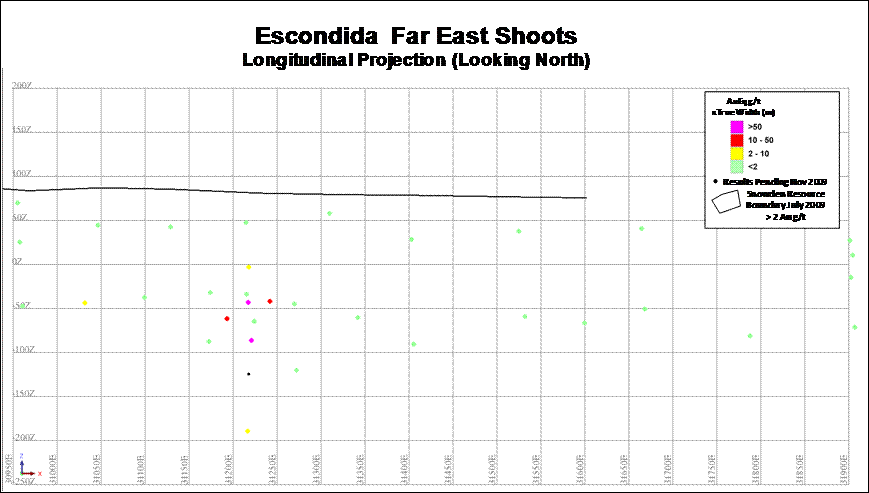
 | Technical Report (NI 43-101) – December 31st 2009 Exeter Resource Corporation
Cerro Moro Gold-Silver Project, Santa Cruz Province Argentina |
Figure 11.10 Escondida Far West Shoot - Schematic Cross-Section 21215E (Local Grid)
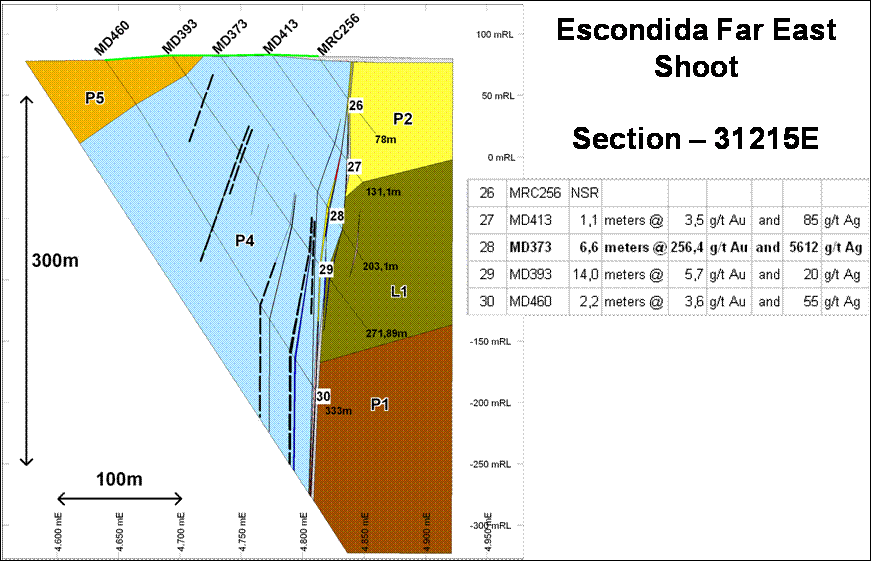
 | Technical Report (NI 43-101) – December 31st 2009 Exeter Resource Corporation
Cerro Moro Gold-Silver Project, Santa Cruz Province Argentina |
The Escondida Far West discovery was the result of scout fence drilling designed to locate the potential north-western extension of the main Escondida structure, in an area with extensive post mineralisation cover. The detailed ground magnetic data was utilised to estimate the position of the structure. None of the mineralisation outcrops at surface. In addition to being a blind mineralised body, near surface holes, as well as holes on the margin of the higher grade shoot, intersected only low grade to anomalous gold and silver values. This has implications over the entire property, where many of the veins are low grade near surface, and were previously assigned a low priority.
Additional infill drilling is still required at Far West, both internally within the high grade shoot, but more importantly, to also test for potential extensions where the mineralisation is still open; for example, below holes MD593, MD604, and MD471, and in the vicinity of hole MD609. The main mineralised shoot is still open to the west and down deep to the west.
11.1.2 | Escondida West, Central and East |
Following the discovery of the two higher grade shoots at the central and western portions of Escondida, drilling focussed on tracing these plunging zones. Initially Escondida Central and Escondida West were interpreted to be two separate veins systems, or represented a faulted offset of the structure. However, diamond drilling demonstrated that the two zones are in fact one continuous structural zone.
Drilling at Escondida Central during 2007 and 2008 focussed on the detailed delineation of bonanza-grade and high-grade shoots, to an approximate vertical depth of over 200 metres from surface.
Additional drilling is still required at Escondida West, particularly where the system is still open at depth. Infill drilling at 20 x 20 metres was initially directed at the zone from near surface to an approximate depth of 50 metres, and most of this has now been completed. Drilling to test deeper mineralisation and extensions is being conducted by firstly drilling at approximately 40 x 40 metres and awaiting assay results before deciding on additional follow-up and/or infill.
A significant event for Cerro Moro was the “bonanza” intercept in MD373 located at Escondida Far East in mid-2008. It was a “blind discovery” below shallow RC percussion holes that were drilled to test the south-eastern extension of the Escondida structure beneath gravel cover which was predicted by geophysical surveys. A number of additional holes have been drilled around MD373 all of which have returned lower tenor results. This area of Escondida Far East appears to the complex and additional drilling and interpretation is required prior to inclusion in any reportable resources.
As mentioned previously, 35 RC percussion drill holes have been drilled on eight new Cerro Moro targets, as summarised below
| 1. | MRC600 and MRC628 (11 holes); these drill holes were sited to test the Escondida Fault to a depth of 65-80m. MRC600 intersected 2 metres at a grade of 1.8 g/t Au from a down hole depth of 141 metres. No other significant results were returned. |
| 2. | MRC631 and MRC634; these drill holes were sited to test a conceptual target located 640 metres to the southeast of the Deborah mineralised structure, and designated as “Deborah Parallel” – this is an interpreted northeast trending structure observed in the ground magnetic data, and as the name suggests, it is parallel to the Deborah structure. The |
 | Technical Report (NI 43-101) – December 31st 2009 Exeter Resource Corporation
Cerro Moro Gold-Silver Project, Santa Cruz Province Argentina |
geological mapping conducted in 2008 also suggested a similar geological setting as to that observed at the Escondida prospect. No significant results were returned.
| 3. | MRC636 and MRC639; these two drill holes were sited to test the Deborah Termination Structure (“DTS”), clearly obvious in the ground magnetic data, but in an area under cover. No significant results were returned. |
| 4. | MRC641; this drill hole was sited to test an MT anomaly immediately southwest of the Gabriela mineralised structure. It was sited under cover and interpreted to trend northwest, parallel to Gabriela. MRC641 intersected 1 metre at a grade of 0.95 g/t Au from a down hole depth of 45 metres. |
| 5. | MRC643; this drill hole was sited to test an MT anomaly immediately north of the Escondida mineralised structure, which could represent a potential splay off the main Escondida structure. MRC641 intersected 1 metre at a grade of 1.05 g/t Au from a down hole depth of 48 metres. |
| 6. | MRC 645 and MRC648; these drill holes were sited as a follow-up hole in the Cassius structure, following the results of the 2008 drilling. No significant results were returned. |
| 7. | MRC649 and MRC651; these drill holes were sited to test two MT anomalies, located north of the Cassius structure, and designated as M2 and M1 respectively. Prior to drilling, close surface examinations revealed the presence of subtle quartz vein outcrop. No significant results were returned. |
| 8. | MRC654 to MRC659 (3 holes); these drill holes were sited to test the Bella Vista main structure. No significant results were returned. |
| 9. | MRC660; this drill hole was sited as a step back of MRC377, a 2008 drill hole that intersected 2 metres at a grade of 14.3 g/t Au from a down hole depth of 5 metres (which included 1 metre at a grade of 27.3 g/t Au from a down hole depth of 5 metres). The holes are located approximately 380 metres west of the Silvia prospect on a northeast trending structure. No significant results were returned. |
| 10. | MRC663 and MRC665; these two drill holes were sited to test a conceptual target located approximately 800 metres east of the eastern portion of the Escondida East prospect. The area contains surface alteration, anomalous LAG sampling and an east-west interpreted structure (observed in the ground magnetic data) that could represent a splay off the main Escondida structure. MRC663 returned no significant results. Results pending for MRC665. |
| 11. | MRC701 to MRC719 (4 holes); these drill holes were sited to test the Esperanza SE extension. Results pending. |
| 12. | MRC726 to MRC731 (3 holes); these scout drill holes were sited to test the eastern extension of the Escondida Far East structure. Results pending. |
| 13. | MRC747; test if the two main intersections at Carla are the same vein or 2 separate splays. Results pending. |
 | Technical Report (NI 43-101) – December 31st 2009 Exeter Resource Corporation
Cerro Moro Gold-Silver Project, Santa Cruz Province Argentina |
12.0 | SAMPLE METHOD AND APPROACH |
A comprehensive description of the sample method and approach prior to 2009 at Cerro Moro is detailed in Bargmann et al (2009) and Williams & Perkins (Exeter, 2009a), and these practices have remained the same during the 2009 drilling. Both of these documents have been previously lodged with the Canadian Securities Administrators and are available for viewing on SEDAR at http://www.sedar.com.
12.1 | Sample Procedures and Protocols |
No information is available on Mincorp´s sampling procedures and protocols.
All the diamond holes drilled by Exeter were orientated using the Ballmark system. The system uses gravity to make a mark on an aluminium disk with a small ball. This mark which represents the bottom of the hole in the oriented core. An Exeter technician on the drill site measures core recovery and draws an initial orientation line on the core. The drill core is then placed in marked wooden core boxes at the drill site and transported to the Exeter camp (located at the north-western corner of the property) for processing.
The orientation is verified at the camp before detailed geotechnical logging by trained specialist technicians. Geotechnical logging documents rock quality, which includes structural measurements of defects. All data is recorded on a metre by metre basis and include; recovery, rock quality designation (“RQD”), strength, weathering, and the orientation of fractures. Utilising the orientation line (which represents the bottom of the hole) “alpha” and “beta” measurements are taken of the fractures. The alpha angle is the angle between the fracture plane and core axis. The beta angle is the angle between the axis of the fracture and orientation line measured in clockwise direction. Knowing the alpha and beta angles of the fractures and the orientation of the hole (dip and azimuth), the true spatial position of the fractures can be calculated (dip and dip direction) using Dips software.
Core recoveries are estimated, per drill run, using the core marker blocks and are also calculated on a metre by metre basis. Good recoveries have been obtained with an average of over 95 percent.
Every diamond hole is digitally photographed, wet and dry, by technicians before cutting and sampling.
The geology is recorded by geologists following orientation of the core. The stratigraphic and lithologic units are recorded and entered into the data-base to allow the construction of geological sections. Alteration and mineralisation data are also recorded. Structural measurements of faults, veins and geological contact are taken with a Brunton compass in an orientation frame utilising the orientation line as a reference.
On completion of logging and photography a geologist marks the core for sampling. Sample lengths through the obvious mineralised zones vary between 0.3 and 1.5 metres dependent on geological and structural contacts, and these samples are classified as “high priority”. The remainder of each drill hole, classified as “low priority”, is generally sampled every one metre. To date, generally the complete hole has been sampled. Exeter technicians utilise a diamond saw on-site to cut the core in half. One half of the core is sampled and sent to the laboratory and the remaining half is stored on-site in the core boxes. The core saw is cleaned with a brick or other abrasive stone between each high priority sample to eliminate contamination between potential
 | Technical Report (NI 43-101) – December 31st 2009 Exeter Resource Corporation
Cerro Moro Gold-Silver Project, Santa Cruz Province Argentina |
high grade samples. The samples are placed in marked plastic bags, sealed and transported to the assay laboratory.
12.1.2 | RC Percussion Drilling |
RC percussion drilling samples are collected using a cyclone attached to the drill rig at one metre intervals. The geological logging is performed by Exeter geologists at the drill site. On completion of the logging the geologist determines the sample interval lengths of the high and low priority zones. The high priority, potentially mineralized, zones are sampled at one metre intervals and composite samples of three metres are collected through the low priority zones. Each of the one metre samples are stored in plastic bags and are weighed and recorded by technicians at the drill site. The geologist records the diameter of the drilling tools (bit and shoes) at the beginning and end of each hole and uses these measurements to calculate an estimated weight of each sample. In this way the recovery of each sample can be calculated, assuming a density of 2.5, where recoveries average above 85 percent. The sampling is performed at the Exeter camp by technicians, utilising a riffle splitter, where each metre sample is split 3 times. The average 1 metre sample weight is approximately 3 kilograms, with an average of 9 kilograms for the 3 metre composite samples.
12.2 | Density Determination |
This section is mostly summarised from Bargmann et al (2009).
Since August 2007, Exeter has routinely calculated the specific gravity (“SG”) from core samples at Cerro Moro. The methodology used is to calculate the ratio of the weight of sample in air to the difference between the weight in air and weight in water. Core samples, generally > 10 cm in length are oven dried to 100° C, sprayed with waterproof sealant and weighed. The sample is then weighed whilst suspended in water and the SG is calculated as follows:
Wp – Wps
Where:
Wp = Weight of the sealed sample
Wps = Weight of the sealed suspended sample in water
The SG data is recorded for all lithologies encountered and will be used as the basis for assigning density values in future scoping studies. Vein samples, which include all types of quartz vein lithologies, vein breccias and stockworks, have SG values that vary between 2.45 and 2.81. Non veins samples, which include all other stratigraphic units, have SG values that vary between 2.34 and 2.61. The variations of the vein results are interpreted to mostly reflect the sulphide content associated with the veins.
As part of the quality control process, a set of check samples were submitted to Mecanica de Rocas in Santiago, Chile for SG determination. Ninety five percent (95%) of the 106 samples returned an error of <5%.
 | Technical Report (NI 43-101) – December 31st 2009 Exeter Resource Corporation
Cerro Moro Gold-Silver Project, Santa Cruz Province Argentina |
13.0 | SAMPLE PREPARATION, ANALYSES AND SECURITY |
A comprehensive description of the sample preparation, analyses and security prior to 2009 at Cerro Moro is detailed in Bargmann et al (2009) and Williams & Perkins (Exeter, 2009a). Both of these documents have been previously lodged with the Canadian Securities Administrators and are available for viewing on SEDAR at http://www.sedar.com.
The only sample preparation conducted by Exeter is the diamond saw cutting of diamond drill core samples and riffle splitting for the RC percussion samples (as detailed in sections 12.1.1 and 12.1.2 respectively), and finally the bagging of the samples on site. All of this work is conducted by Exeter employees. No other part of the sample preparation or analysis process, as detailed in the following sections, is conducted by an employee, officer, director or associate of Exeter.
13.1 | Sample Preparation and Analysis |
During 2009 the majority of samples at Cerro Moro have been sent for preparation to the ACME Analytical Laboratories (Argentina) S.A. (“ACME”), located in Mendoza, Argentina, with analysis undertaken at the ACME laboratory in Santiago, Chile4. The sole exception was the first diamond drill hole that was dispatched to the ALS Chemex5 sample preparation facility in Mendoza, Argentina with analysis undertaken at the ALS Chemex laboratory in La Serena, Chile. At the time of preparing this report the samples from this diamond drill hole were in the process of being sent to ACME for analysis.
All of the batches of drilling samples dispatched to the ACME laboratory are flagged, on the sample dispatch order form, as either “high priority” (obvious mineralized zones) or “low priority” (not obviously mineralised).
A description of high and low priority sample preparation and analytical methods for ACME are detailed below in Sections 13.1.1.1 and 13.1.1.2.
13.1.1.1 | Procedures for High Priority Samples |
| • | Samples are received at ACME sample preparation facility in Mendoza, Argentina; |
| • | Sample dispatch details are checked against samples received and confirmed with client; |
| • | Samples numbers are entered into the laboratory information system and bar coded sample number stickers matching the client sample numbers are generated; |
| • | Each sample is weighed at sample reception; |
| • | Samples are oven dried at 60°C for a minimum of 24 hours; |
| • | Samples are crushed to 85% passing -2mm using a Boyd crusher followed by a Labtech rotary crusher; |
| • | A barren quartz wash is inserted at the beginning and end of each job number and at every tenth sample during the crushing phase; |
| • | A 500 gram split is obtained using a stainless steel riffle splitter; |
_________________________
4 The ACME laboratory in Mendoza is fully credited to ISO-9001:2000.
5 ALS Chemex is of the Mineral Division of the ALS Laboratory Group; where both the Argentine preparation facility and the Chilean laboratory are ISO-9001:2000 certified laboratories.
 | Technical Report (NI 43-101) – December 31st 2009 Exeter Resource Corporation
Cerro Moro Gold-Silver Project, Santa Cruz Province Argentina |
| • | Pulverising to 85% passing 200 mesh (-75 micron) is achieved using an LM2 or LM5 ring pulveriser (Code: R200-CRU85); |
| • | A barren quartz wash is inserted at the beginning and end of each job number and at every tenth sample during the pulverising phase; |
| • | Pulps are weighed prior to dispatch to ACME Santiago, Chile; |
| • | Au (50 gram) by fire assay and AAS (Code: G6) |
| • | When the grade of Au is higher than 10 parts per million (“ppm”), the samples are re-assayed by fire assay with a gravimetric finish (Code: G6 GRAV). |
| • | Ag (1 gram/100 millilitre) by 4 acid digestion and AAS (Code: 8TD) |
| • | When the grade of Ag is higher than 1000 ppm, the samples are re-assayed by fire assay with a gravimetric finish (Code: G6 GRAV). |
| • | 35 elements by hot aqua regia digestion and ICP-ES (Code: G1D + Hg + Tl) |
| • | Samples with >1 ppm Au are repeated by fire assay and AAS (Code: G6) |
| • | Au via screen fire assay, if required (Code: G6 SFA) |
13.1.1.2 | Procedures for Low Priority Samples |
| • | Crush, split and pulverise drill core to 200 mesh (Code: R200-CRU85) |
| • | Au (50 gram) by fire assay and AAS (Code: G6) |
| • | 33 elements by hot aqua regia digestion and ICP-ES (Code: G1D) |
13.1.2 | ALS Chemex Procedures |
The two batches of drilling samples dispatched to the ALS Chemex laboratory were flagged, on the sample dispatch order form, as either “high priority” (obvious mineralized zones) or “low priority” (not obviously mineralised).
A description of high and low priority sample preparation and analytical methods for ALS Chemex are detailed below in Sections 13.1.2.1 and 13.1.2.2.
13.1.2.1 | Procedures for High Priority Samples |
| • | All samples to be crushed to –2 mm (laboratory code CRU-31) and followed before and after with a barren flush (laboratory code WSH-21). |
| • | Whole sample to be pulverised to –75 micron (laboratory code PUL-21) |
| • | Assay Au by laboratory code Au-AA26 (50 gram Au fire assay; 0.01 to 100 parts per million (“ppm”) detection.) |
| • | Ag by laboratory code Ag-GRA21 (30 gram Ag fire assay with gravimetric finish; 5 to 10000 ppm detection) |
| • | Multi-elements analysis by laboratory code ME-MS61m (four acid near total digestion; 48 elements and mercury) |
| • | Samples with >1 ppm Au, repeat assay by laboratory code Au-AA26 (50 gram Au fire assay; 0.01 to 100 ppm detection). |
13.1.2.2 | Procedures for Low Priority Samples |
| • | Crush whole sample laboratory code CRU-31 (-2 mm). |
| • | Pulverise whole sample –75 micron laboratory code PUL-21 |
 | Technical Report (NI 43-101) – December 31st 2009 Exeter Resource Corporation
Cerro Moro Gold-Silver Project, Santa Cruz Province Argentina |
| • | Analyse Au by laboratory code Au-AA24 (50 gram fire assay with AAS finish 0.05 to 10 ppm detection. Retain all residue) |
| • | Ag by laboratory code AgAA-61 (four acid digest with AAS finish; 0.5 to 100 ppm detection) |
| • | Samples >1 Au re-assay by laboratory code laboratory code Au-AA24 |
Quality control procedures include the regular use of client initiated geochemical standards, sample duplicates (RC percussion and lag soil samples only), geochemical blanks, check assaying of samples returning greater than 1.0 g/t gold, and twins of existing drill holes. These are fully discussed in Section 14.0 Data Verification. The results from the quality control sampling demonstrate that there were no obvious errors or bias in the sample preparation or analysis, and as such no corrective actions were required.
Sampling of rock chips, trenches and rock chip channel samples, percussion chips and drill cores has been conducted on-site by Company personnel under the supervision of experienced Company geologists.
Assay samples are placed in sealed plastic bags with a numbered sample tag firmly stapled inside the bag. Depending on individual sample size, two to six samples are then placed in larger woven plastic bags which are then sealed with cable ties and numbered in readiness for transport to the laboratory.
The majority of Exeter samples were transported from site by Company vehicle to the bus station in either Caleta Olivia City or to Comodoro Rivadavia City. The samples were then transported by bus to the ALS Chemex preparation facility in Mendoza, Argentina. Commencing in July, 2008, due to the quantity of samples being generated at the time, samples were transported by a private contractor (30 tonne capacity truck) from site directly to the ACME sample preparation facility in Mendoza, Argentina.
The Author has witnessed all aspects of sample preparation and dispatch carried out by Exeter staff. In addition, the author has visited the ACME sample preparation facility in Mendoza, Argentina and found it to be a well organised, clean and high quality facility. Although the author has not visited the ACME analytical facility in Santiago, Chile there is no reason to doubt the integrity of this facility. In the author’s opinion, the sample preparation, security and analytical procedures employed by Exeter are consistent with standard industry practice particularly in the exploration for precious metals.
 | Technical Report (NI 43-101) – December 31st 2009 Exeter Resource Corporation
Cerro Moro Gold-Silver Project, Santa Cruz Province Argentina |
The various steps taken by Exeter to ensure the integrity of analytical data are consistent with standard industry practice particularly in the exploration for precious metals. The sampling procedures are consistent with the authors’ understanding of the style of mineralization and structural controls in the various deposits. The authors’ examination of drill cores, particularly in regard to the recognition of mineralized intervals verified the soundness of the core sampling procedure.
The author’s site visit to Cerro Moro between 12th and 20th December 2009 included field inspection and confirmation of the location of drill holes, the mineralised outcrops, and mineralisation in both drill core and RC percussion holes.
A comprehensive description of data verification at Cerro Moro prior to 2009 is detailed in Bargmann et al (2009), Williams & Perkins (Exeter, 2009a) and Williams (Exeter, 2009b). All three of these documents have been previously lodged with the Canadian Securities Administrators and are available for viewing on SEDAR at http://www.sedar.com. For completeness some of the sections from the previous reports are repeated below, either in full or part.
Exeter has no documentation of any QAQC procedures implemented or conducted by Mincorp. To the best knowledge of the author, none of the remaining pulp samples or coarse rejects exists of the original Mincorp laboratory assaying. None of the remaining samples from the RC percussion drill holes are available on-site. Of the diamond drilling, approximately 70% of half core is stored on-site, in varying condition. It is Exeter’s opinion that re-drilling of Mincorp drill holes is warranted in areas of interest or importance.
14.2.1 | Geochemical Standards |
Geochemical standards have been used by Exeter in all geochemical sampling and drilling programmes at Cerro Moro. From June 2003 to March 2007 one standard was inserted for every 40 samples. From March 2007, standards were frequently inserted every 20 samples. The majority of standards are provided by Geostats Pty. Ltd. (“Geostats”) of Australia. To date, a total of 2,129 standards have been used from over 20 different standard types with recommended assay values varying from 0.33 to 47.24 g/t Au. The assays provided by ACME have been statistically analysed and separated into categories according to the recommended standard values. This analysis demonstrated that the greatest irregularities are associated with the lowest grade standards, however, standards with higher than recommended values have returned more acceptable levels.
During 2009 Exeter routinely inserted 19 different commercially Certified Reference Materials (CRM) for laboratory quality control. At the time of writing this report, Cube was in the process of undertaking a preliminary review of the available QAQC data. As a starting point, Cube undertook a preliminary review of the 19 CRM results for 2009. The 19 line graphs for the individual assay results, graphed according to the recommended value, are displayed in Appendix 2.
In general, blanks (including CLG307-3) show acceptable performance with only 2 values exceeding 0.03 Au ppm both of which reported a gold grade of below 0.08 Au ppm. CRM G306-1 (Expected value 0.41 Au ppm) demonstrated a consistently low bias of nearly 10% across a large range of job numbers perhaps indicating an error in the expected CRM value. Two other CRM's, G901-7 (Expected value 1.52 Au ppm) and G999-3 (Expected value 6.3 Au ppm) also indicated a
 | Technical Report (NI 43-101) – December 31st 2009 Exeter Resource Corporation
Cerro Moro Gold-Silver Project, Santa Cruz Province Argentina |
consistent low bias across five job numbers. Reasons for this low bias will need to be followed up prior to the next resource estimation.

Technical Report (NI 43-101) – December 31st 2009 Exeter Resource Corporation
Cerro Moro Gold-Silver Project, Santa Cruz Province Argentina
The majority of other gold CRM's do not indicate the presence of consistent error or bias. Cube made some random checks of the database for CRM values that were outside two standard deviations of the expected value and noted that in all cases Exeter had highlighted these for follow-up.
Four CRM’s for silver with recommended assay values varying from 101.9 to 462.7 g/t Ag have been used since September 2009. At the time of this QAQC analysis only eight silver CRM values were available all of which reported acceptable performance.
14.3 | RC Percussion Duplicate Samples |
A total of 2 duplicate RC percussion samples were submitted to ACME for the only RC percussion drill hole reported during 2009. Both samples originally assayed below the detection limit of the assaying method, as did the assays of the duplicate samples.
14.4 | Diamond Drilling Duplicate Samples |
A total of 251 duplicate diamond drill samples were selected for ACME Chemex. As demonstrated in Figure 14.1 the correlation between the original and duplicate samples for gold is within accepted limits.
Figure 14.1 Diamond Duplicate Samples vs Original Sample – Au (g/t)

As demonstrated in Figure 14.2 to Figure 14.4 the correlation between the original and duplicate samples for silver for the three different assay methods are also within accepted limits; hot aqua regia digestion and ICP-ES (G1d-ES), by 4 acid digestion and AAS (8TD), and by fire assay with a gravimetric finish (G6 GRAV).
 | Technical Report (NI 43-101) – December 31st 2009 Exeter Resource Corporation
Cerro Moro Gold-Silver Project, Santa Cruz Province Argentina |
Figure 14.2 Diamond Duplicate Samples vs Original Sample – Ag (g/t) by Code G1D-ES
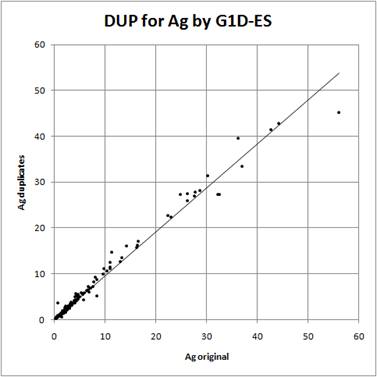
Figure 14.3 Diamond Duplicate Samples vs Original Sample – Ag (g/t) by Code 8TD
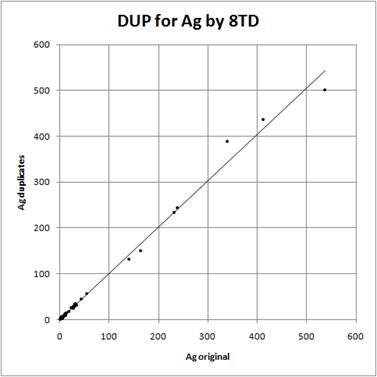
 | Technical Report (NI 43-101) – December 31st 2009 Exeter Resource Corporation
Cerro Moro Gold-Silver Project, Santa Cruz Province Argentina |
Figure 14.4 Diamond Duplicate Samples vs Original Sample – Ag (g/t) by Code G6 GRAV
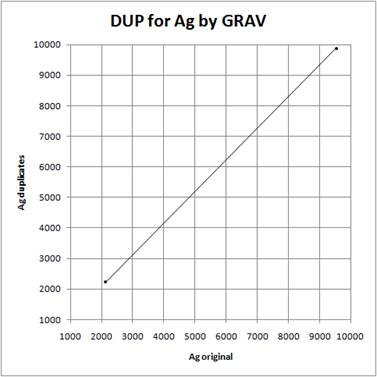
14.5 | Check Assaying of Samples Greater Than 1 g/t Au |
As part of the assaying procedure ACME re-assayed all samples that returned gold values of greater than 1.0 g/t Au. The plot of the original, versus duplicate diamond samples (a total of 288 pairs) indicates reasonable correlation suggesting a low nugget effect (refer to Figure 14.5). This re-assaying procedure also includes the geochemical standards (a total of 227 pairs), which also shows reasonable correlation (refer to Figure 14.6).
 | Technical Report (NI 43-101) – December 31st 2009 Exeter Resource Corporation
Cerro Moro Gold-Silver Project, Santa Cruz Province Argentina |
Figure 14.5 ACME Re-assays of diamond samples greater than 1 g/t Au
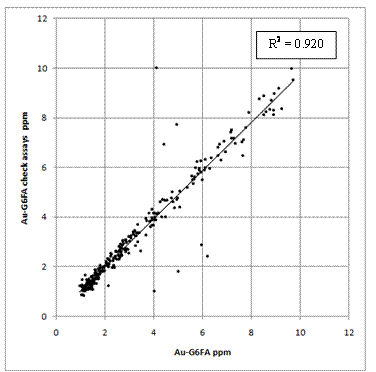
Figure 14.6 ACME Re-assays of geochemical standards greater than 1 g/t Au
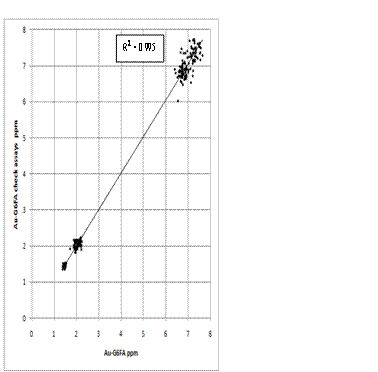
Geochemical blanks prepared from barren quartz have been submitted into the geochemical and drilling sample stream. From June 2003 to March 2007 the blanks were inserted every 40 samples. From March 2007 blanks were frequently inserted every 20 samples. These were offset with the standards giving a control sample every 10 samples.
Approximately 90% of the results assayed either below the detection limit (“BDL”) of 0.005 or the value 0.005 g/t Au.
 | Technical Report (NI 43-101) – December 31st 2009 Exeter Resource Corporation
Cerro Moro Gold-Silver Project, Santa Cruz Province Argentina |
As stated in Section 14.1 Exeter has no documentation of any QAQC procedures implemented or conducted by Mincorp. There are only three Mincorp drill holes at the Escondida prospect (all diamond drill holes), all located at Escondida West, and the two more significant drill holes were twinned.
Graphical logs of the 4 drill holes, displaying gold and silver results are presented in Appendix 3.
Since early 2007, the entering of new assay data has been the sole responsibility of Exeter’s Chief Draftsman and Database Manager in Argentina. The Cerro Moro ‘database’ originally consisted of a series of separate MS Excel files containing collar locations, down hole surveys, geological logging, and assays. A relational database utilising MS Access was developed during the last quarter of 2007, and came into general use during 2008.
 | Technical Report (NI 43-101) – December 31st 2009 Exeter Resource Corporation
Cerro Moro Gold-Silver Project, Santa Cruz Province Argentina |
Validation of the database has been a four stage process:
i. Perusal of existing Quality Control products (i.e.: blanks, geochemical standards and duplicates) to identify areas for further investigation.
ii Visual checking by the project geologist.
iii. Detailed valuation of all raw data
iv. Checking by senior Exeter personnel for simple errors utilising MS Excel and Micromine software packages.
14.9 | Data Verification by Cube |
14.9.1 | Drill Hole Collar Location |
Cube independently surveyed 69 drill hole locations using a hand held Garman 12XL GPS unit. Of the 69 holes only 60 holes had final survey locations recorded in the database. The remaining 9 holes were relatively recent and only had planned coordinates recorded in the database. All checked holes were drilled during 2009 and covered the full length of the Escondida prospect. No significant discrepancies were detected and all coordinates were within ±5m which is within the accuracy of the GPS unit used.
14.9.2 | Database Validation |
Cube undertook an extensive verification of the drill holes database whilst on site. Database verification included:
| 1. | A detailed overview of the database structure with Exeter's on-site database manager; |
| 2. | A detailed check of 1 in 10 drill holes drilled in 2009 including: |
| a. | Cross-validation of sample numbers from sample cutting sheet, sample dispatch tag book, Exeter dispatch number, laboratory job number and database; |
| b. | Cross-validation of certified reference material numbers between sample dispatch book and database; |
| c. | Cross-validation of original signed and scanned ACME lab assay reports against database; |
| d. | Check of downhole survey between original digital Reflex records and database; |
| e. | Check of database drill hole collar coordinates against original contract surveyor records. |
| 3. | At the time of writing this report, Cube had initiated the retrieval of pulp or coarse reject material from ACME for selected mineralised intervals for 1 in 10 holes covering all 2009 diamond drilling. Approximately 220 pulps will be sent to the Cube offices in Perth for independent analysis at a third party laboratory during early 2010. |
All logging, sampling and data QAQC procedures during 2009 have been carried out to a high industry standard and record keeping and database management is excellent. Cube believes that the current database provides an accurate and robust representation of the Cerro Moro project and is appropriate for ongoing resource evaluation.
 | Technical Report (NI 43-101) – December 31st 2009 Exeter Resource Corporation
Cerro Moro Gold-Silver Project, Santa Cruz Province Argentina |
“On 3rd March 2009 Exeter and Fomento Minera de Santa Cruz Sociedad del Estado6 (“Fomicruz”), the provincial mining company, signed a definitive agreement over ten Fomicruz concessions, covering 69,100 ha (691.0 km2), adjacent to Cerro Moro. Exeter will acquire an 80% interest in the Fomicruz properties by spending US10 M on exploration over a number of years. As part of this agreement Fomicruz will acquire a 5% participation interest in Exeter´s Cerro Moro project on the granting of the required exploitation concessions and permits to commence a mining operation. Exeter will manage and fund future exploration and development on both the Cerro Moro and Fomicruz concessions. Fomicruz will repay an agreed amount of its attributable exploration and development costs from the 50% of its share of the net revenue from future mining operations.” (Bargmann et al, 2009).
As can be seen in Figure 15.1 the Fomicruz properties border the south-western, southern and south-eastern portions of the Cerro Moro property.
Figure 15.1 Fomicruz Properties Location

Fomicruz is a provincial state entity and is not required to publicly release any results from their properties and as far as the author is aware they have not done so. Previous work on the property by Fomicruz is limited to preliminary minor geological mapping and rock chip sampling of selected veins.
Preliminary reconnaissance exploration by Exeter commenced during 2009 on the Fomicruz properties, working from the north to the south. The exploration methodology has been threefold:
| 1. | Regional stream sediment sampling, involving the collection of; |
| i. | An approximate 3 kilogram BLEG7 sample, -2mm to 5 mm size fraction. |
| ii. | An approximate 500 g of 2 mm to 4 mm size fraction. |
_________________________
6 Fomicruz is a company owned by the Government of Santa Cruz Province, Argentina.
7 BLEG = Bulk Leach Extractable Gold – utilises cyanide leach procedures for the extraction of gold, which are often used in grassroots exploration where cyanide extractable gold from a very large sample can sometimes detect small gold anomalies that otherwise would go undetected.
 | Technical Report (NI 43-101) – December 31st 2009 Exeter Resource Corporation
Cerro Moro Gold-Silver Project, Santa Cruz Province Argentina |
| iii. | Approximately 500 g of -2 mm size fraction |
During this program the geology, structure and any alteration is mapped at a scale of 1:25,000, along with rock chip sampling of any potentially or obviously mineralized structures.
| 2. | Ground magnetic data collection - Exeter purchased two GEM 19 Overhauser Magnetometers; a base station and a ‘walking’ magnetometer. The walking magnetometer is fitted with a GPS and was set to take readings every 2 seconds. As detailed in Williams and Perkins (2009) the majority of the Cerro Moro project was covered by either 40 metre or 80 metre spaced lines. This surveying is now being extended on to the Fomicruz tenements. The data will be used to assist with geological mapping, the identification of major structures (particularly those under cover), with the principal aim of identifying potential mineralised structures. |
| 3. | The current third phase is follow-up of any anomalous sampling results (stream sediment sampling or rock chip results) with more detailed mapping and the collection of additional rock chip samples. |
In addition to the regional exploration program described above, the two reconnaissance MT trial lines to the south of the Cerro Moro property (described in Section 10.3) were extended on to the Fomicruz ground for a total of 4.6 line kilometres. The TEM survey (described in Section 10.3) also extended to the south on to the Fomicruz ground for a total of 1.2 line kilometres. The locations of both of these surveys are displayed on Figure 15.2.
At this early stage of exploration on the Fomicruz property, two principal areas have been identified as priority for follow up work. The first is a new structure, named Bella Vista, and the second is the obvious extension of the Escondida mineralised structure in to the Fomicruz ground.
The Bella Vista prospect is a 4 kilometre long, predominantly east-west striking, structure, consisting of fault breccia, chalcedonic cement, and local black silica with fine grained sulphides (refer to Figure 15.2 for the location). It is anomalous in gold (up to 2.6 g/t), silver (up to 30 g/t), molybdenum (up to 350 ppm), arsenic, mercury, lead and zinc. It has a moderate to subtle signature in the ground magnetic data and the one trial MT survey line. Located approximately 300 metres to the south of this prospect is another structure represented by poor outcropping quartz/breccia outcrop, and interpreted to trend parallel to Bella Vista. Reconnaissance rock chip sampling of this area encountered gold grades up to 7.6 g/t.
As a first test of the above two prospects three RC percussion drill holes were drilled during September 2009. No significant results were returned from this initial scout drilling. The locations of the drill holes are displayed on Figure 15.2.
 | Technical Report (NI 43-101) – December 31st 2009 Exeter Resource Corporation
Cerro Moro Gold-Silver Project, Santa Cruz Province Argentina |
Figure 15.2 MT (dark blue lines) and TEM (light blue lines) Survey, Bella Vista Prospect and Drilling
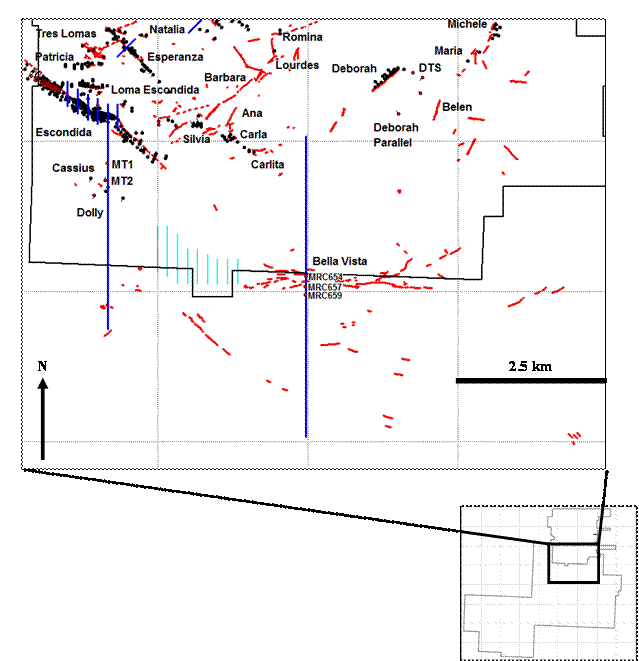
 | Technical Report (NI 43-101) – December 31st 2009 Exeter Resource Corporation
Cerro Moro Gold-Silver Project, Santa Cruz Province Argentina |
15.2 | Escondida-Fomicruz Prospect |
The Cerro Moro Escondida mineralised structure trends northwest into the Fomicruz property and is clearly evident to trend for approximately 2 kilometres in the ground magnetic data (refer to Figure 15.3).
Figure 15.3 Reduced to Pole Ground Magnetic Data with Escondida Extension (white dashed line)

 | Technical Report (NI 43-101) – December 31st 2009 Exeter Resource Corporation
Cerro Moro Gold-Silver Project, Santa Cruz Province Argentina |
The majority of the Escondida-Fomicruz structure is under cover and as such does not outcrop. The drilling strategy for this target is twofold;
| 1. | 40 metre step out drilling is being conducted from the last Exeter drill hole on the Cerro Moro property to the northwest. |
Since the beginning of September 2009, 5 diamond drill holes for a total of 1,490 metres have been drilled to target the Escondida Far West shoot on the Fomicruz property. The locations of the drill holes are displayed on Figure 15.4. Intercept results include:
MD653: Intersected mineralised structure at 208.88m (1.51 metres at a grade of 7.16 g/t gold and 197.79 g/t silver);
MD655: Intersected mineralised structure at 232.73m (1.1 metres at a grade of 1.24 g/t gold and 146.44 g/t silver);
MD667: Intersected mineralised structure at 312.4m (0.3 metres at a grade of 4.34 g/t gold and 262.0 g/t silver);
MD658: Intersected mineralised structure at 259.46m (0.94 metres at a grade of 3.37 g/t gold and 177.23 g/t silver);
MD669: Intersected mineralised structure at 330.0m (2.0 metres at a grade of 0.89 g/t gold and 51.6 g/t silver);
| 2. | Commencing in July 2009, ten drill sections, spaced approximately 160 metres apart, over a 1.6 kilometre strike length were drilled. A total of 11 RC percussion and 2 diamond drill holes were drilled, for a total of 1,512.0 metres. The position of the structure was successfully located on each section. The strategy of this drilling is the same as that conducted during 2007 and 2008 on the Cerro Moro Escondida structure. This led to the discovery of the Far West and Far East bonanza gold-silver shoots, where if no significant mineralisation is initially intersected, then the multi-element geochemistry is examined to assist with the planning of follow-up drilling. |
Drill hole MRC600, located 160 metres northwest of the last mineralized Escondida Far West sector hole designated MD405 (1.62 metres at a grade of 2.53 g/t gold and 100 g/t silver), returned 2.0 metres at a grade of 1.8 g/t gold and 1.2 g/t silver, from a down hole depth of 141.0 metres. Importantly, MRC600 was terminated at 146.0 metres but was not sampled below 143 metres due to poor sample recoveries.
On the next drill section, 160 metres northwest of MRC600, drill hole MD587 was sited too far to the northeast to hit the Escondida structure. The follow-up hole, MD588, sited as a step back hole, successfully intercepted the target but failed to return significant mineralization.
Subtle anomalous pathfinder element geochemistry in holes MD588 and MRC600 suggests these holes potentially intersected the Escondida structure immediately above the precious metal precipitation zone of the epithermal system. MRC622 returned 3.0 metres at a grade of 0.62 g/t gold and 0.15 g/t silver, from a down hole depth of 45 metres. No other significant gold or silver results were returned from the remaining RC percussion holes on the Fomicruz property.
The locations of the drill holes are displayed on Figure 15.4.
 | Technical Report (NI 43-101) – December 31st 2009 Exeter Resource Corporation
Cerro Moro Gold-Silver Project, Santa Cruz Province Argentina |
Figure 15.4 Escondida-Fomicruz Prospect – Drill Hole Locations
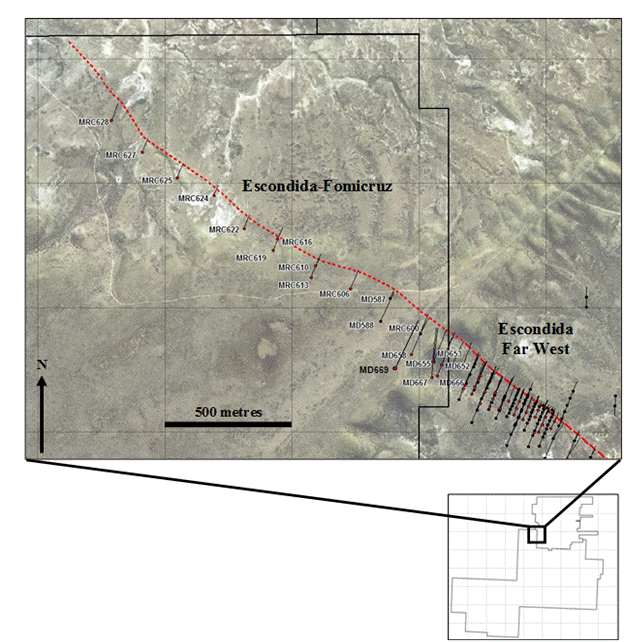
Exeter or the author is not aware of any other material information concerning any adjacent properties.
 | Technical Report (NI 43-101) – December 31st 2009 Exeter Resource Corporation
Cerro Moro Gold-Silver Project, Santa Cruz Province Argentina |
16.0 | MINERAL PROCESSING AND METALLURGICAL TESTING |
During 2007 and 2008 Exeter undertook extensive metallurgical testing. Samples from a number of vein systems were collected and subjected to comminution, cyanide leach, flash flotation, gravity and kinetic tests. The studies concluded that recoveries of 90% and greater for both gold and silver were achievable from a three stage process of gravity recovery, flash flotation and tailings leach.
The results and a comprehensive description of the mineral processing and metallurgical testing at Cerro Moro are detailed in Williams & Perkins (Exeter, 2009a). This document has been previously lodged with the Canadian Securities Administrators and is available for viewing on SEDAR at http://www.sedar.com.
 | Technical Report (NI 43-101) – December 31st 2009 Exeter Resource Corporation
Cerro Moro Gold-Silver Project, Santa Cruz Province Argentina |
17.0 | MINERAL RESOURCE AND MINERAL RESERVE ESTIMATES |
On July 8, 2009 Exeter announced the first NI 43-101 compliant mineral resource estimate for Cerro Moro. The independent resource estimate was prepared by Dr. S. C. Dominy, FGS (CGeol) FAusIMM (CP) MIMMM (CEng), General Manager (UK) and Executive Consultant, and Mr. C. J. Bargmann, FGS (CGeol) MAusIMM Pr.Sci.Nat, Principal Consultant, both of Snowden UK. Both Dr. Dominy and Mr. Bargmann are “independent” and “qualified persons” as defined in NI 43-101. The mineral resource estimate was prepared in accordance with CIM guidelines (CIM 2005) which have been adopted as part of NI 43-101.
A comprehensive description of the mineral resource estimate is detailed in Bargmann et al (2009). This document has been previously lodged with the Canadian Securities Administrators and is available for viewing on SEDAR at http://www.sedar.com.
A summary of the method and results follows:
Emphasis was placed on the Escondida, Loma Escondida, Esperanza and Gabriela veins which were deemed to have sufficient drill spacing and data quality to estimate inferred mineral resources. Two mineral resource estimates were prepared for the Escondida zone (which included the Loma Escondida zone): (i) a high grade option using a nominal 4 g/t Au cut-off in the definition of the mineralization shells, and (ii) a lower grade option using a nominal 2 g/t Au cut-off grade. The silver rich Esperanza and Gabriela zones were modelled using a nominal 150 g/t Ag cut-off in the definition of the mineralization shells, which is broadly equivalent to the 2 g/t Au option for Escondida. Snowden stresses that the cut-off grades used in the definition of the domains are geological in nature and are not economic cut-off grades.
Table 17.1 summarises the Inferred Mineral Resource for Escondida, Esperanza and Gabriela. These figures are based on the Escondida zone lower grade option (2 g/t Au cut-off grade) and the Esperanza/Gabriela zones utilising a 150 g/t Ag cut-off. The gold equivalent values shown in Table 17.1 were not calculated by Snowden in their original report.
Table 17.1 Inferred Mineral Resource for Escondida, Esperanza and Gabriela
Zone | Tonnes | Gold (g/t) | Silver (g/t) | Gold Equivalent Grade* (g/t) | Gold (ounces) | Silver (ounces) | Gold Equivalent Ounces* |
Esperanza/ Gabriela | 617,000 | 2.3 | 285 | 7 | 46,000 | 5,647,000 | 141,000 |
Escondida | 481,000 | 21.0 | 878 | 36 | 324,000 | 13,579,000 | 551,000 |
Total | 1,098,000 | 10.5 | 545 | 20 | 370,000 | 19,226,000 | 692,000 |
*Gold equivalent values have been calculated by Exeter on the basis of the following parameters:
| • | Long term gold price US$800/Oz |
| • | Long term silver price US$14/Oz |
| • | Metallurgical recovery gold 100% |
| • | Metallurgical recovery silver 100% |
 | Technical Report (NI 43-101) – December 31st 2009 Exeter Resource Corporation
Cerro Moro Gold-Silver Project, Santa Cruz Province Argentina |
The gold equivalent value is calculated by dividing the silver grade (ppm) by 60 (approximate ratio of gold/silver US$ value) and adding it to the gold grade (ppm).
Snowden adopted a polygonal-type approach to the resource estimate, whereby the mean of all drill and trench intersections within the domain boundary was applied to that domain. Extreme high-grades were topcut to reduce their effect, based on statistical analysis. Domain wireframes were constructed by careful geological interpretation, mindful of the gross continuity of the vein system being modelled. All intersections within a domain wireframe were used to estimate grade. Snowden noted that the Escondida, Loma Escondida, Esperanza and Gabriela zones are marked by the presence of several high grade mineralization shoots. The boundaries of these shoots with the surrounding low grade material are marked by a distinct grade drop. Snowden used the gold and silver grades as a key parameter in defining the geological domain boundaries of the high grade mineralization shoot domains. Snowden did not recommend a geostatistical/block modelling estimation approach at this stage. Geostatistical estimation requires the definition of the nugget effect and continuity ranges from variography which the wide data spacing does not currently permit. The current infill drill program includes close spaced drilling designed to assess the short range geological and grade variability which should facilitate the definition of relevant geostatistical parameters.
Table 17.2 to Table 17.4 summarise the Cerro Moro Inferred Mineral Resource estimates. The gold equivalent values shown in Table 17.2 to Table 17.4 were not calculated by Snowden in their original report.
Table 17.2 Escondida Zone - Inferred Mineral Resource based on a nominal 2 g/t Au ore shell boundary
Escondida Sub Zone | Tonnes | Gold (g/t) | Silver (g/t) | Gold Equivalent Grade* (g/t) | Gold (ounces) | Silver (ounces) | Gold Equivalent ounces* |
Far West | 124,000 | 23.6 | 1,723 | 52 | 94,000 | 6,870,000 | 208,000 |
West 1 | 31,000 | 24.1 | 431 | 31 | 24,000 | 430,000 | 31,000 |
West 2 | 71,000 | 9.9 | 627 | 20 | 23,000 | 1,432,000 | 47,000 |
Central | 105,000 | 38.0 | 962 | 54 | 128,000 | 3,247,000 | 182,000 |
East | 84,000 | 13.3 | 155 | 16 | 36,000 | 418,000 | 43,000 |
Loma Escondida | 46,000 | 8.8 | 537 | 18 | 13,000 | 795,000 | 26,000 |
Loma Escondida East | 20,000 | 10.2 | 603 | 20 | 7,000 | 387,000 | 13,000 |
Total | 481,000 | 21.0 | 878 | 36 | 324,000 | 13,579,000 | 551,000 |
 | Technical Report (NI 43-101) – December 31st 2009 Exeter Resource Corporation
Cerro Moro Gold-Silver Project, Santa Cruz Province Argentina |
Table 17.3 Escondida Zone - Inferred Mineral Resource based on a nominal 4 g/t Au ore shell boundary
Escondida Sub zone | Tonnes | Gold (g/t) | Silver (g/t) | Gold Equivalent Grade* (g/t) | Gold (ounces) | Silver (ounces) | Gold Equivalent Ounces* |
Far West | 117,000 | 25.0 | 1,828 | 55 | 94,000 | 6,875,000 | 209,000 |
West 1 | 20,000 | 35.1 | 588 | 45 | 23,000 | 378,000 | 28,000 |
West 2 | 38,000 | 13.5 | 773 | 26 | 16,000 | 945,000 | 32,000 |
Central | 70,000 | 51.3 | 1,296 | 73 | 116,000 | 2,917,000 | 164,000 |
East | 73,000 | 15.4 | 176 | 18 | 36,000 | 414,000 | 43,000 |
Loma Escondida | 35,000 | 10.6 | 650 | 21 | 12,000 | 732,000 | 24,000 |
Total | 353,000 | 26.1 | 1,080 | 44 | 297,000 | 12,260,000 | 499,000 |
Table 17.4 Gabriela and Esperanza Zones - Inferred Mineral Resource based on a nominal 150 g/t Ag ore shell boundary
Zone | Tonnes | Gold (g/t) | Silver (g/t) | Gold Equivalent Grade* g/t | Gold (ounces) | Silver (ounces) | Gold Equivalent Ounces* |
Esperanza Central | 96,000 | 2.4 | 252 | 7 | 7,000 | 778,000 | 20,000 |
Esperanza East | 36,000 | 5.0 | 192 | 8 | 6,000 | 222,000 | 10,000 |
Total Esperanza | 132,000 | 3.1 | 236 | 7 | 13,000 | 1,000,000 | 30,000 |
Gabriela 1 | 316,000 | 1.8 | 275 | 6 | 18,000 | 2,797,000 | 65,000 |
Gabriela 2 | 123,000 | 3.0 | 371 | 9 | 12,000 | 1,467,000 | 36,000 |
Gabriela 3 | 46,000 | 2.4 | 259 | 7 | 4,000 | 384,000 | 10,000 |
Total Gabriela | 485,000 | 2.1 | 298 | 7 | 33,000 | 4,647,000 | 110,000 |
Total | 617,000 | 2.3 | 285 | 7 | 46,000 | 5,647,000 | 141,000 |
* Note: Exeter has calculated gold equivalent grade by dividing the silver assay result by 60, adding it to the gold value and assuming 100% metallurgical recovery
 | Technical Report (NI 43-101) – December 31st 2009 Exeter Resource Corporation
Cerro Moro Gold-Silver Project, Santa Cruz Province Argentina |
18.0 | OTHER RELEVANT DATA AND INFORMATION |
Environmental base line studies started at the Cerro Moro project in mid-2008 with the objective of establishing the pre-development environmental and social characteristics of the project and its surrounds.
A meteorological station was established on site in August 2008 with the capability of measuring and recording a wide range of climatic factors to international standards, including wind speed and direction, temperatures, solar radiation, relative humidity and evaporation. The station was equipped with a data logger. The information will ultimately be analysed and compared with other official records in the Puerto Deseado region for base line comparisons.
In August 2008, on-the-ground baseline studies started under the supervision of Vector Engineering (“Vector”), a consultancy experienced in this type of work throughout Argentina. Vector’s main role was to co-ordinate and ensure the quality of a full range of base line studies being carried out by specialist contractors. The studies have included climate, flora, fauna, aquatic biology, geology, geomorphology, air quality, archaeology, palaeontology, hydrology, hydrogeology, and community, cultural and social aspects. The first stage of these studies is nearing completion.
In May 2008, Water Management Consultants Pty Ltd (a Schlumberger company; “WMC”) carried out a preliminary site survey and review of possible water sources to supply a potential Cerro Moro development. Exeter’s nominal requirements were assumed to be between 8 litres per second and 16 litres per second. WMC reported that in their view, alluvial aquifers and underlying fractured bedrock could be capable of supplying this quantity of water sustainably using several local endorheic basins which they identified. WMC suggested a program of work to investigate this possibility in detail which included drilling and pump testing.
In August and September 2009, Vector recommended a hydrology study that includes both the testing of possible water sources, as well as a program of vertical RC percussion drilling into the major veins that will potentially be utilised as dewatering holes during production. The prospects include; Escondida East, Escondida Central, Escondida West, Escondida, Far West, Gabriela, Esperanza, Deborah and the Silvia/Carla structure. These drilling programs commenced in mid-October 2009.
There is no other data or information known by the author that would be considered to be relevant to the Cerro Moro project at this time.
 | Technical Report (NI 43-101) – December 31st 2009 Exeter Resource Corporation
Cerro Moro Gold-Silver Project, Santa Cruz Province Argentina |
19.0 | INTERPRETATION AND CONCLUSIONS |
Improved geological, structural and mineralisation models developed over the past three years has led to the discovery of numerous high-grade gold-silver polymetallic veins at Cerro Moro. These base metal anomalous veins tend to be recessive and are represented on the surface by either very poor outcrop of quartz vein material or none at all. Extensive cover of Tertiary marine sediments and Quaternary gravels also hinder the location or extensions of the various veins and targets. Detailed ground magnetic survey data, coupled with IP and resistivity data, has highlighted potential targets that are initially tested via trenching, as in the case of the Escondida prospect.
Structures in east-west to northwest-southeast orientations are presently the preferred targets, where this orientation is interpreted to be tensional, pull apart structures resulting from minor strike-slip movement of the larger north-west structures. Examples include Loma Escondida and Carla, that both host high-grade gold-silver mineralisation. Escondida Central is an example of a high-grade gold-silver shoot in an east-west orientation on a major northwest trending structure.
The discontinuous ore shoots within the larger structures appear to be locally controlled by changes in strike, which are thought to have produced dilational flexures and jogs allowing for greater fluid flow. Changes in wall-rock lithology, along the structures, may be an important factor in controlling the local strike direction of the structures. It has also been noted that the brittle, felsic units have a tendency to produce stronger stock-work style vein development around the main structures than the intermediate units.
On July 8, 2009 Exeter announced the first NI 43-101 compliant mineral resource estimate for Cerro Moro, as detailed in Bargmann et al (2009).
During 2009, drilling has focussed primarily on the Escondida prospect, where, at the end of November 2009, 242 diamond drill holes had been completed for a total of 28,221.15 metres. Around 78% of the drilling by Exeter has been conducted on the Escondida, Gabriela, Esperanza and Loma Escondida propects, with over 65% of the drilling solely at the Escondida prospect.
The initial drilling program was designed during the first quarter of 2009 to upgrade the main areas of the Escondida Inferred mineral resource to the Indicated mineral resource category. Assuming that a drill spacing of approximately 20 x 20 metres would be appropriate a program of 18,000 metres was designed. This program was initially aimed to drill in areas where the mineralisation could potentially be extracted by open pit methods, and test the main high grade shoots in the deeper portions. The program also included was drilling to potentially expand portions of the resource, albeit to remain in the inferred category.
A review of the progress of the program in September 2009 resulted in the addition of approximately 100 drill holes for 15,000 metres, taking the overall program to over 30,000 metres in total. The aim is to complete a revised mineral resource in the first quarter of 2010, and with this deadline in mind, an additional two diamond drill rigs were mobilised to site during October 2009. Diamond drilling at Escondida was ongoing during December 2009 and there were three rigs active during Cube’s site visit between the 12th and 20th December 2009. Drilling activity ceased for the 2009 year on the 18th December and is scheduled to recommence at Escondida in the first half of January 2010. Having three diamond drill rigs on site will allow one to continue drill on the Fomicruz property, with the other two focussed on the infill drilling program.
 | Technical Report (NI 43-101) – December 31st 2009 Exeter Resource Corporation
Cerro Moro Gold-Silver Project, Santa Cruz Province Argentina |
Based on the significant gold and silver mineralisation encountered at the various prospects at Cerro Moro to date, coupled with the interpreted potential for new discoveries on the property, numerous work programs are recommended to progress the project to a potential development stage decision. A revised resource estimation, compliant with the CIM Mineral Resource and Mineral Reserve Definitions, of the various veins at Cerro Moro is to be completed during the first quarter of 2010.
A two component drilling program is proposed:
1. RESOURCE DRILLING: Continue the 2009 drilling program at Escondida to improve or extend the confidence of the new resource (compliant with the CIM Mineral Resource and Mineral Reserve Definitions). This infill program includes drilling to extend the known high grade Escondida gold-silver mineralisation laterally and at depth.
2. DISCOVERY DRILLING: Continue drilling new targets on the Cerro Moro property with the aim of discovering more Escondida-style mineralisation.
Upon receipt of the assay results from the RC percussion drilling, that tested selected MT geophysical anomalies, review the current geophysical methods and propose extensions to the current programs where warranted.
20.4 | Metallurgical Test Work |
It is proposed to apply the current flowsheet developed to all other significant shoots and also apply it to significant number of individual intercepts with widely different characteristics. This “variability” testwork will assist in further evaluating the robust nature of the flowsheet. In addition, metallurgical design testwork is proposed to start on aspects such as thickening, filtration and recovery of gold and silver from solution (“Merrill Crowe testwork”). More comminution testwork of a similar nature will be carried out to extend and confirm the results to date.
The current base line studies are continuing. It is proposed to review the year’s data with the consultants, and plan the detailed program that will be required to support environmental approvals and permits for development. As part of this work and as a preliminary stage of development planning, it is proposed to review and test some of the potential water sources suggested by WMC and Vector.
20.6 | Infrastructure and Engineering |
In-house engineering and mine planning studies are proposed that will lead to an in-house scoping study mid 2010. This work will continue through Quarter 2, 2010 and be completed to a level of quality to allow a decision to mine later in 2010.
A series of recommendations are proposed to ensure that future mineral resource and mineral reserve estimates are compliant with the CIM Mineral Resource and Mineral Reserve Definitions. These include:
 | Technical Report (NI 43-101) – December 31st 2009 Exeter Resource Corporation
Cerro Moro Gold-Silver Project, Santa Cruz Province Argentina |
1. The acquisition of appropriately detailed topographic data; be it from new detailed ground surveying, or controlled aerial photography-based digital topographic maps, or a combination of the both.
2. Continue the regular collection of bulk density measurements to ensure a statistically sound database to incorporate in future resource estimation.
3. Standard reference materials, specific for silver have been purchased and were incorporated in the QAQC program during September 2009. These will be routinely inserted, particularly in places where visible silver minerals are observed. A batch of existing samples have been selected for retesting the silver and upon the receipt of the results, it will be assessed as to whether any additional re-sampling and/or re-assaying is required to confirm the integrity of the existing silver results in the database.
4. At the end of the 2009 drilling program a selection of samples from the program will be sent for re-assay at an independent umpire laboratory as part of the continual quality control.
The work described above for Cerro Moro is budgeted to cost an approximate US $ 7,455,000 (refer Table 20.1) over a period of 12 months that includes 20,000 metres of drilling, commencing in January 2010. As future work programs are designed in detail, the associated costs will be updated.
Table 20.1 Proposed Preliminary Budget Estimate for Cerro Moro
| US $ |
Drilling | $ 2,100,000 |
Assaying | $ 750,000 |
Geological Supervision and Management | $ 550,000 |
Field Technicians | $ 250,000 |
Field Expenses/Travel/Food | $ 750,000 |
Environmental/Water/Metallurgy/Mining Studies | $ 2,500,000 |
Miscellaneous | $ 200,000 |
| |
SUM | $ 7,100,000 |
Contingency (5%) | $ 355,000 |
TOTAL | $ 7,455,000 |
The author considers the above listed recommendations and preliminary estimated budget as appropriate with the stage of the project and that Cerro Moro exhibits sufficient potential to justify the work.
 | Technical Report (NI 43-101) – December 31st 2009 Exeter Resource Corporation
Cerro Moro Gold-Silver Project, Santa Cruz Province Argentina |
Bargmann, C. J., Dominy, S.C., & Platten, I.M., 2009: Geological Review and Mineral Resource Estimate, September 2009 – Exeter Resource Corporation: Cerro Moro Project. , Snowden Mining Industry Consultants, Project No. L00154, Published (on SEDAR). |
Callan, N.J., 2008: Report to Accompany 1:10,000 Scale Geological Mapping, Cerro Moro Au-Ag Project, Puerto Deseado District, Santa Cruz Province, Patagonian Argentina., For Exeter Resource Corporation., Unpublished Company report dated 30 June 2008. |
Corbett, G., 2007i: Comments on the Cerro Moro and La Calandria Projects, Argentine Patagonia., For: Exeter Resource Corporation., Corbett Geological Services Pty. Ltd., Unpublished Company Report dated February 2007. |
Corbett, G., 2007ii: Further Comments on the Controls to Au-Ag Mineralisation at the Cerro Moro Project, Argentine Patagonia., Corbett Geological Services Pty. Ltd., Unpublished Company Report dated November 2007. |
Coughlin, T., 2005: Structural Controls on Low-Sulphidation Epithermal Gold-Silver Mineralisation in the Deseado Massif and Implications for Exploration, Santa Cruz Province, Argentina. For: Exeter Resource Corporation., Holcombe, Coughlin & Associates., Unpublished Company Report dated November 2005. |
Gómez, G., 2006: Informe Mensual, Interpretación Geológica de Magnetometría Terrestre, Área Tres Lomas-Patricia-Escondida., Exeter Resource Corporation., Unpublished Company Report dated October 2006. |
Grahame, A., 2007: Handover Report, Cerro Moro Project., Exeter Resource Corporation., Unpublished Company Report dated March 2007. |
Houston, M., 2007i: Cerro Moro Project Argentina, Campaign Report May 2007., Exeter Resource Corporation., Unpublished Company Report dated 15 June 2007. |
Houston, M., 2007ii: Cerro Moro Project Argentina, Campaign Report Sep – Oct, 2007., Exeter Resource Corporation., Unpublished Company Report dated 8 November 2007. |
Mason, R., 2008: Structural Controls on Mineralisation at Cerro Moro, Santa Cruz Province, Argentina., For Exeter Resource Corporation., Unpublished Company report dated September, 2008. |
Nash, C., 2004: Interpretation of Stereoscopic Aster Satellite Imagery, Cerro Moro Area, Southern Argentina. For: Exeter Resource Corporation., Colin Nash and Associates Pty. Ltd., Unpublished Company Report dated February 2004. |
Perkins, J. & Williams, M.T., 2007: Technical Report – Cerro Moro Project, Santa Cruz Province, Argentina., Exeter Resource Corporation, Published (on SEDAR) Company report dated November 26, 2007.
Perkins, J. & Williams, M.T., 2008: Technical Report – Cerro Moro Project, Santa Cruz Province, Argentina., Exeter Resource Corporation, Published (on SEDAR) Company report dated April 28, 2008.
Perkins, J. & Williams, M.T., 2009 (Exeter, 2009a): Technical Report – Cerro Moro Project, Santa Cruz Province, Argentina., Exeter Resource Corporation, Published (on SEDAR) Company report dated February 9, 2009.
 | Technical Report (NI 43-101) – December 31st 2009 Exeter Resource Corporation
Cerro Moro Gold-Silver Project, Santa Cruz Province Argentina |
Scarbrough, J., 2009: Final Report for Magneto-Telluric & Transient Electromagnetic Surveys at the Cerro Moro Project, Santa Cruz Province, Argentina., Zonge Ingeniería y Geofísica (Chile) S.A., Report Number CHJ #0910, Unpublished Company Report dated 25 August, 2009.
Van Kerkvoort, G., 2005: Cerro Moro – Evaluation Report., Exeter Resource Corporation., Unpublished Company Report dated September 2005.
Van Kerkvoort, G., Chacon, F., & Gargano, D., 2007: Notification of Completion of 10,000 Metres Drilling on the Cerro Moro Property report – Geological and Technical Data and Results from Exploration and Prospecting Work Conducted by Estelar Resources on the Cerro Moro Property., For Cerro Vanguardia S.A., Exeter Resource Corporation., Unpublished Company Report dated September 2007.
Williams, D.K., 2006: Preliminary Report on the Volcanic Stratigraphy and Proposed Ore Control and exploration Models for the Carla Prospect, Cerro Moro Property, Santa Cruz Province, Argentina., For: Exeter Resource Corporation., Dean K. Williams Consultant Geologist, Unpublished Company Report dated October 2006.
Williams, M.T., 2009 (Exeter, 2009b): Technical Report – Cerro Moro Project, Santa Cruz Province, Argentina., Exeter Resource Corporation, Published (on SEDAR) Company report dated October 30, 2009.
 | Technical Report (NI 43-101) – December 31st 2009 Exeter Resource Corporation
Cerro Moro Gold-Silver Project, Santa Cruz Province Argentina |
22.0 | DATE AND SIGNATURE PAGE |
22.1 | Certificate of the Qualified Person |
CERTIFICATE OF QUALIFIED PERSON
I, David (Ted) Coupland, do hereby certify that:
| 1. | I am a Director of Cube Consulting Pty Ltd of Level 4, 1111 Hay Street, West Perth 6005. |
| 2. | I am the author of the technical report titled “Independent Technical Report (NI 43-101), Update Report on the Cerro Moro Project, Santa Cruz Province, Argentina – December 31st, 2009" (the “Technical Report”) relating to the Cerro Moro Gold-Silver Project of Exeter Resource Corporation (the “Company”). |
| 3. | I graduated with a Bachelor of Science Degree (Geology) from the University of New England, Australia in 1987. In addition, I have obtained a Post Graduate Diploma in Mineral Economics from Macquarie University, Australia in 1995 and a Post Graduate Diploma in Applied Finance and Investment from the Securities Institute of Australia in 1997. Most recently, I have completed a Post Graduate Specialisation in Geostatistics (CFSG) from the Paris School of Mines, Fontainebleau, France in 2007. |
| 4. | I am a Chartered Professional Geologist and a current Member of the Australian Institute of Mining and Metallurgy (AusIMM No. 109925). I am also a member of the Mineral Industry Consultants Association (MICA). |
| 5. | I have worked as a geologist continuously for 22 years since my graduation from University. |
| 6. | I have read the definition of “qualified person” set out in National Instrument 43-101 (“NI43-101”) and certify that by reason of my education, affiliation with a professional association (as defined in NI 43-101) and past relevant work experience, I fulfil the requirements to be a “qualified person” for the purposes of NI 43-101. |
| 7. | I most recently personally inspected the Cerro Moro Gold-Silver Project from December 12th to December 20th 2009. |
| 8. | I am responsible for the preparation of all sections of this Technical Report. |
| 9. | I am independent of the Company in accordance with section 1.4 of NI 43-101. |
| 10. | I have had prior no involvement with the properties that are the subject of the Technical Report. |
| 11. | I have read NI 43-101 and Form 43-101F1 and the Technical Report has been prepared in compliance with that instrument and form. |
| 12. | As of the date of this certificate, to the best of my knowledge, information and belief, the Technical Report contains all scientific and technical information that is required to be disclosed to make the Technical Report not misleading. |
Dated at Perth, Australia this 6th day of February, 2010.

David (Ted) Coupland
BSc DipGeoSc CFSG ASIA MAusIMM CPGeo MMICA |
Director – Geological Consulting - Principal Geostatistician |
 | Technical Report (NI 43-101) – December 31st 2009 Exeter Resource Corporation
Cerro Moro Gold-Silver Project, Santa Cruz Province Argentina |
| APPENDIX 1. Data Used to Construct the Longitudinal Projections |
 | Technical Report (NI 43-101) – December 31st 2009 Exeter Resource Corporation
Cerro Moro Gold-Silver Project, Santa Cruz Province Argentina |
Prospect | Type | Hole ID | From (m) | To (m) | Length (m) | True Width (m) | Au g/t | Ag g/t | AuEq* | AuEq x TW** |
Escondida | Drillhole | DDH10 | 29.10 | 34.10 | 5.00 | 3.99 | 8.24 | 474.20 | 16.14 | 64.42 |
Escondida | Drillhole | DDH14 | 13.00 | 20.60 | 7.60 | 6.23 | 0.79 | 55.67 | 1.72 | 10.71 |
Escondida | Drillhole | DDH15 | 21.10 | 22.00 | 0.90 | 0.82 | 7.51 | 224.22 | 11.24 | 9.22 |
Escondida | Drillhole | MD061 | 38.53 | 41.20 | 2.67 | 1.64 | 27.25 | 245.10 | 31.34 | 51.39 |
Escondida | Drillhole | MD062 | 25.47 | 27.87 | 2.40 | 1.87 | 2.46 | 106.03 | 4.22 | 7.90 |
Escondida | Drillhole | MD064 | 30.00 | 40.40 | 10.40 | 7.73 | 11.65 | 777.09 | 24.60 | 190.16 |
Escondida | Drillhole | MD065 | 41.48 | 45.44 | 3.96 | 2.75 | 0.70 | 29.37 | 1.19 | 3.26 |
Escondida | Drillhole | MD082 | 131.30 | 135.00 | 3.70 | 1.68 | 96.16 | 211.29 | 99.68 | 167.46 |
Escondida | Drillhole | MD083 | 117.84 | 120.17 | 2.33 | 1.40 | 0.41 | 17.18 | 0.70 | 0.97 |
Escondida | Drillhole | MD085 | 61.00 | 64.00 | 3.00 | 2.67 | 1.70 | 30.15 | 2.20 | 5.87 |
Escondida | Drillhole | MD086 | 9.95 | 10.80 | 0.85 | 0.70 | 0.74 | 8.25 | 0.88 | 0.62 |
Escondida | Drillhole | MD087 | 26.00 | 32.07 | 6.07 | 4.29 | 6.77 | 148.09 | 9.24 | 39.63 |
Escondida | Drillhole | MD088 | 35.40 | 38.10 | 2.70 | 1.74 | 6.67 | 288.38 | 11.47 | 19.96 |
Escondida | Drillhole | MD089 | 77.15 | 80.00 | 2.85 | 2.33 | 29.86 | 1173.31 | 49.41 | 115.13 |
Escondida | Drillhole | MD090 | 67.00 | 69.70 | 2.70 | 2.07 | 30.89 | 229.07 | 34.71 | 71.84 |
Escondida | Drillhole | MD091 | 84.52 | 88.90 | 4.38 | 3.54 | 37.62 | 220.78 | 41.30 | 146.20 |
Escondida | Drillhole | MD095 | 40.10 | 47.00 | 6.90 | 5.29 | 20.61 | 766.49 | 33.39 | 176.62 |
Escondida | Drillhole | MD096 | 10.20 | 12.90 | 2.70 | 2.24 | 18.75 | 364.18 | 24.82 | 55.60 |
Escondida | Drillhole | MD097 | 67.00 | 67.72 | 0.72 | 0.59 | 2.02 | 2.14 | 2.05 | 1.21 |
Escondida | Drillhole | MD098 | 77.49 | 81.32 | 3.83 | 2.80 | 127.92 | 4281.34 | 199.28 | 557.97 |
Escondida | Drillhole | MD104a | 149.26 | 149.72 | 0.46 | 0.40 | 3.00 | 73.00 | 4.22 | 1.69 |
Escondida | Drillhole | MD105 | 105.00 | 110.00 | 5.00 | 4.24 | 1.70 | 261.57 | 6.06 | 25.68 |
Escondida | Drillhole | MD106 | 28.50 | 32.00 | 3.50 | 2.72 | 59.61 | 1886.76 | 91.05 | 247.66 |
Escondida | Drillhole | MD107 | 85.84 | 86.17 | 0.33 | 0.23 | 2.43 | 26.60 | 2.87 | 0.66 |
Escondida | Drillhole | MD108 | 23.08 | 24.06 | 0.98 | 0.75 | 18.19 | 619.19 | 28.50 | 21.38 |
Escondida | Drillhole | MD109 | 124.00 | 129.08 | 5.08 | 3.59 | 1.45 | 45.75 | 2.21 | 7.92 |
Escondida | Drillhole | MD110 | 26.00 | 32.00 | 6.00 | 4.46 | 12.82 | 277.26 | 17.43 | 77.75 |
Escondida | Drillhole | MD111 | 24.00 | 27.78 | 3.78 | 2.90 | 20.77 | 169.98 | 23.60 | 68.45 |
Escondida | Drillhole | MD112 | 100.40 | 106.66 | 6.26 | 4.43 | 17.62 | 1240.58 | 38.29 | 169.64 |
Escondida | Drillhole | MD113 | 45.20 | 51.36 | 6.16 | 5.22 | 3.01 | 13.33 | 3.23 | 16.84 |
Escondida | Drillhole | MD114 | 54.37 | 55.00 | 0.63 | 0.45 | 1.80 | 11.35 | 1.98 | 0.89 |
Escondida | Drillhole | MD115 | 53.90 | 55.73 | 1.83 | 1.25 | 34.45 | 2498.11 | 76.08 | 95.10 |
Escondida | Drillhole | MD116 | 49.74 | 52.47 | 2.73 | 2.00 | 0.36 | 24.30 | 0.76 | 1.53 |
Escondida | Drillhole | MD117 | 43.99 | 50.00 | 6.01 | 4.25 | 5.99 | 119.72 | 7.98 | 33.90 |
Escondida | Drillhole | MD118 | 46.00 | 52.60 | 6.60 | 4.83 | 15.74 | 26.69 | 16.18 | 78.17 |
Escondida | Drillhole | MD119 | 142.00 | 144.00 | 2.00 | 1.53 | 0.26 | 34.96 | 0.83 | 1.27 |
 | Technical Report (NI 43-101) – December 31st 2009 Exeter Resource Corporation
Cerro Moro Gold-Silver Project, Santa Cruz Province Argentina |
Prospect | Type | Hole ID | From (m) | To (m) | Length (m) | True Width (m) | Au g/t | Ag g/t | AuEq* | AuEq x TW** |
Escondida | Drillhole | MD120 | 81.57 | 81.96 | 0.39 | 0.27 | 0.27 | 15.90 | 0.53 | 0.14 |
Escondida | Drillhole | MD121 | 42.12 | 43.28 | 1.16 | 0.82 | 0.39 | 19.29 | 0.71 | 0.58 |
Escondida | Drillhole | MD122 | 39.70 | 42.00 | 2.30 | 1.81 | 0.77 | 14.57 | 1.01 | 1.83 |
Escondida | Drillhole | MD123 | 31.00 | 37.00 | 6.00 | 5.20 | 2.21 | 104.59 | 3.95 | 20.56 |
Escondida | Drillhole | MD124 | 29.70 | 30.00 | 0.30 | 0.26 | 0.46 | 3.10 | 0.51 | 0.13 |
Escondida | Drillhole | MD125 | 25.00 | 26.00 | 1.00 | 0.00 | 0.71 | 3.40 | 0.76 | 0.00 |
Escondida | Drillhole | MD127 | 6.00 | 7.80 | 1.80 | 1.47 | 0.63 | 3.20 | 0.68 | 1.00 |
Escondida | Drillhole | MD135 | 76.00 | 78.20 | 2.20 | 1.66 | 9.96 | 139.54 | 12.28 | 20.38 |
Escondida | Drillhole | MD136 | 63.00 | 74.00 | 11.00 | 8.43 | 0.63 | 77.91 | 1.93 | 16.27 |
Escondida | Drillhole | MD137 | 72.28 | 73.13 | 0.85 | 0.67 | 20.86 | 199.71 | 24.18 | 16.20 |
Escondida | Drillhole | MD139 | 30.72 | 33.97 | 3.25 | 2.00 | 33.84 | 539.83 | 42.84 | 85.67 |
Escondida | Drillhole | MD140 | 76.33 | 85.25 | 8.92 | 5.97 | 6.85 | 237.93 | 10.82 | 64.59 |
Escondida | Drillhole | MD142 | 114.00 | 116.89 | 2.89 | 2.04 | 0.38 | 18.24 | 0.68 | 1.39 |
Escondida | Drillhole | MD144 | 15.50 | 16.00 | 0.50 | 0.41 | 0.76 | 5.63 | 0.85 | 0.35 |
Escondida | Drillhole | MD145 | 50.00 | 51.60 | 1.60 | 1.31 | 0.95 | 152.92 | 3.49 | 4.58 |
Escondida | Drillhole | MD146 | 52.00 | 53.00 | 1.00 | 0.82 | 0.01 | 1.80 | 0.04 | 0.03 |
Escondida | Drillhole | MD147 | 22.77 | 24.00 | 1.23 | 0.98 | 0.31 | 6.24 | 0.41 | 0.40 |
Escondida | Drillhole | MD148 | 130.63 | 134.00 | 3.37 | 2.30 | 2.09 | 13.82 | 2.31 | 5.32 |
Escondida | Drillhole | MD149 | 41.00 | 42.55 | 1.55 | 1.24 | 6.53 | 620.41 | 16.87 | 20.92 |
Escondida | Drillhole | MD150 | 51.00 | 52.00 | 1.00 | 0.80 | 0.33 | 22.00 | 0.70 | 0.56 |
Escondida | Drillhole | MD151 | 98.40 | 99.20 | 0.80 | 0.59 | 11.61 | 26.45 | 12.05 | 7.11 |
Escondida | Drillhole | MD152 | 98.00 | 100.47 | 2.47 | 1.84 | 3.12 | 53.44 | 4.01 | 7.38 |
Escondida | Drillhole | MD153 | 25.38 | 27.35 | 1.97 | 1.37 | 0.84 | 30.51 | 1.35 | 1.84 |
Escondida | Drillhole | MD167 | 93.00 | 94.94 | 1.94 | 1.57 | 1.83 | 166.42 | 4.60 | 7.22 |
Escondida | Drillhole | MD168 | 84.97 | 86.00 | 1.03 | 0.93 | 0.91 | 42.70 | 1.62 | 1.51 |
Escondida | Drillhole | MD169 | 34.08 | 37.25 | 3.17 | 2.60 | 5.06 | 191.20 | 8.24 | 21.42 |
Escondida | Drillhole | MD170 | 64.10 | 77.00 | 12.90 | 6.45 | 24.56 | 860.29 | 38.90 | 250.90 |
Escondida | Drillhole | MD206 | 37.85 | 42.70 | 4.85 | 2.99 | 1.50 | 121.76 | 3.52 | 10.54 |
Escondida | Drillhole | MD214 | 29.00 | 33.00 | 4.00 | 2.41 | 0.65 | 30.67 | 1.16 | 2.81 |
Escondida | Drillhole | MD216 | 94.00 | 103.00 | 9.00 | 5.79 | 27.81 | 1868.54 | 58.95 | 341.32 |
Escondida | Drillhole | MD218 | 152.08 | 158.00 | 5.92 | 3.64 | 30.90 | 1976.57 | 63.84 | 232.37 |
Escondida | Drillhole | MD221 | 74.00 | 80.80 | 6.80 | 4.81 | 22.18 | 1555.20 | 48.10 | 231.34 |
Escondida | Drillhole | MD224 | 90.18 | 92.84 | 2.66 | 1.67 | 0.42 | 34.38 | 0.99 | 1.65 |
Escondida | Drillhole | MD226 | 196.45 | 202.00 | 5.55 | 3.64 | 4.32 | 252.37 | 8.52 | 31.02 |
Escondida | Drillhole | MD227 | 111.88 | 112.52 | 0.64 | 0.45 | 0.62 | 13.20 | 0.84 | 0.38 |
Escondida | Drillhole | MD228 | 78.00 | 83.00 | 5.00 | 4.33 | 13.31 | 716.48 | 25.25 | 109.33 |
 | Technical Report (NI 43-101) – December 31st 2009 Exeter Resource Corporation
Cerro Moro Gold-Silver Project, Santa Cruz Province Argentina |
Prospect | Type | Hole ID | From (m) | To (m) | Length (m) | True Width (m) | Au g/t | Ag g/t | AuEq* | AuEq x TW** |
Escondida | Drillhole | MD229 | 146.00 | 154.60 | 8.60 | 6.59 | 2.98 | 238.55 | 6.95 | 45.81 |
Escondida | Drillhole | MD233 | 173.72 | 175.40 | 1.68 | 1.19 | 4.40 | 325.83 | 9.83 | 11.70 |
Escondida | Drillhole | MD237 | 355.47 | 356.82 | 1.35 | 0.87 | 0.78 | 34.81 | 1.36 | 1.18 |
Escondida | Drillhole | MD249 | 119.00 | 121.00 | 2.00 | 1.97 | 0.34 | 9.78 | 0.50 | 0.98 |
Escondida | Drillhole | MD258 | 217.90 | 218.90 | 1.00 | 0.67 | 6.11 | 364.50 | 12.18 | 8.16 |
Escondida | Drillhole | MD259A | 185.96 | 195.85 | 9.89 | 7.23 | 1.86 | 195.73 | 5.12 | 36.99 |
Escondida | Drillhole | MD260 | 130.22 | 132.00 | 1.78 | 1.42 | 10.45 | 479.82 | 18.44 | 26.19 |
Escondida | Drillhole | MD261 | 68.00 | 72.00 | 4.00 | 3.63 | 0.90 | 45.53 | 1.66 | 6.03 |
Escondida | Drillhole | MD262 | 72.00 | 78.00 | 6.00 | 4.66 | 1.07 | 89.24 | 2.55 | 11.87 |
Escondida | Drillhole | MD268 | 252.00 | 253.50 | 1.50 | 0.94 | 0.26 | 31.60 | 0.78 | 0.73 |
Escondida | Drillhole | MD270 | 251.67 | 252.03 | 0.36 | 0.23 | 34.75 | 1305.00 | 56.50 | 13.00 |
Escondida | Drillhole | MD271 | 208.60 | 209.00 | 0.40 | 0.27 | 1.11 | 34.00 | 1.67 | 0.45 |
Escondida | Drillhole | MD274 | 252.28 | 255.58 | 3.30 | 2.53 | 0.46 | 39.69 | 1.12 | 2.83 |
Escondida | Drillhole | MD283 | 237.30 | 238.47 | 1.17 | 0.96 | 0.64 | 26.51 | 1.07 | 1.03 |
Escondida | Drillhole | MD288 | 182.45 | 183.15 | 0.70 | 0.49 | 1.48 | 201.00 | 4.83 | 2.37 |
Escondida | Drillhole | MD291 | 161.45 | 164.15 | 2.70 | 2.18 | 0.90 | 44.14 | 1.63 | 3.55 |
Escondida | Drillhole | MD292A | 33.00 | 36.03 | 3.03 | 1.95 | 1.54 | 53.58 | 2.43 | 4.74 |
Escondida | Drillhole | MD293 | 78.00 | 83.00 | 5.00 | 3.35 | 116.51 | 1891.67 | 148.03 | 495.91 |
Escondida | Drillhole | MD296 | 140.10 | 140.60 | 0.50 | 0.43 | 0.22 | 29.00 | 0.70 | 0.30 |
Escondida | Drillhole | MD298 | 22.20 | 31.40 | 9.20 | 6.51 | 4.32 | 134.26 | 6.56 | 42.68 |
Escondida | Drillhole | MD299 | 63.15 | 71.00 | 7.85 | 5.45 | 7.03 | 669.35 | 18.18 | 99.09 |
Escondida | Drillhole | MD301 | 237.57 | 239.11 | 1.54 | 1.18 | 0.66 | 31.02 | 1.18 | 1.39 |
Escondida | Drillhole | MD304 | 240.94 | 243.00 | 2.06 | 1.73 | 0.04 | 4.62 | 0.11 | 0.19 |
Escondida | Drillhole | MD307 | 191.78 | 192.38 | 0.60 | 0.50 | 0.52 | 28.95 | 1.00 | 0.50 |
Escondida | Drillhole | MD310 | 285.08 | 288.68 | 3.60 | 2.31 | 0.77 | 58.91 | 1.75 | 4.03 |
Escondida | Drillhole | MD311 | 89.00 | 91.75 | 2.75 | 2.57 | 14.58 | 1509.79 | 39.74 | 102.14 |
Escondida | Drillhole | MD340 | 124.12 | 124.70 | 0.58 | 0.53 | 20.95 | 54.00 | 21.85 | 11.58 |
Escondida | Drillhole | MD342 | 205.95 | 206.55 | 0.60 | 0.52 | 7.44 | 3181.00 | 60.46 | 31.44 |
Escondida | Drillhole | MD344 | 143.00 | 143.87 | 0.87 | 0.73 | 0.75 | 16.70 | 1.02 | 0.74 |
Escondida | Drillhole | MD345 | 98.00 | 99.65 | 1.65 | 1.46 | 0.40 | 14.23 | 0.63 | 0.93 |
Escondida | Drillhole | MD346 | 340.00 | 342.94 | 2.94 | 2.41 | 0.52 | 63.48 | 1.57 | 3.79 |
Escondida | Drillhole | MD348 | 270.00 | 273.12 | 3.12 | 2.21 | 1.56 | 40.66 | 2.23 | 4.93 |
Escondida | Drillhole | MD354 | 171.00 | 172.00 | 1.00 | 0.79 | 0.16 | 22.60 | 0.54 | 0.43 |
Escondida | Drillhole | MD373 | 150.45 | 157.00 | 6.55 | 4.63 | 172.84 | 5752.27 | 268.70 | 1244.10 |
Escondida | Drillhole | MD379 | 77.90 | 78.00 | 0.10 | 0.09 | 0.01 | 0.70 | 0.02 | 0.00 |
Escondida | Drillhole | MD389 | 65.00 | 73.00 | 8.00 | 5.56 | 30.65 | 2734.53 | 76.22 | 423.77 |
 | Technical Report (NI 43-101) – December 31st 2009 Exeter Resource Corporation
Cerro Moro Gold-Silver Project, Santa Cruz Province Argentina |
Prospect | Type | Hole ID | From (m) | To (m) | Length (m) | True Width (m) | Au g/t | Ag g/t | AuEq* | AuEq x TW** |
Escondida | Drillhole | MD393 | 200.00 | 214.00 | 14.00 | 9.55 | 5.73 | 20.21 | 6.06 | 57.90 |
Escondida | Drillhole | MD395 | 159.60 | 160.25 | 0.65 | 0.40 | 0.97 | 16.01 | 1.23 | 0.49 |
Escondida | Drillhole | MD396 | 146.06 | 146.41 | 0.35 | 0.24 | 1.24 | 8.21 | 1.37 | 0.33 |
Escondida | Drillhole | MD398 | 110.00 | 115.00 | 5.00 | 3.83 | 21.42 | 1454.47 | 45.66 | 174.86 |
Escondida | Drillhole | MD399 | 203.00 | 205.00 | 2.00 | 1.15 | 0.43 | 7.68 | 0.56 | 0.64 |
Escondida | Drillhole | MD400 | 171.50 | 171.90 | 0.40 | 0.25 | 4.52 | 12.85 | 4.73 | 1.18 |
Escondida | Drillhole | MD405 | 172.00 | 182.00 | 10.00 | 6.69 | 0.84 | 28.12 | 1.31 | 8.77 |
Escondida | Drillhole | MD413 | 105.00 | 106.10 | 1.10 | 0.66 | 3.50 | 85.36 | 4.91 | 3.24 |
Escondida | Drillhole | MD414 | 241.00 | 242.47 | 1.47 | 0.80 | 1.01 | 3.35 | 1.06 | 0.85 |
Escondida | Drillhole | MD415 | 208.00 | 209.36 | 1.36 | 0.87 | 1.35 | 9.20 | 1.50 | 1.31 |
Escondida | Drillhole | MD417 | 163.87 | 166.08 | 2.21 | 1.42 | 0.53 | 17.24 | 0.81 | 1.15 |
Escondida | Drillhole | MD418 | 154.31 | 155.09 | 0.78 | 0.47 | 1.97 | 16.82 | 2.25 | 1.06 |
Escondida | Drillhole | MD419 | 164.15 | 165.00 | 0.85 | 0.60 | 3.61 | 43.60 | 4.34 | 2.60 |
Escondida | Drillhole | MD421 | 164.50 | 165.15 | 0.65 | 0.55 | 1.16 | 13.45 | 1.38 | 0.76 |
Escondida | Drillhole | MD444 | 107.60 | 110.00 | 2.40 | 1.89 | 2.69 | 117.36 | 4.65 | 8.78 |
Escondida | Drillhole | MD445 | 152.46 | 156.50 | 4.04 | 3.50 | 8.26 | 633.92 | 18.82 | 65.88 |
Escondida | Drillhole | MD446 | 142.50 | 146.50 | 4.00 | 3.35 | 1.05 | 175.13 | 3.96 | 13.27 |
Escondida | Drillhole | MD448 | 172.20 | 173.00 | 0.80 | 0.65 | 0.26 | 17.35 | 0.54 | 0.35 |
Escondida | Drillhole | MD449 | 110.12 | 110.70 | 0.58 | 0.55 | 3.45 | 83.97 | 4.85 | 2.67 |
Escondida | Drillhole | MD450 | 166.75 | 169.00 | 2.25 | 1.45 | 4.56 | 125.27 | 6.65 | 9.64 |
Escondida | Drillhole | MD451 | 198.67 | 199.60 | 0.93 | 0.67 | 2.65 | 139.97 | 4.98 | 3.34 |
Escondida | Drillhole | MD452 | 120.30 | 120.60 | 0.30 | 0.23 | 0.13 | 8.19 | 0.26 | 0.06 |
Escondida | Drillhole | MD453 | 107.60 | 108.12 | 0.52 | 0.33 | 3.04 | 223.00 | 6.75 | 2.23 |
Escondida | Drillhole | MD454 | 173.50 | 178.19 | 4.69 | 2.82 | 44.23 | 71.04 | 45.41 | 128.06 |
Escondida | Drillhole | MD455 | 198.85 | 199.53 | 0.68 | 0.48 | 2.38 | 65.85 | 3.48 | 1.67 |
Escondida | Drillhole | MD456 | 133.15 | 133.85 | 0.70 | 0.45 | 1.79 | 20.50 | 2.13 | 0.96 |
Escondida | Drillhole | MD457 | 91.05 | 92.05 | 1.00 | 0.64 | 1.51 | 56.40 | 2.45 | 1.57 |
Escondida | Drillhole | MD458 | 94.06 | 95.62 | 1.56 | 1.25 | 0.71 | 22.58 | 1.08 | 1.35 |
Escondida | Drillhole | MD459 | 44.00 | 52.00 | 8.00 | 5.35 | 8.82 | 139.90 | 11.15 | 59.67 |
Escondida | Drillhole | MD460 | 317.44 | 319.60 | 2.16 | 1.39 | 3.61 | 59.21 | 4.59 | 6.38 |
Escondida | Drillhole | MD461 | 158.20 | 160.20 | 2.00 | 1.12 | 0.56 | 6.48 | 0.66 | 0.74 |
Escondida | Drillhole | MD462 | 178.65 | 179.45 | 0.80 | 0.51 | 1.08 | 45.00 | 1.83 | 0.93 |
Escondida | Drillhole | MD463 | 190.70 | 191.00 | 0.30 | 0.17 | 1.01 | 7.58 | 1.14 | 0.19 |
Escondida | Drillhole | MD464 | 174.40 | 175.20 | 0.80 | 0.46 | 0.60 | 8.81 | 0.74 | 0.34 |
Escondida | Drillhole | MD465 | 225.57 | 225.87 | 0.30 | 0.20 | 3.92 | 360.00 | 9.92 | 1.98 |
Escondida | Drillhole | MD466 | 198.25 | 198.80 | 0.55 | 0.39 | 3.81 | 218.00 | 7.45 | 2.91 |
 | Technical Report (NI 43-101) – December 31st 2009 Exeter Resource Corporation
Cerro Moro Gold-Silver Project, Santa Cruz Province Argentina |
Prospect | Type | Hole ID | From (m) | To (m) | Length (m) | True Width (m) | Au g/t | Ag g/t | AuEq* | AuEq x TW** |
Escondida | Drillhole | MD467 | 165.60 | 166.94 | 1.34 | 1.16 | 11.05 | 383.63 | 17.44 | 20.23 |
Escondida | Drillhole | MD468 | 60.00 | 71.23 | 11.23 | 8.60 | 3.78 | 188.71 | 6.93 | 59.59 |
Escondida | Drillhole | MD469 | 122.13 | 129.12 | 6.99 | 4.68 | 6.25 | 289.78 | 11.08 | 51.83 |
Escondida | Drillhole | MD470 | 187.40 | 189.30 | 1.90 | 1.14 | 1.04 | 104.60 | 2.79 | 3.18 |
Escondida | Drillhole | MD471 | 200.20 | 206.58 | 6.38 | 4.10 | 1.74 | 147.16 | 4.19 | 17.17 |
Escondida | Drillhole | MD472 | 38.24 | 39.20 | 0.96 | 0.76 | 0.80 | 10.00 | 0.97 | 0.74 |
Escondida | Drillhole | MD473 | 77.53 | 78.61 | 1.08 | 0.71 | 0.92 | 63.69 | 1.98 | 1.41 |
Escondida | Drillhole | MD474 | 130.26 | 133.10 | 2.84 | 1.59 | 3.87 | 423.14 | 10.92 | 17.36 |
Escondida | Drillhole | MD475 | 137.65 | 141.00 | 3.35 | 2.02 | 28.57 | 2313.72 | 67.14 | 135.61 |
Escondida | Drillhole | MD476 | 148.85 | 151.80 | 2.95 | 2.01 | 3.20 | 245.37 | 7.29 | 14.65 |
Escondida | Drillhole | MD477 | 141.60 | 142.70 | 1.10 | 0.90 | 1.78 | 182.00 | 4.81 | 4.33 |
Escondida | Drillhole | MD478 | 132.00 | 134.00 | 2.00 | 1.64 | 0.80 | 24.80 | 1.22 | 1.99 |
Escondida | Drillhole | MD479 | 105.00 | 120.25 | 15.25 | 12.34 | 11.81 | 471.41 | 19.67 | 242.75 |
Escondida | Drillhole | MD480 | 199.33 | 200.70 | 1.37 | 1.29 | 1.11 | 32.78 | 1.65 | 2.13 |
Escondida | Drillhole | MD481 | 175.35 | 180.00 | 4.65 | 2.67 | 4.38 | 462.85 | 12.10 | 32.31 |
Escondida | Drillhole | MD482 | 204.00 | 205.00 | 1.00 | 0.56 | 0.48 | 2.80 | 0.52 | 0.29 |
Escondida | Drillhole | MD483 | 237.15 | 240.00 | 2.85 | 1.75 | 2.37 | 10.54 | 2.55 | 4.46 |
Escondida | Drillhole | MD484 | 158.29 | 161.37 | 3.08 | 2.02 | 1.64 | 45.10 | 2.39 | 4.83 |
Escondida | Drillhole | MD485 | 205.60 | 212.55 | 6.95 | 4.65 | 0.78 | 40.66 | 1.46 | 6.78 |
Escondida | Drillhole | MD486 | 30.10 | 36.00 | 5.90 | 3.55 | 0.55 | 26.17 | 0.99 | 3.51 |
Escondida | Drillhole | MD487 | 21.00 | 22.30 | 1.30 | 1.02 | 2.06 | 67.46 | 3.18 | 3.25 |
Escondida | Drillhole | MD488 | 21.00 | 22.00 | 1.00 | 0.79 | 0.67 | 0.70 | 0.68 | 0.54 |
Escondida | Drillhole | MD489 | 10.45 | 11.80 | 1.35 | 1.06 | 5.57 | 8.40 | 5.71 | 6.05 |
Escondida | Drillhole | MD490 | 26.00 | 27.00 | 1.00 | 0.72 | 1.64 | 3.60 | 1.70 | 1.22 |
Escondida | Drillhole | MD491 | 12.80 | 13.40 | 0.60 | 0.43 | 0.59 | 1.50 | 0.61 | 0.26 |
Escondida | Drillhole | MD492 | 10.00 | 14.60 | 4.60 | 2.64 | 101.10 | 2507.13 | 142.89 | 377.22 |
Escondida | Drillhole | MD493 | 41.00 | 46.60 | 5.60 | 3.37 | 16.39 | 488.70 | 24.54 | 82.69 |
Escondida | Drillhole | MD494 | 5.00 | 13.15 | 8.15 | 4.90 | 1.60 | 15.03 | 1.85 | 9.07 |
Escondida | Drillhole | MD495 | 8.00 | 13.00 | 5.00 | 3.15 | 2.53 | 52.17 | 3.40 | 10.70 |
Escondida | Drillhole | MD496 | 53.76 | 56.75 | 2.99 | 1.88 | 2.27 | 158.97 | 4.91 | 9.23 |
Escondida | Drillhole | MD497 | 21.10 | 23.30 | 2.20 | 1.82 | 0.58 | 35.07 | 1.16 | 2.12 |
Escondida | Drillhole | MD498 | 47.46 | 51.92 | 4.46 | 2.68 | 5.56 | 130.18 | 7.73 | 20.71 |
Escondida | Drillhole | MD499 | 6.00 | 13.60 | 7.60 | 4.57 | 28.28 | 484.75 | 36.36 | 166.17 |
Escondida | Drillhole | MD500 | 53.78 | 56.65 | 2.87 | 2.38 | 0.34 | 20.79 | 0.68 | 1.62 |
Escondida | Drillhole | MD501 | 47.00 | 52.85 | 5.85 | 3.36 | 10.64 | 94.08 | 12.21 | 41.01 |
Escondida | Drillhole | MD502 | 8.00 | 15.00 | 7.00 | 4.77 | 0.88 | 48.26 | 1.69 | 8.04 |
 | Technical Report (NI 43-101) – December 31st 2009 Exeter Resource Corporation
Cerro Moro Gold-Silver Project, Santa Cruz Province Argentina |
Prospect | Type | Hole ID | From (m) | To (m) | Length (m) | True Width (m) | Au g/t | Ag g/t | AuEq* | AuEq x TW** |
Escondida | Drillhole | MD503 | 43.76 | 46.00 | 2.24 | 1.56 | 2.23 | 166.95 | 5.01 | 7.82 |
Escondida | Drillhole | MD504 | 12.44 | 16.65 | 4.21 | 2.92 | 1.58 | 146.71 | 4.02 | 11.75 |
Escondida | Drillhole | MD505 | 50.70 | 52.90 | 2.20 | 1.50 | 3.60 | 118.70 | 5.57 | 8.36 |
Escondida | Drillhole | MD506 | 54.00 | 56.36 | 2.36 | 1.91 | 129.81 | 3888.89 | 194.62 | 371.73 |
Escondida | Drillhole | MD507 | 59.00 | 62.58 | 3.58 | 2.82 | 1.09 | 137.74 | 3.38 | 9.54 |
Escondida | Drillhole | MD508 | 36.00 | 39.69 | 3.69 | 3.02 | 1.93 | 77.58 | 3.23 | 9.75 |
Escondida | Drillhole | MD509 | 52.47 | 53.88 | 1.41 | 1.17 | 1.43 | 22.23 | 1.80 | 2.10 |
Escondida | Drillhole | MD510 | 15.34 | 16.45 | 1.11 | 0.89 | 0.26 | 32.97 | 0.81 | 0.72 |
Escondida | Drillhole | MD511 | 24.97 | 26.07 | 1.10 | 1.03 | 62.10 | 35.36 | 62.68 | 64.57 |
Escondida | Drillhole | MD512 | 8.40 | 9.80 | 1.40 | 1.25 | 0.05 | 7.00 | 0.17 | 0.21 |
Escondida | Drillhole | MD513 | 7.49 | 8.20 | 0.71 | 0.67 | 0.15 | 10.15 | 0.32 | 0.21 |
Escondida | Drillhole | MD514 | 14.10 | 15.92 | 1.82 | 1.71 | 0.80 | 50.08 | 1.63 | 2.79 |
Escondida | Drillhole | MD515 | 54.00 | 55.00 | 1.00 | 0.87 | 0.11 | 26.00 | 0.54 | 0.47 |
Escondida | Drillhole | MD516 | 34.00 | 36.00 | 2.00 | 1.70 | 3.05 | 283.72 | 7.78 | 13.22 |
Escondida | Drillhole | MD517 | 29.65 | 33.00 | 3.35 | 2.37 | 0.41 | 28.66 | 0.89 | 2.10 |
Escondida | Drillhole | MD518 | 9.00 | 16.00 | 7.00 | 5.87 | 0.48 | 28.03 | 0.95 | 5.58 |
Escondida | Drillhole | MD519 | 44.50 | 49.00 | 4.50 | 3.45 | 1.83 | 18.66 | 2.14 | 7.37 |
Escondida | Drillhole | MD520 | 63.00 | 65.00 | 2.00 | 1.81 | 0.19 | 40.05 | 0.86 | 1.56 |
Escondida | Drillhole | MD521 | 67.00 | 70.41 | 3.41 | 2.95 | 4.13 | 181.21 | 7.15 | 21.09 |
Escondida | Drillhole | MD522 | 68.49 | 71.00 | 2.51 | 2.17 | 1.40 | 85.66 | 2.83 | 6.15 |
Escondida | Drillhole | MD523 | 17.00 | 17.47 | 0.47 | 0.41 | 0.11 | 1.30 | 0.13 | 0.05 |
Escondida | Drillhole | MD524 | 10.72 | 13.38 | 2.66 | 2.04 | 20.23 | 272.08 | 24.77 | 50.53 |
Escondida | Drillhole | MD525 | 15.00 | 19.00 | 4.00 | 3.35 | 0.59 | 56.21 | 1.52 | 5.10 |
Escondida | Drillhole | MD526 | 48.45 | 52.70 | 4.25 | 2.38 | 4.34 | 74.80 | 5.58 | 13.29 |
Escondida | Drillhole | MD527 | 12.23 | 13.70 | 1.47 | 1.02 | 2.18 | 98.08 | 3.81 | 3.89 |
Escondida | Drillhole | MD528 | 23.00 | 27.50 | 4.50 | 3.50 | 1.23 | 72.89 | 2.44 | 8.54 |
Escondida | Drillhole | MD529 | 12.00 | 20.00 | 8.00 | 6.13 | 6.67 | 182.46 | 9.71 | 59.51 |
Escondida | Drillhole | MD530 | 16.79 | 21.00 | 4.21 | 2.82 | 18.99 | 287.72 | 23.78 | 67.07 |
Escondida | Drillhole | MD531 | 43.00 | 49.10 | 6.10 | 4.16 | 0.49 | 25.48 | 0.91 | 3.78 |
Escondida | Drillhole | MD532 | 44.83 | 47.12 | 2.29 | 1.47 | 210.09 | 417.44 | 217.05 | 319.06 |
Escondida | Drillhole | MD533 | 25.00 | 30.00 | 5.00 | 3.35 | 4.80 | 135.19 | 7.05 | 23.62 |
Escondida | Drillhole | MD534 | 10.00 | 15.00 | 5.00 | 3.89 | 16.59 | 824.10 | 30.32 | 117.95 |
Escondida | Drillhole | MD535 | 41.95 | 44.00 | 2.05 | 1.42 | 29.87 | 588.02 | 39.66 | 56.32 |
Escondida | Drillhole | MD536 | 4.05 | 7.90 | 3.85 | 2.72 | 2.90 | 23.79 | 3.30 | 8.96 |
Escondida | Drillhole | MD537 | 23.00 | 24.72 | 1.72 | 1.22 | 1.57 | 40.98 | 2.25 | 2.75 |
Escondida | Drillhole | MD538 | 48.00 | 55.00 | 7.00 | 4.95 | 27.95 | 768.24 | 40.76 | 201.74 |
 | Technical Report (NI 43-101) – December 31st 2009 Exeter Resource Corporation
Cerro Moro Gold-Silver Project, Santa Cruz Province Argentina |
Prospect | Type | Hole ID | From (m) | To (m) | Length (m) | True Width (m) | Au g/t | Ag g/t | AuEq* | AuEq x TW** |
Escondida | Drillhole | MD539 | 5.00 | 10.96 | 5.96 | 3.75 | 5.79 | 95.79 | 7.39 | 27.70 |
Escondida | Drillhole | MD540 | 9.00 | 14.00 | 5.00 | 4.10 | 0.60 | 62.72 | 1.64 | 6.74 |
Escondida | Drillhole | MD541 | 53.00 | 56.00 | 3.00 | 2.05 | 2.04 | 53.40 | 2.93 | 6.01 |
Escondida | Drillhole | MD542 | 20.45 | 21.60 | 1.15 | 0.72 | 6.10 | 350.35 | 11.94 | 8.59 |
Escondida | Drillhole | MD543 | 6.48 | 13.88 | 7.40 | 5.05 | 1.14 | 57.21 | 2.09 | 10.57 |
Escondida | Drillhole | MD544 | 22.75 | 23.93 | 1.18 | 0.74 | 13.81 | 564.20 | 23.22 | 17.18 |
Escondida | Drillhole | MD545 | 54.90 | 55.70 | 0.80 | 0.58 | 6.48 | 41.50 | 7.18 | 4.16 |
Escondida | Drillhole | MD546 | 3.00 | 10.00 | 7.00 | 5.04 | 1.68 | 35.60 | 2.27 | 11.47 |
Escondida | Drillhole | MD547 | 8.51 | 10.00 | 1.49 | 1.00 | 0.59 | 10.15 | 0.76 | 0.76 |
Escondida | Drillhole | MD548 | 19.16 | 23.35 | 4.19 | 3.63 | 15.30 | 355.57 | 21.23 | 77.05 |
Escondida | Drillhole | MD549 | 53.40 | 58.45 | 5.05 | 3.25 | 20.88 | 242.43 | 24.92 | 80.98 |
Escondida | Drillhole | MD550 | 8.00 | 20.00 | 12.00 | 8.63 | 0.82 | 27.01 | 1.27 | 11.00 |
Escondida | Drillhole | MD551 | 11.00 | 13.00 | 2.00 | 1.44 | 0.47 | 25.52 | 0.90 | 1.29 |
Escondida | Drillhole | MD552 | 23.00 | 24.48 | 1.48 | 1.20 | 2.89 | 107.43 | 4.68 | 5.62 |
Escondida | Drillhole | MD553 | 37.00 | 40.22 | 3.22 | 2.35 | 53.79 | 1301.94 | 75.49 | 177.40 |
Escondida | Drillhole | MD554 | 21.08 | 23.00 | 1.92 | 1.53 | 6.56 | 169.61 | 9.38 | 14.36 |
Escondida | Drillhole | MD555 | 59.28 | 62.82 | 3.54 | 2.50 | 3.67 | 52.45 | 4.54 | 11.36 |
Escondida | Drillhole | MD556 | 18.26 | 19.85 | 1.59 | 1.30 | 14.52 | 639.03 | 25.16 | 32.71 |
Escondida | Drillhole | MD557 | 10.97 | 13.51 | 2.54 | 1.70 | 10.42 | 366.24 | 16.52 | 28.09 |
Escondida | Drillhole | MD558 | 50.00 | 52.55 | 2.55 | 2.21 | 0.61 | 7.22 | 0.73 | 1.62 |
Escondida | Drillhole | MD559 | 56.11 | 57.00 | 0.89 | 0.74 | 0.08 | 5.60 | 0.18 | 0.13 |
Escondida | Drillhole | MD560 | 22.00 | 24.96 | 2.96 | 2.42 | 0.95 | 98.03 | 2.58 | 6.25 |
Escondida | Drillhole | MD561 | 40.06 | 42.00 | 1.94 | 1.53 | 2.68 | 226.84 | 6.46 | 9.89 |
Escondida | Drillhole | MD562 | 52.00 | 54.81 | 2.81 | 2.27 | 0.86 | 70.55 | 2.03 | 4.61 |
Escondida | Drillhole | MD563 | 53.50 | 54.23 | 0.73 | 0.59 | 23.61 | 2038.05 | 57.57 | 33.97 |
Escondida | Drillhole | MD564 | 39.79 | 40.48 | 0.69 | 0.55 | 34.40 | 336.00 | 40.00 | 22.00 |
Escondida | Drillhole | MD565 | 35.83 | 37.50 | 1.67 | 1.47 | 0.92 | 60.10 | 1.92 | 2.82 |
Escondida | Drillhole | MD566 | 13.00 | 14.81 | 1.81 | 1.60 | 0.59 | 5.36 | 0.68 | 1.09 |
Escondida | Drillhole | MD567 | 5.00 | 13.80 | 8.80 | 7.21 | 1.84 | 19.98 | 2.17 | 15.66 |
Escondida | Drillhole | MD568 | 8.00 | 13.72 | 5.72 | 4.69 | 26.73 | 199.24 | 30.05 | 140.93 |
Escondida | Drillhole | MD569 | 0.00 | 12.00 | 12.00 | 9.19 | 14.78 | 352.79 | 20.66 | 189.84 |
Escondida | Drillhole | MD570 | 0.00 | 7.00 | 7.00 | 6.00 | 3.71 | 56.37 | 4.65 | 27.88 |
Escondida | Drillhole | MD571 | 13.60 | 14.47 | 0.87 | 0.77 | 0.42 | 17.00 | 0.71 | 0.55 |
Escondida | Drillhole | MD572 | 141.70 | 142.27 | 0.57 | 0.40 | 0.34 | 15.00 | 0.59 | 0.24 |
Escondida | Drillhole | MD573 | 136.00 | 137.00 | 1.00 | 0.68 | 0.20 | 20.90 | 0.55 | 0.37 |
Escondida | Drillhole | MD574 | 152.65 | 154.74 | 2.09 | 1.40 | 0.87 | 1.70 | 0.90 | 1.26 |
 | Technical Report (NI 43-101) – December 31st 2009 Exeter Resource Corporation
Cerro Moro Gold-Silver Project, Santa Cruz Province Argentina |
Prospect | Type | Hole ID | From (m) | To (m) | Length (m) | True Width (m) | Au g/t | Ag g/t | AuEq* | AuEq x TW** |
Escondida | Drillhole | MD575 | 232.38 | 233.57 | 1.19 | 0.73 | 0.45 | 99.07 | 2.10 | 1.53 |
Escondida | Drillhole | MD576 | 25.00 | 26.78 | 1.78 | 1.46 | 8.57 | 450.62 | 16.08 | 23.48 |
Escondida | Drillhole | MD577 | 33.00 | 36.00 | 3.00 | 2.67 | 79.32 | 8668.28 | 223.79 | 597.51 |
Escondida | Drillhole | MD578 | 258.08 | 259.00 | 0.92 | 0.70 | 1.38 | 143.11 | 3.77 | 2.64 |
Escondida | Drillhole | MD579 | 197.64 | 199.20 | 1.56 | 1.31 | 1.48 | 155.01 | 4.06 | 5.32 |
Escondida | Drillhole | MD580 | 62.65 | 65.37 | 2.72 | 1.82 | 31.81 | 905.64 | 46.90 | 85.36 |
Escondida | Drillhole | MD581 | 13.94 | 18.90 | 4.96 | 2.99 | 2.29 | 184.09 | 5.36 | 16.03 |
Escondida | Drillhole | MD582 | 32.00 | 33.88 | 1.88 | 1.11 | 108.25 | 1171.49 | 127.78 | 141.83 |
Escondida | Drillhole | MD583 | 46.50 | 49.30 | 2.80 | 1.72 | 4.59 | 133.07 | 6.81 | 11.72 |
Escondida | Drillhole | MD584 | 20.50 | 26.18 | 5.68 | 4.02 | 28.41 | 1034.41 | 45.65 | 183.51 |
Escondida | Drillhole | MD585 | 17.46 | 20.94 | 3.48 | 2.46 | 8.92 | 916.00 | 24.19 | 59.50 |
Escondida | Drillhole | MD586 | 82.42 | 84.07 | 1.65 | 1.04 | 8.24 | 114.32 | 10.14 | 10.55 |
Escondida | Drillhole | MD588 | 174.70 | 175.06 | 0.36 | 0.25 | 0.01 | 0.50 | 0.01 | 0.00 |
Escondida | Drillhole | MD589 | 37.91 | 44.52 | 6.61 | 4.16 | 87.95 | 3482.89 | 146.00 | 607.37 |
Escondida | Drillhole | MD590 | 88.00 | 90.48 | 2.48 | 1.59 | 3.59 | 55.93 | 4.52 | 7.19 |
Escondida | Drillhole | MD591 | 136.00 | 147.00 | 11.00 | 7.64 | 1.92 | 123.00 | 3.97 | 30.31 |
Escondida | Drillhole | MD592 | 163.00 | 170.40 | 7.40 | 4.56 | 5.90 | 380.36 | 12.24 | 55.81 |
Escondida | Drillhole | MD593 | 211.00 | 216.26 | 5.26 | 3.91 | 1.29 | 93.70 | 2.85 | 11.16 |
Escondida | Drillhole | MD594 | 48.30 | 53.36 | 5.06 | 3.45 | 9.84 | 1415.44 | 33.43 | 115.34 |
Escondida | Drillhole | MD595 | 94.56 | 100.20 | 5.64 | 3.63 | 10.29 | 669.87 | 21.45 | 77.87 |
Escondida | Drillhole | MD596 | 121.00 | 129.00 | 8.00 | 5.14 | 17.07 | 1168.43 | 36.54 | 187.81 |
Escondida | Drillhole | MD597 | 136.92 | 143.41 | 6.49 | 4.17 | 1.70 | 99.26 | 3.35 | 13.98 |
Escondida | Drillhole | MD598 | 86.00 | 94.77 | 8.77 | 4.90 | 12.76 | 1148.20 | 31.89 | 156.28 |
Escondida | Drillhole | MD599 | 47.10 | 51.95 | 4.85 | 3.12 | 3.15 | 452.08 | 10.68 | 33.33 |
Escondida | Drillhole | MD601 | 126.00 | 130.36 | 4.36 | 2.11 | 86.27 | 5472.82 | 177.48 | 374.48 |
Escondida | Drillhole | MD602 | 173.25 | 178.20 | 4.95 | 2.98 | 3.34 | 135.60 | 5.60 | 16.68 |
Escondida | Drillhole | MD603 | 217.90 | 227.15 | 9.25 | 6.43 | 3.04 | 35.81 | 3.63 | 23.37 |
Escondida | Drillhole | MD604 | 206.53 | 211.00 | 4.47 | 2.37 | 4.01 | 89.52 | 5.50 | 13.03 |
Escondida | Drillhole | MD605 | 155.00 | 161.10 | 6.10 | 3.05 | 13.07 | 524.49 | 21.81 | 66.51 |
Escondida | Drillhole | MD607 | 102.00 | 109.15 | 7.15 | 3.89 | 26.17 | 2064.34 | 60.57 | 235.62 |
Escondida | Drillhole | MD608 | 106.00 | 111.50 | 5.50 | 3.15 | 7.09 | 549.87 | 16.25 | 51.20 |
Escondida | Drillhole | MD609 | 73.49 | 75.00 | 1.51 | 1.07 | 4.62 | 324.17 | 10.02 | 10.72 |
Escondida | Drillhole | MD611 | 164.54 | 166.99 | 2.45 | 1.45 | 4.50 | 130.09 | 6.66 | 9.66 |
Escondida | Drillhole | MD612 | 215.36 | 219.07 | 3.71 | 2.23 | 1.17 | 79.44 | 2.49 | 5.55 |
Escondida | Drillhole | MD614 | 114.99 | 115.69 | 0.70 | 0.43 | 0.00 | 20.77 | 0.35 | 0.15 |
Escondida | Drillhole | MD615 | 160.99 | 162.99 | 2.00 | 1.22 | 0.57 | 56.38 | 1.51 | 1.84 |
 | Technical Report (NI 43-101) – December 31st 2009 Exeter Resource Corporation
Cerro Moro Gold-Silver Project, Santa Cruz Province Argentina |
Prospect | Type | Hole ID | From (m) | To (m) | Length (m) | True Width (m) | Au g/t | Ag g/t | AuEq* | AuEq x TW** |
Escondida | Drillhole | MD617 | 105.29 | 109.99 | 4.70 | 2.84 | 124.34 | 5798.17 | 220.98 | 627.57 |
Escondida | Drillhole | MD618 | 132.09 | 135.29 | 3.20 | 1.89 | 15.87 | 1616.70 | 42.81 | 80.91 |
Escondida | Drillhole | MD620 | 179.06 | 179.96 | 0.90 | 0.54 | 8.66 | 586.06 | 18.42 | 9.95 |
Escondida | Drillhole | MD621 | 229.74 | 231.51 | 1.77 | 1.05 | 2.12 | 51.48 | 2.98 | 3.13 |
Escondida | Drillhole | MD623 | 242.57 | 245.92 | 3.35 | 2.03 | 0.46 | 65.40 | 1.56 | 3.16 |
Escondida | Drillhole | MD626 | 210.69 | 211.19 | 0.50 | 0.30 | 0.18 | 15.76 | 0.45 | 0.13 |
Escondida | Drillhole | MD629 | 233.29 | 236.24 | 2.95 | 1.79 | 0.89 | 11.78 | 1.09 | 1.95 |
Escondida | Drillhole | MD630 | 62.99 | 63.99 | 1.00 | 0.60 | 0.82 | 1.29 | 0.84 | 0.51 |
Escondida | Drillhole | MD632 | 95.52 | 99.99 | 4.47 | 2.72 | 0.44 | 22.74 | 0.82 | 2.23 |
Escondida | Drillhole | MD633 | 157.96 | 160.37 | 2.41 | 1.44 | 70.67 | 4454.31 | 144.90 | 208.66 |
Escondida | Drillhole | MD635 | 107.99 | 113.11 | 5.12 | 3.15 | 4.77 | 444.34 | 12.17 | 38.34 |
Escondida | Drillhole | MD637 | 58.99 | 62.76 | 3.77 | 2.31 | 6.46 | 402.08 | 13.16 | 30.39 |
Escondida | Drillhole | MD638 | 178.27 | 179.64 | 1.37 | 0.81 | 1.93 | 64.83 | 3.01 | 2.44 |
Escondida | Drillhole | MD640 | 51.49 | 55.99 | 4.50 | 2.73 | 12.99 | 1228.28 | 33.46 | 91.35 |
Escondida | Drillhole | MD642 | 103.99 | 105.36 | 1.37 | 0.81 | 7.99 | 593.94 | 17.89 | 14.49 |
Escondida | Drillhole | MD644 | 70.30 | 74.10 | 3.80 | 2.30 | 91.01 | 7231.21 | 211.52 | 486.51 |
Escondida | Drillhole | MD646 | 113.93 | 119.99 | 6.06 | 3.66 | 56.37 | 2496.23 | 97.98 | 358.60 |
Escondida | Drillhole | MD647 | 162.99 | 166.37 | 3.38 | 2.04 | 7.45 | 525.35 | 16.20 | 33.04 |
Escondida | Drillhole | MD650 | 71.34 | 72.09 | 0.75 | 0.45 | 35.41 | 1333.59 | 57.64 | 25.94 |
Escondida | Drillhole | MD652 | 197.52 | 200.63 | 3.11 | 2.02 | 3.93 | 228.75 | 7.74 | 15.63 |
Escondida | Drillhole | MD653 | 208.88 | 210.39 | 1.51 | 0.96 | 7.16 | 197.79 | 10.45 | 10.04 |
Escondida | Drillhole | MD655 | 232.73 | 233.30 | 0.57 | 0.31 | 1.94 | 222.11 | 5.64 | 1.75 |
Escondida | Drillhole | MD656 | 125.99 | 131.38 | 5.39 | 3.17 | 15.28 | 1199.50 | 35.27 | 111.79 |
Escondida | Drillhole | MD658 | 259.45 | 260.39 | 0.94 | 0.55 | 3.33 | 175.06 | 6.25 | 3.44 |
Escondida | Drillhole | MD661 | 166.15 | 169.18 | 3.03 | 1.83 | 5.44 | 383.97 | 11.84 | 21.67 |
Escondida | Drillhole | MD662 | 110.23 | 111.77 | 1.54 | 0.92 | 25.60 | 1516.05 | 50.86 | 46.79 |
Escondida | Drillhole | MD664 | 192.61 | 193.12 | 0.51 | 0.29 | 0.11 | 22.63 | 0.49 | 0.14 |
Escondida | Drillhole | MD666 | 298.19 | 300.96 | 2.77 | 1.48 | 1.30 | 36.88 | 1.91 | 2.83 |
Escondida | Drillhole | MD667 | 312.39 | 312.69 | 0.30 | 0.16 | 4.20 | 253.30 | 8.42 | 1.35 |
Escondida | Drillhole | MD669 | 329.99 | 331.99 | 2.00 | 1.22 | 0.88 | 51.23 | 1.74 | 2.12 |
Escondida | Drillhole | MD670 | 159.45 | 162.12 | 2.67 | 1.56 | 3.71 | 166.45 | 6.48 | 10.11 |
Escondida | Drillhole | MD671 | 94.66 | 97.00 | 2.34 | 1.44 | 0.79 | 162.25 | 3.49 | 5.03 |
Escondida | Drillhole | MD672 | 145.21 | 146.89 | 1.68 | 1.01 | 9.50 | 583.01 | 19.22 | 19.41 |
Escondida | Drillhole | MD673 | 144.74 | 146.59 | 1.85 | 1.12 | 1.51 | 143.66 | 3.90 | 4.37 |
Escondida | Drillhole | MD675 | 196.39 | 199.73 | 3.34 | 1.99 | 1.42 | 132.31 | 3.62 | 7.20 |
Escondida | Drillhole | MD676 | 176.69 | 182.14 | 5.45 | 3.28 | 21.24 | 336.14 | 26.84 | 88.03 |
 | Technical Report (NI 43-101) – December 31st 2009 Exeter Resource Corporation
Cerro Moro Gold-Silver Project, Santa Cruz Province Argentina |
Prospect | Type | Hole ID | From (m) | To (m) | Length (m) | True Width (m) | Au g/t | Ag g/t | AuEq* | AuEq x TW** |
Escondida | Drillhole | MD678 | 131.10 | 138.99 | 7.89 | 4.60 | 16.38 | 627.27 | 26.84 | 123.45 |
Escondida | Drillhole | MD679 | 180.99 | 183.37 | 2.38 | 1.52 | 0.88 | 3.97 | 0.95 | 1.44 |
Escondida | Drillhole | MD680 | 176.92 | 177.76 | 0.84 | 0.50 | 1.24 | 96.39 | 2.85 | 1.43 |
Escondida | Drillhole | MD681 | 128.61 | 129.99 | 1.38 | 0.82 | 1.15 | 118.57 | 3.13 | 2.56 |
Escondida | Drillhole | MD683 | 80.10 | 81.87 | 1.77 | 1.04 | 0.95 | 78.78 | 2.26 | 2.35 |
Escondida | Drillhole | MD684 | 148.98 | 149.60 | 0.62 | 0.37 | 16.80 | 765.00 | 29.55 | 10.93 |
Escondida | Drillhole | MD687 | 104.99 | 105.99 | 1.00 | 0.59 | 0.98 | 3.82 | 1.05 | 0.62 |
Escondida | Drillhole | MD688 | 172.59 | 175.34 | 2.75 | 1.63 | 9.97 | 176.10 | 12.90 | 21.03 |
Escondida | Drillhole | MD689 | 242.09 | 245.99 | 3.90 | 2.26 | 0.43 | 58.93 | 1.41 | 3.19 |
Escondida | Drillhole | MD690 | 141.29 | 143.49 | 2.20 | 1.31 | 0.53 | 16.08 | 0.80 | 1.05 |
Escondida | Drillhole | MRC034 | 76.00 | 78.00 | 2.00 | 1.29 | 12.85 | 104.00 | 14.58 | 18.81 |
Escondida | Drillhole | MRC084 | 20.00 | 33.00 | 13.00 | 9.19 | 5.78 | 177.08 | 8.73 | 80.24 |
Escondida | Drillhole | MRC161 | 60.00 | 63.00 | 3.00 | 2.30 | 0.70 | 44.10 | 1.43 | 3.30 |
Escondida | Drillhole | MRC162 | 76.00 | 78.00 | 2.00 | 1.81 | 1.02 | 56.40 | 1.96 | 3.55 |
Escondida | Drillhole | MRC175 | 66.00 | 77.00 | 11.00 | 5.99 | 6.42 | 184.81 | 9.49 | 56.86 |
Escondida | Drillhole | MRC176 | 11.00 | 15.00 | 4.00 | 2.41 | 0.43 | 9.27 | 0.58 | 1.39 |
Escondida | Drillhole | MRC178 | 126.67 | 128.84 | 2.17 | 1.56 | 5.13 | 248.62 | 9.27 | 14.46 |
Escondida | Drillhole | MRC182 | 85.00 | 86.00 | 1.00 | 0.64 | 0.03 | 2.00 | 0.06 | 0.04 |
Escondida | Drillhole | MRC225 | 56.00 | 57.00 | 1.00 | 0.71 | 0.60 | 3.63 | 0.66 | 0.47 |
Escondida | Drillhole | MRC232 | 81.00 | 82.00 | 1.00 | 0.72 | 0.00 | 0.25 | 0.01 | 0.01 |
Escondida | Drillhole | MRC252 | 60.00 | 61.00 | 1.00 | 0.87 | 0.04 | 1.50 | 0.07 | 0.06 |
Escondida | Drillhole | MRC253 | 72.00 | 73.00 | 1.00 | 0.77 | 0.83 | 8.63 | 0.97 | 0.75 |
Escondida | Drillhole | MRC254 | 92.00 | 98.00 | 6.00 | 3.86 | 5.77 | 157.99 | 8.40 | 32.41 |
Escondida | Drillhole | MRC255 | 53.00 | 54.00 | 1.00 | 0.77 | 0.05 | 6.80 | 0.17 | 0.13 |
Escondida | Drillhole | MRC256 | 42.00 | 43.00 | 1.00 | 0.77 | 0.17 | 7.93 | 0.30 | 0.23 |
Escondida | Drillhole | MRC257 | 47.00 | 48.00 | 1.00 | 0.77 | 0.01 | 0.08 | 0.01 | 0.01 |
Escondida | Drillhole | MRC272 | 24.00 | 25.00 | 1.00 | 0.77 | 0.03 | 2.18 | 0.06 | 0.05 |
Escondida | Drillhole | MRC273 | 63.00 | 64.00 | 1.00 | 0.71 | 0.01 | 0.02 | 0.01 | 0.01 |
Escondida | Drillhole | MRC426 | 48.00 | 49.00 | 1.00 | 0.50 | 0.01 | 0.05 | 0.01 | 0.01 |
Escondida | Drillhole | MRC428 | 85.00 | 86.00 | 1.00 | 0.57 | 0.01 | 0.05 | 0.01 | 0.01 |
Escondida | Trench | TEE_01 | 2.00 | 3.22 | 1.22 | 1.14 | 9.78 | 8.42 | 9.92 | 11.31 |
Escondida | Trench | TEE_02 | 2.00 | 9.20 | 7.20 | 7.09 | 3.99 | 93.43 | 5.54 | 39.28 |
Escondida | Trench | TEE_03 | 0.00 | 7.85 | 7.85 | 7.85 | 30.40 | 43.44 | 31.12 | 244.32 |
Escondida | Trench | TEE_04 | 1.70 | 5.40 | 3.70 | 3.69 | 6.09 | 12.58 | 6.30 | 23.24 |
Escondida | Trench | TEE_05 | 4.80 | 13.90 | 9.10 | 0.00 | 1.69 | 10.48 | 1.86 | 0.00 |
Escondida | Trench | TEE_06 | 3.00 | 9.40 | 6.40 | 6.40 | 3.19 | 25.34 | 3.61 | 23.12 |
 | Technical Report (NI 43-101) – December 31st 2009 Exeter Resource Corporation
Cerro Moro Gold-Silver Project, Santa Cruz Province Argentina |
Prospect | Type | Hole ID | From (m) | To (m) | Length (m) | True Width (m) | Au g/t | Ag g/t | AuEq* | AuEq x TW** |
Escondida | Trench | TEE_07 | 3.60 | 9.10 | 5.50 | 5.17 | 1.83 | 36.60 | 2.44 | 12.62 |
Escondida | Trench | TEE_08 | 44.30 | 47.00 | 2.70 | 2.50 | 0.81 | 1.95 | 0.84 | 2.11 |
Escondida | Trench | TEE_09 | 11.50 | 12.30 | 0.80 | 0.00 | 1.93 | 23.60 | 2.32 | 0.00 |
Escondida | Trench | TEE_10 | 17.90 | 23.40 | 5.50 | 5.50 | 2.89 | 9.74 | 3.06 | 16.81 |
Escondida | Trench | TEE_11 | 55.50 | 57.35 | 1.85 | 1.78 | 1.97 | 12.52 | 2.18 | 3.87 |
Escondida | Trench | TEE_13 | 23.30 | 25.55 | 2.25 | 2.24 | 6.76 | 237.86 | 10.73 | 24.03 |
Escondida | Trench | TEW_01 | 8.50 | 11.70 | 3.20 | 3.12 | 2.17 | 17.30 | 2.45 | 7.64 |
Escondida | Trench | TEW_03 | 3.50 | 8.50 | 5.00 | 4.83 | 1.60 | 63.21 | 2.65 | 12.79 |
Escondida | Trench | TEW_04 | 3.00 | 5.80 | 2.80 | 2.63 | 34.50 | 349.35 | 40.32 | 106.05 |
Escondida | Trench | TEW_05 | 1.20 | 9.90 | 8.70 | 8.40 | 59.04 | 683.93 | 70.44 | 591.71 |
Escondida | Trench | TEW_07 | 22.00 | 22.50 | 0.50 | 0.48 | 0.51 | 3.50 | 0.57 | 0.27 |
* Gold equivalent grade is calculated by dividing the silver assay result by 60, adding it to the gold value and assuming 100% metallurgical recovery.
** AuEq x TW = the gold equivalent grade multiplied by the estimated true width.
NOTE: Intersections presented in the table were calculated using a 0.5 gold equivalent cut-off, with no cutting of high grades.
 | Technical Report (NI 43-101) – December 31st 2009 Exeter Resource Corporation
Cerro Moro Gold-Silver Project, Santa Cruz Province Argentina |
| APPENDIX 2. CRM - Control Charts |
 | Technical Report (NI 43-101) – December 31st 2009 Exeter Resource Corporation
Cerro Moro Gold-Silver Project, Santa Cruz Province Argentina |

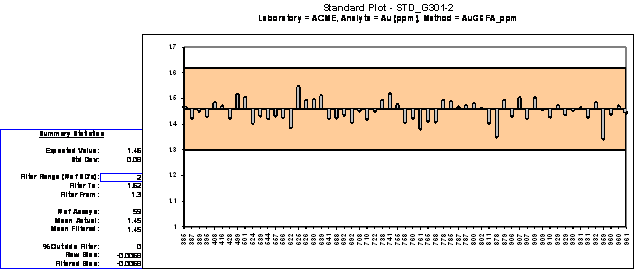
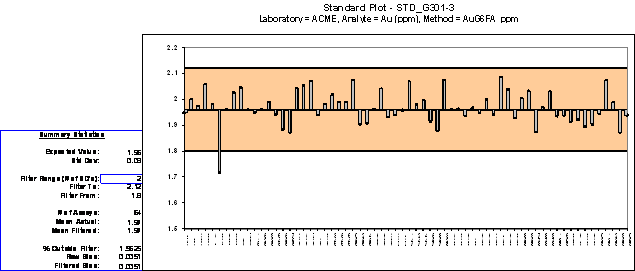
 | Technical Report (NI 43-101) – December 31st 2009 Exeter Resource Corporation
Cerro Moro Gold-Silver Project, Santa Cruz Province Argentina |
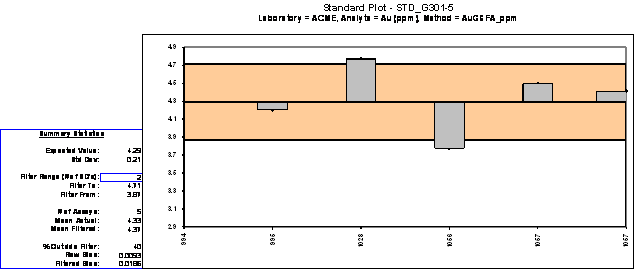
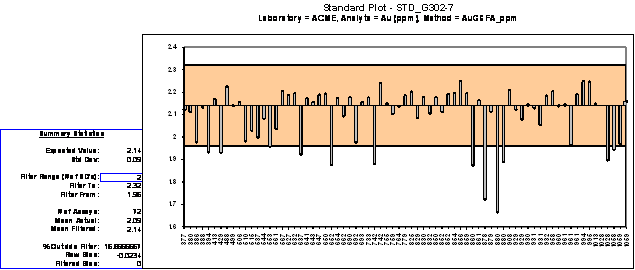

 | Technical Report (NI 43-101) – December 31st 2009 Exeter Resource Corporation
Cerro Moro Gold-Silver Project, Santa Cruz Province Argentina |
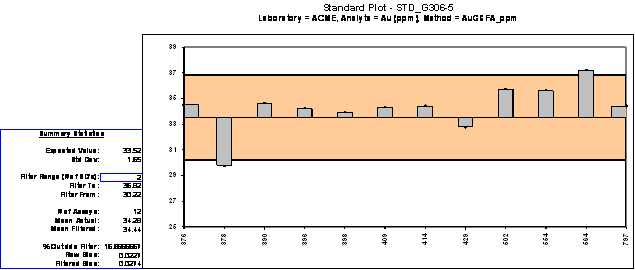
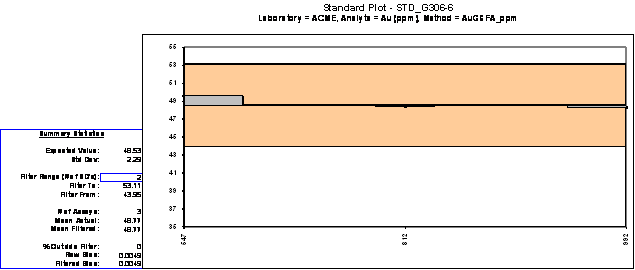
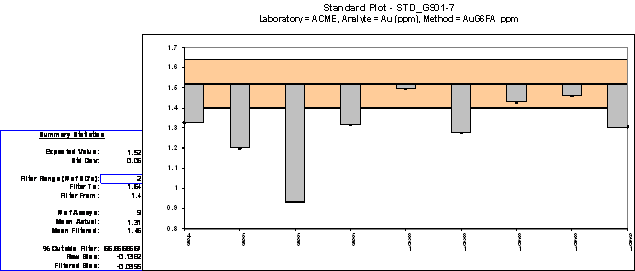
 | Technical Report (NI 43-101) – December 31st 2009 Exeter Resource Corporation
Cerro Moro Gold-Silver Project, Santa Cruz Province Argentina |
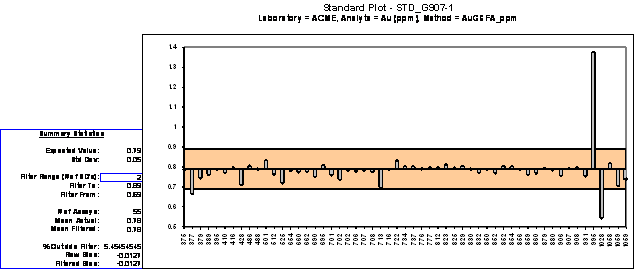

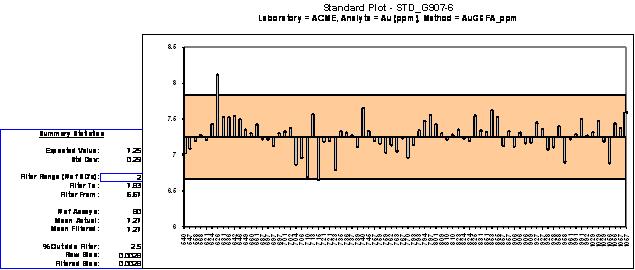
 | Technical Report (NI 43-101) – December 31st 2009 Exeter Resource Corporation
Cerro Moro Gold-Silver Project, Santa Cruz Province Argentina |
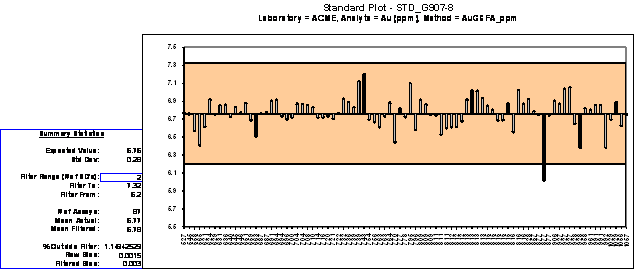
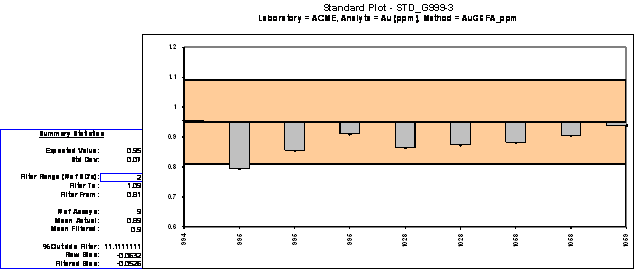
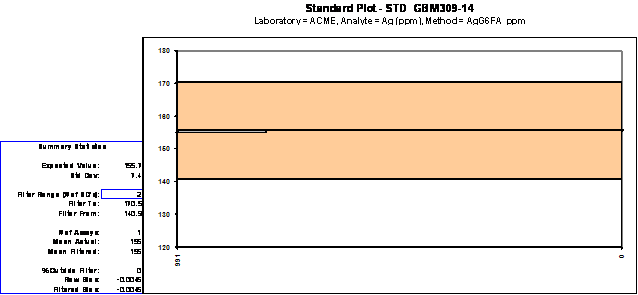
 | Technical Report (NI 43-101) – December 31st 2009 Exeter Resource Corporation
Cerro Moro Gold-Silver Project, Santa Cruz Province Argentina |
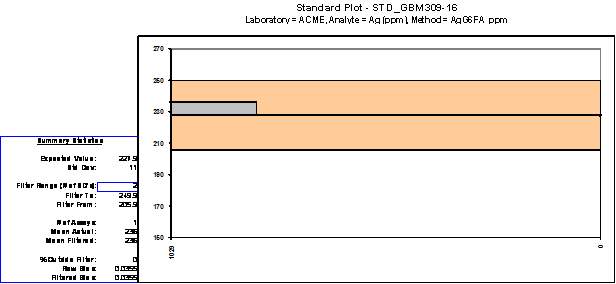
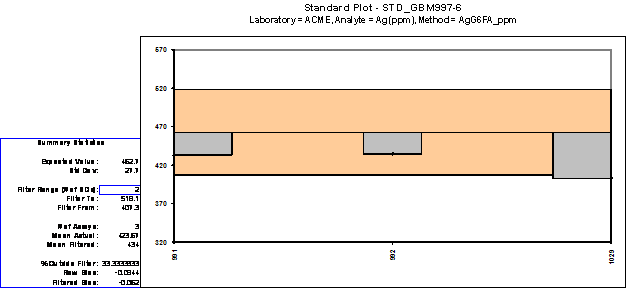

 | Technical Report (NI 43-101) – December 31st 2009 Exeter Resource Corporation
Cerro Moro Gold-Silver Project, Santa Cruz Province Argentina |
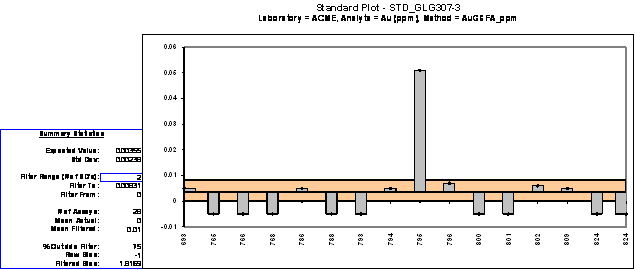
 | Technical Report (NI 43-101) – December 31st 2009 Exeter Resource Corporation
Cerro Moro Gold-Silver Project, Santa Cruz Province Argentina |
APPENDIX 3. Graphical Logs of the Twin Holes |
 | Technical Report (NI 43-101) – December 31st 2009 Exeter Resource Corporation
Cerro Moro Gold-Silver Project, Santa Cruz Province Argentina |
